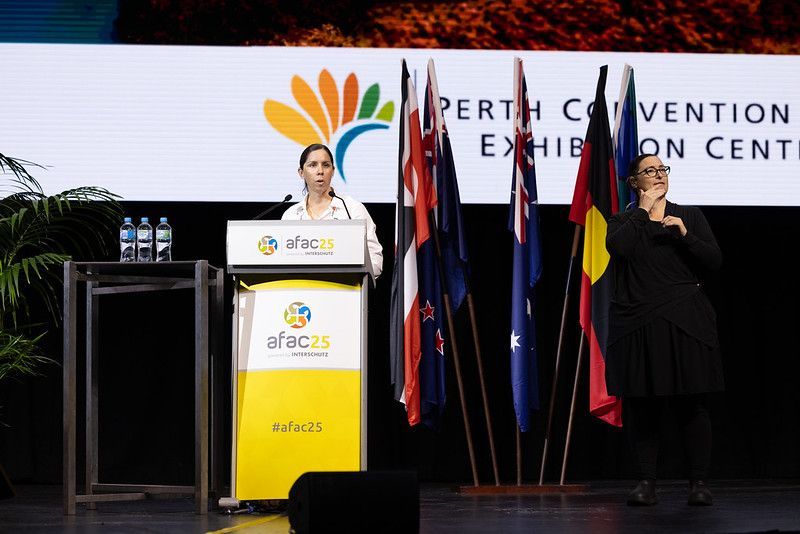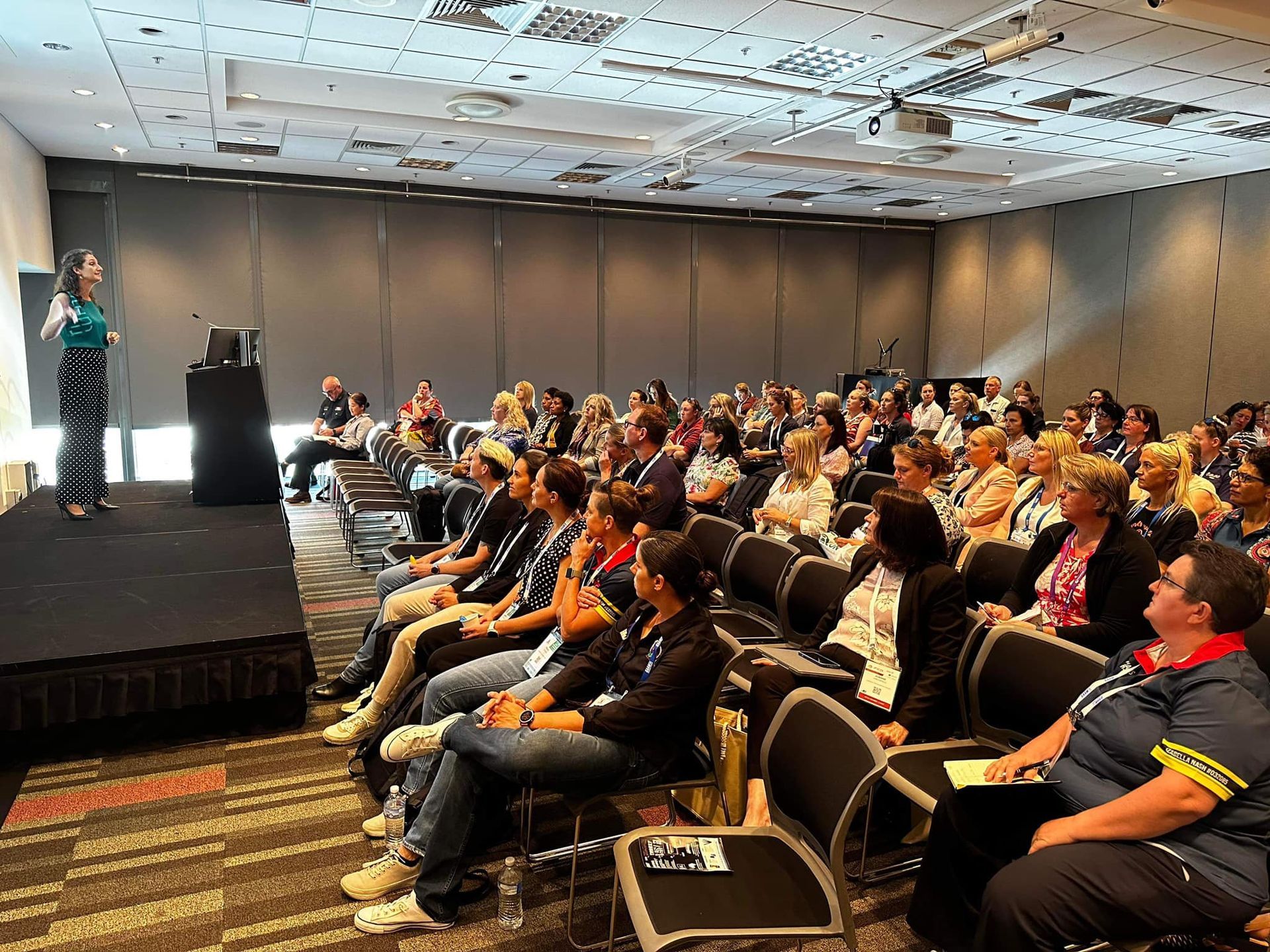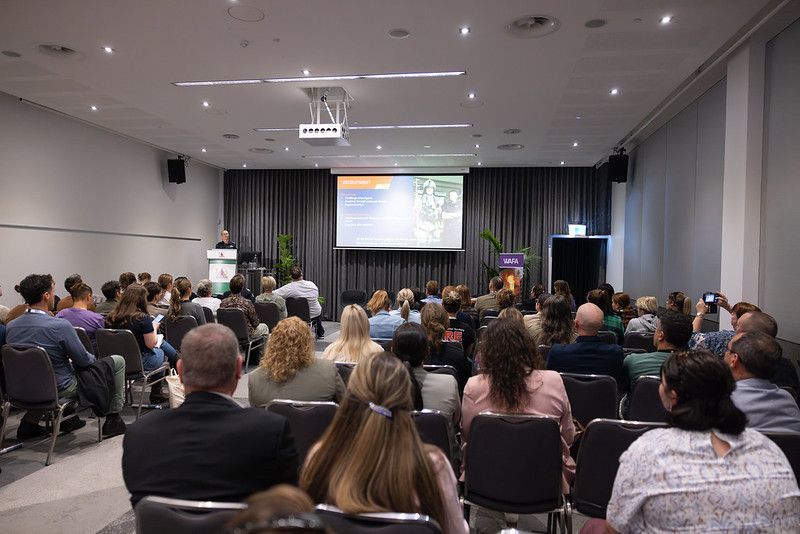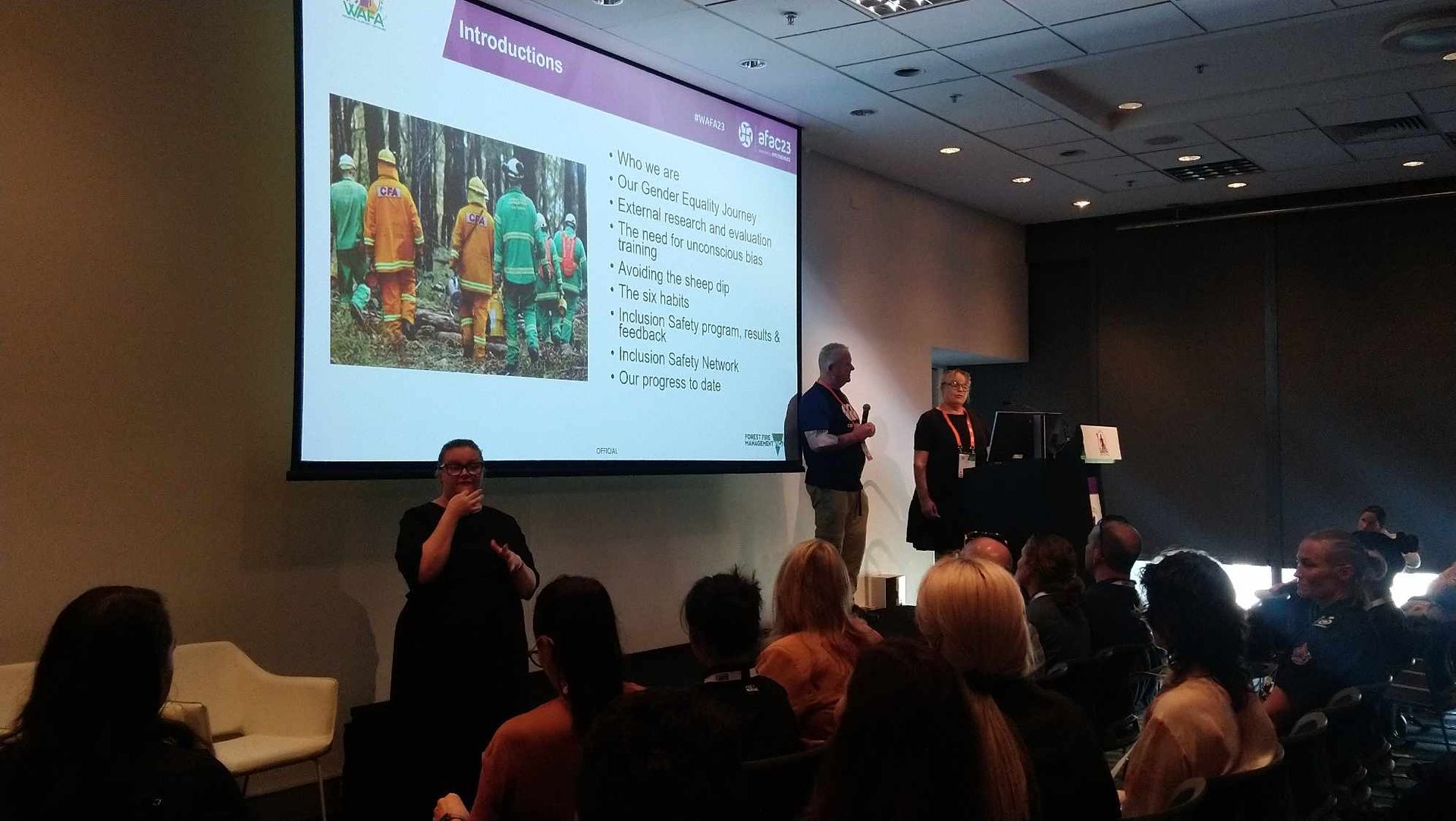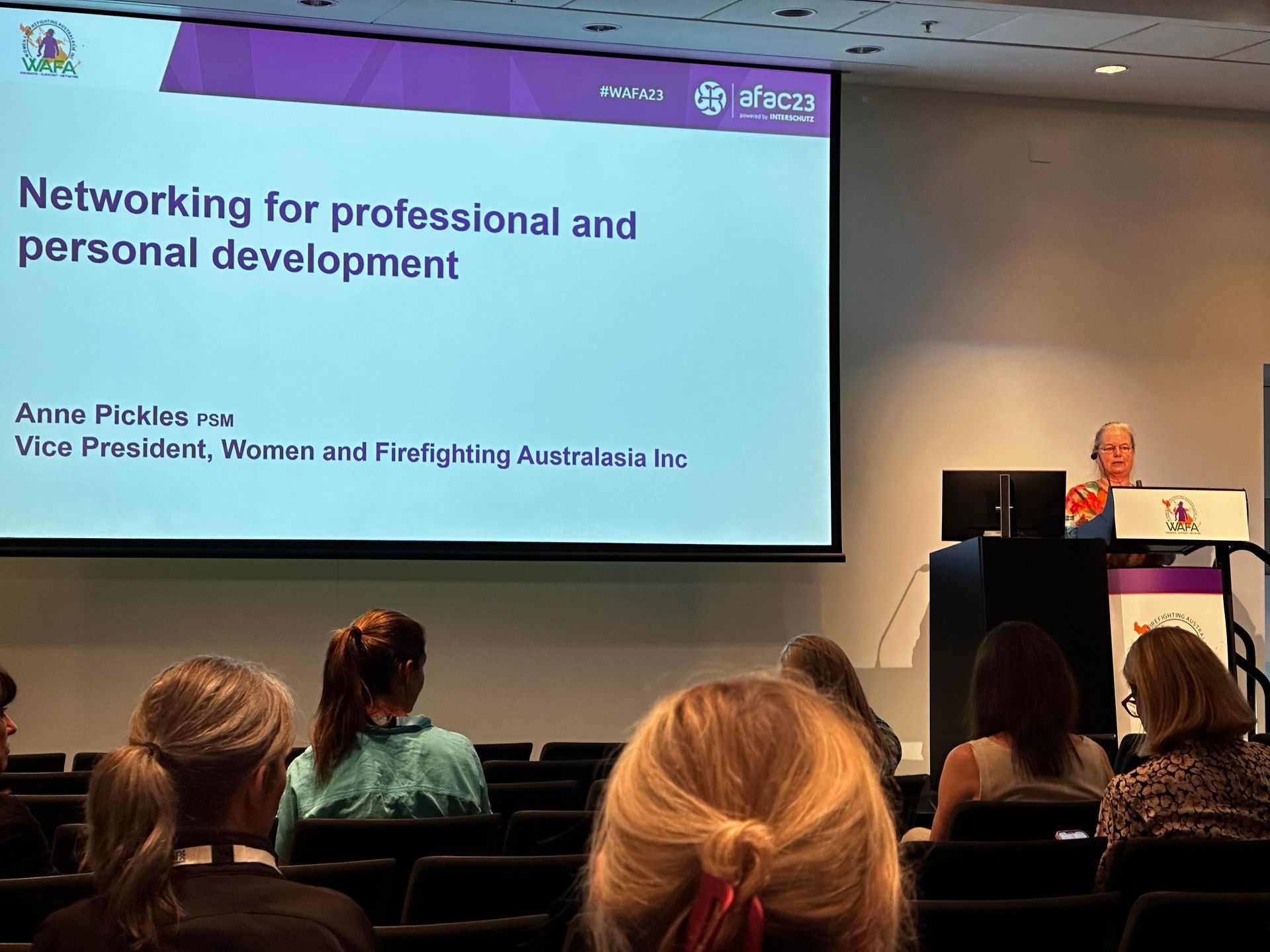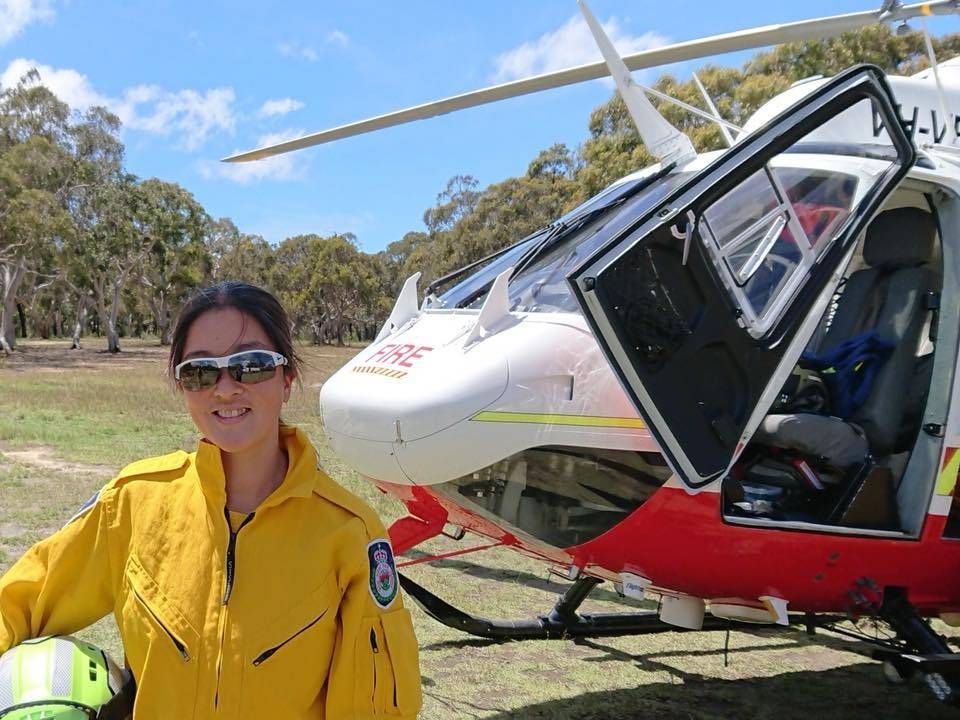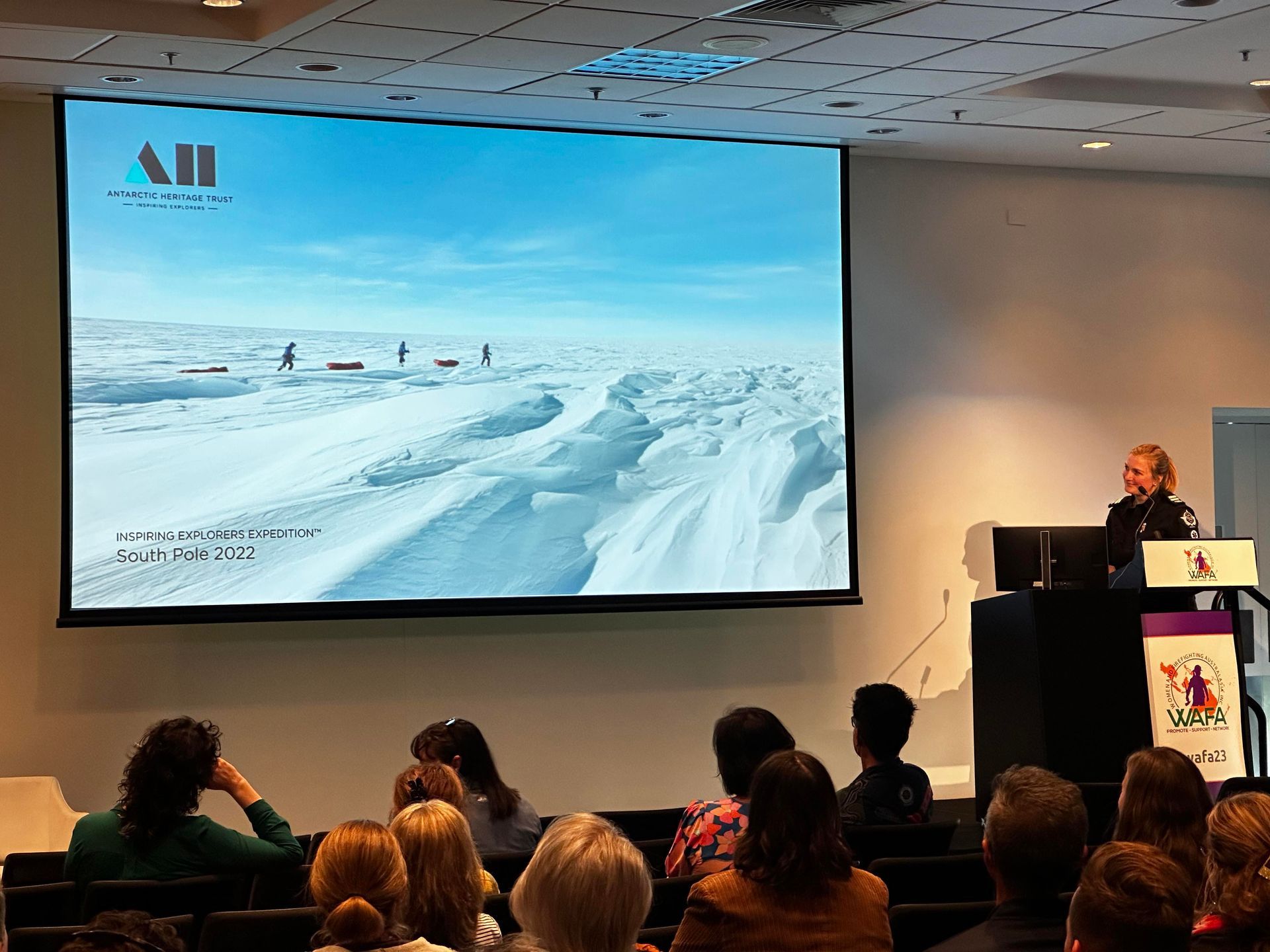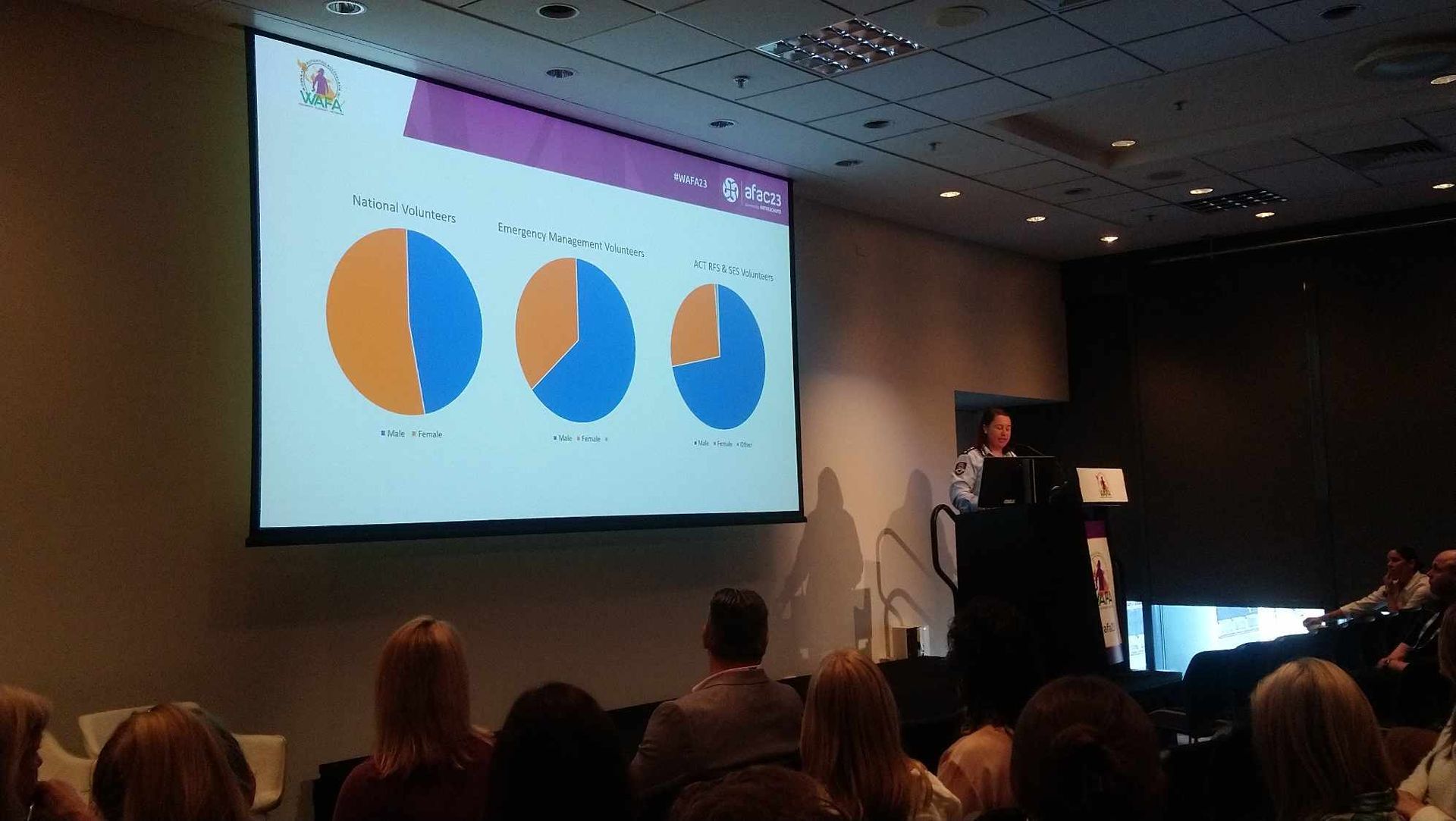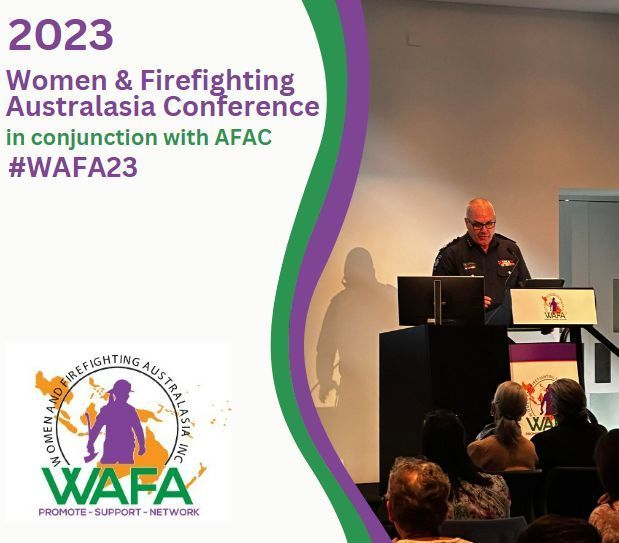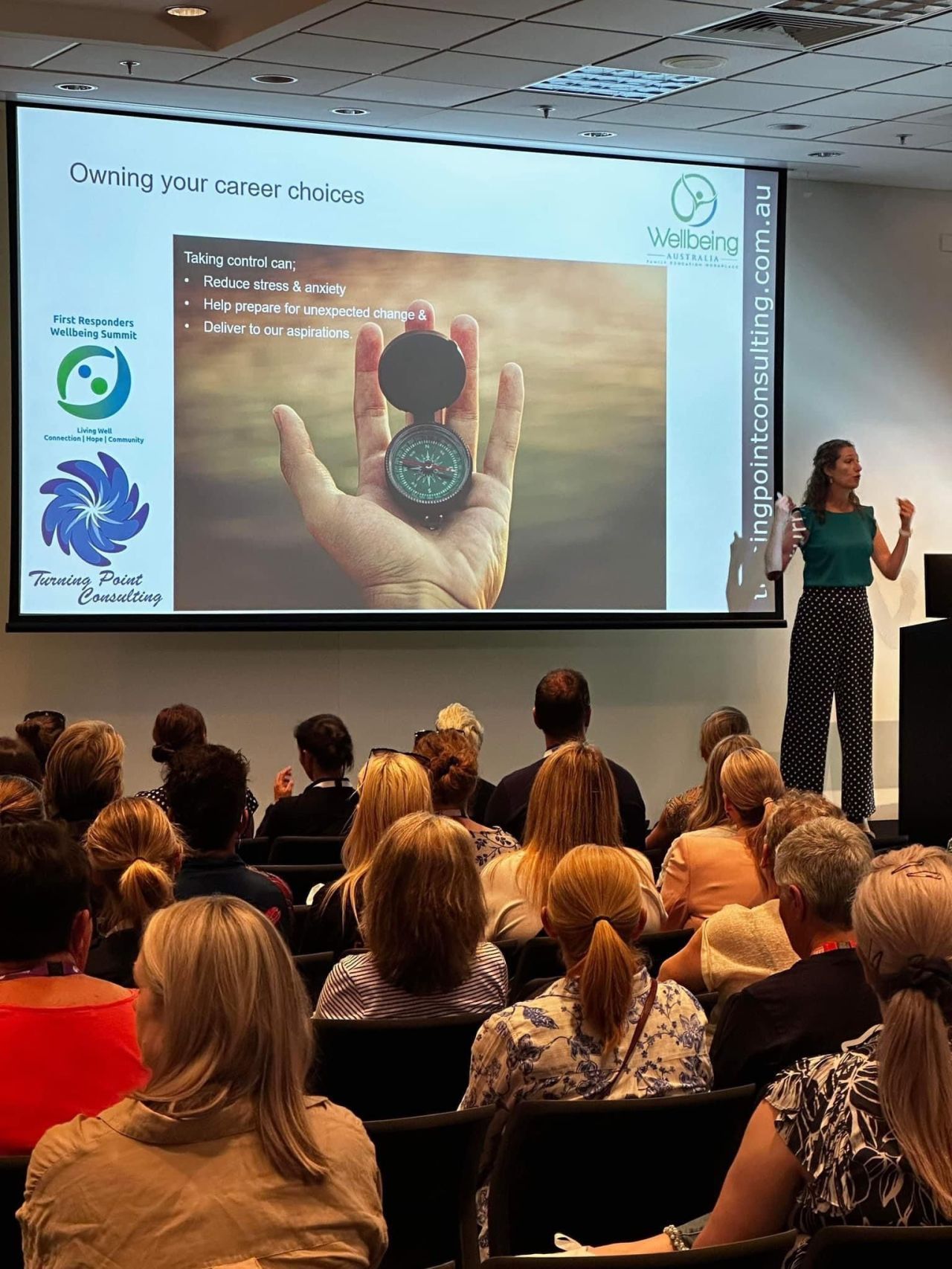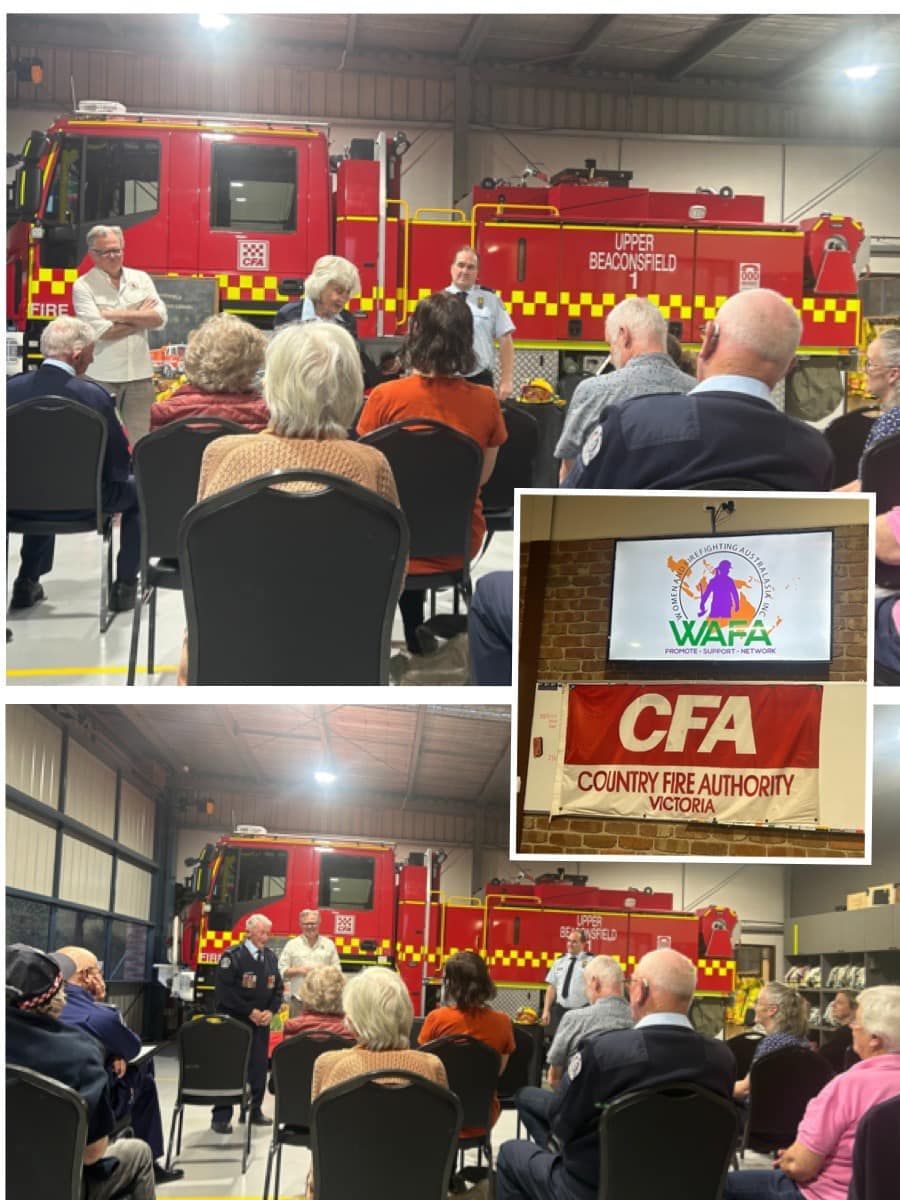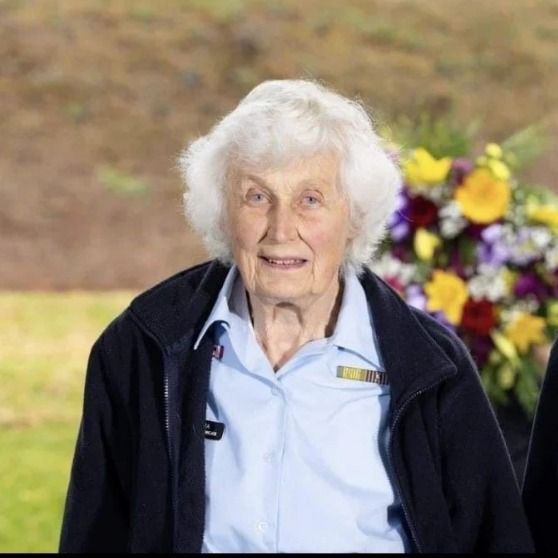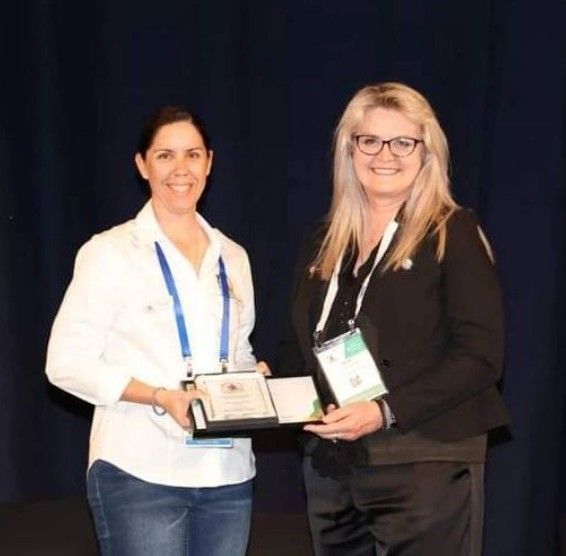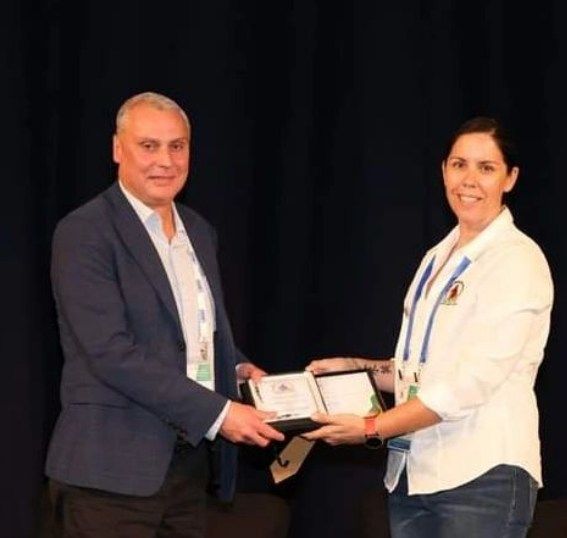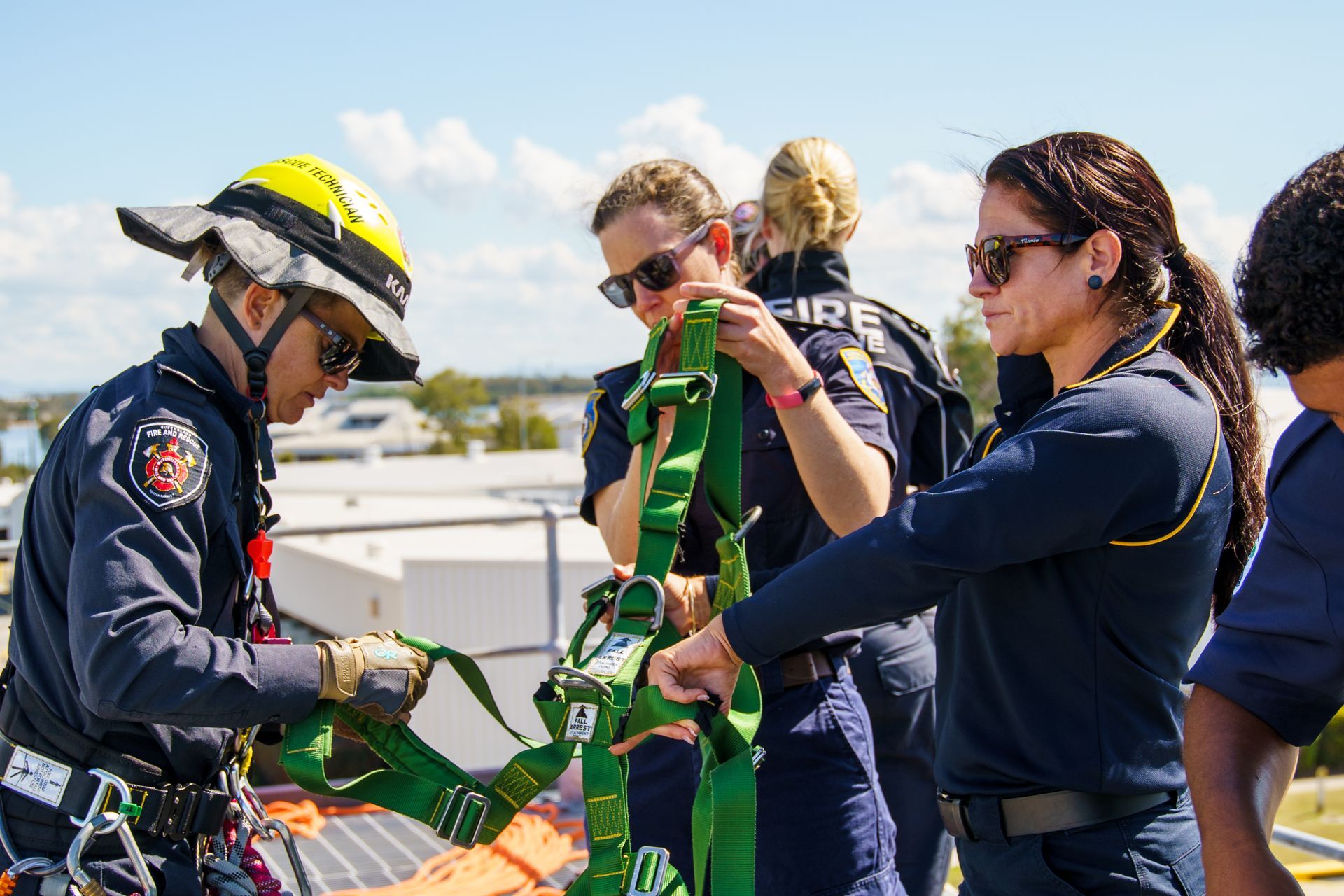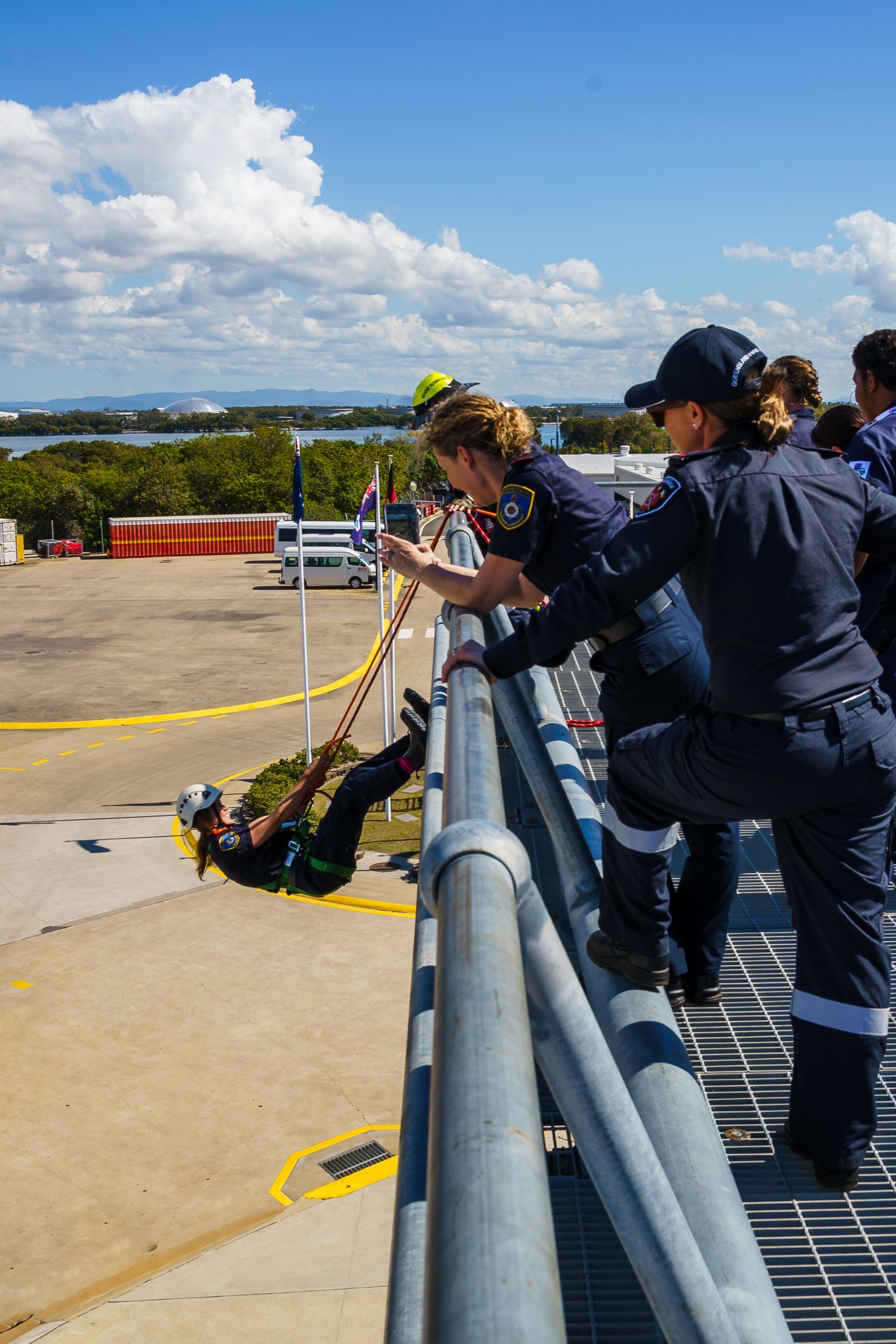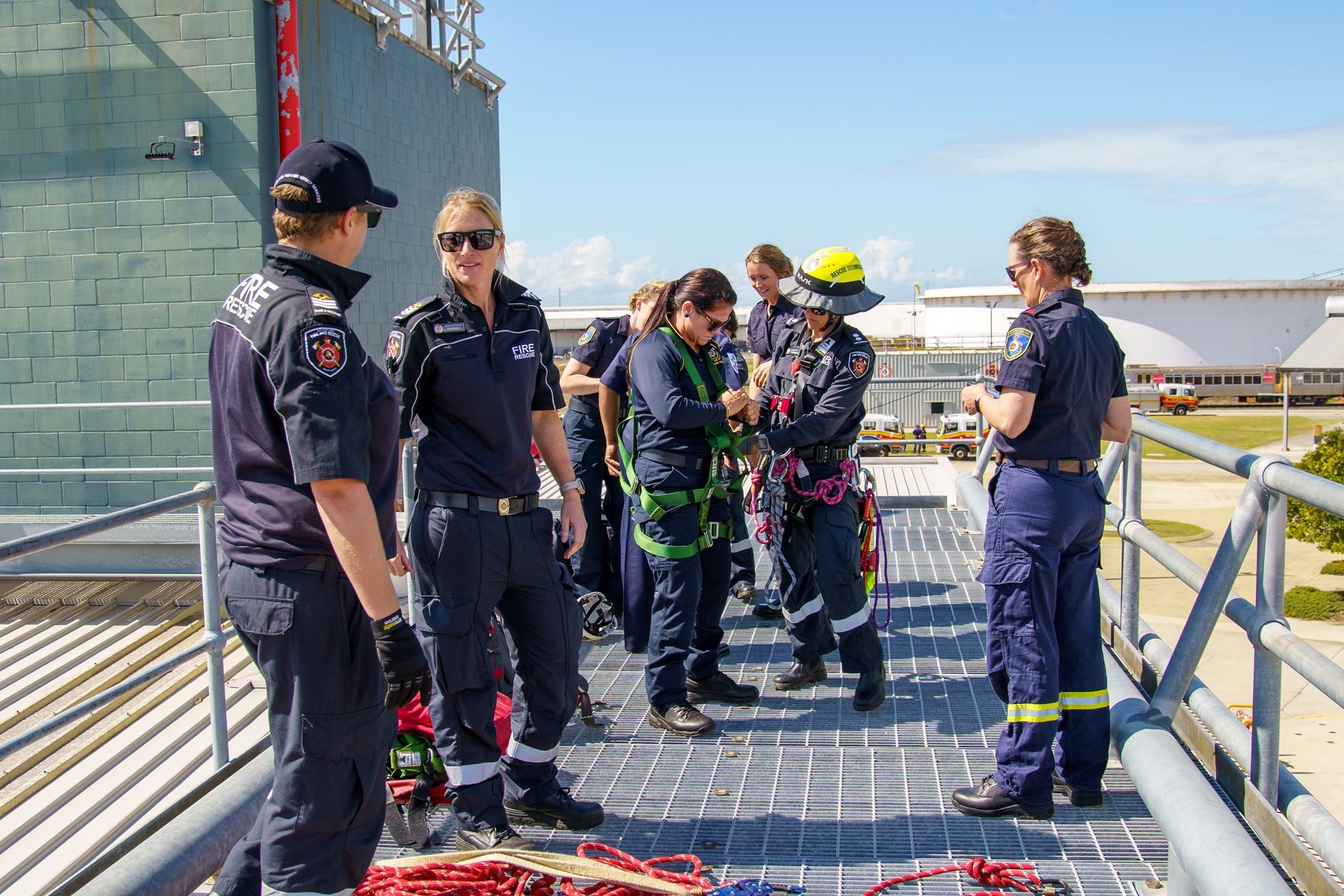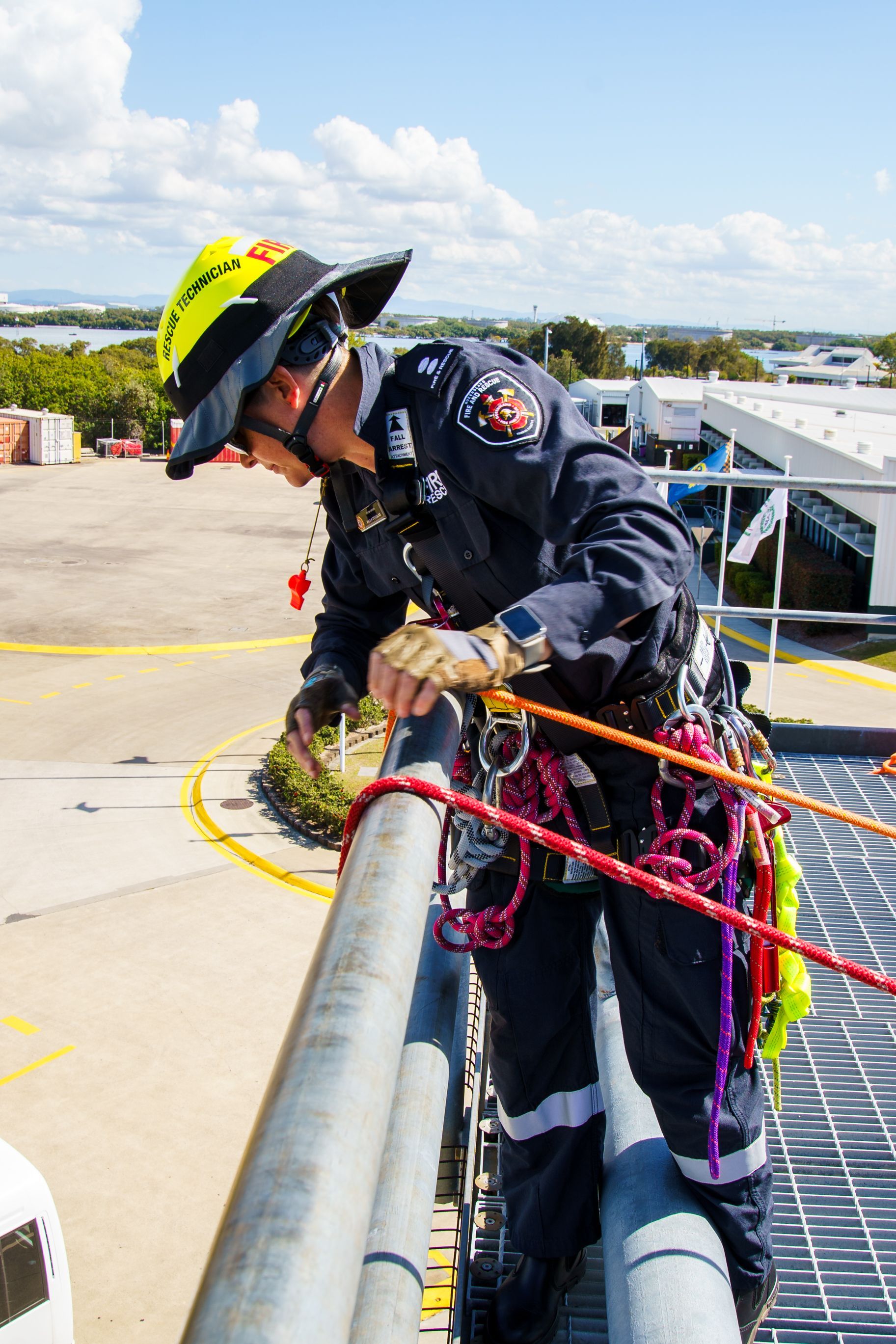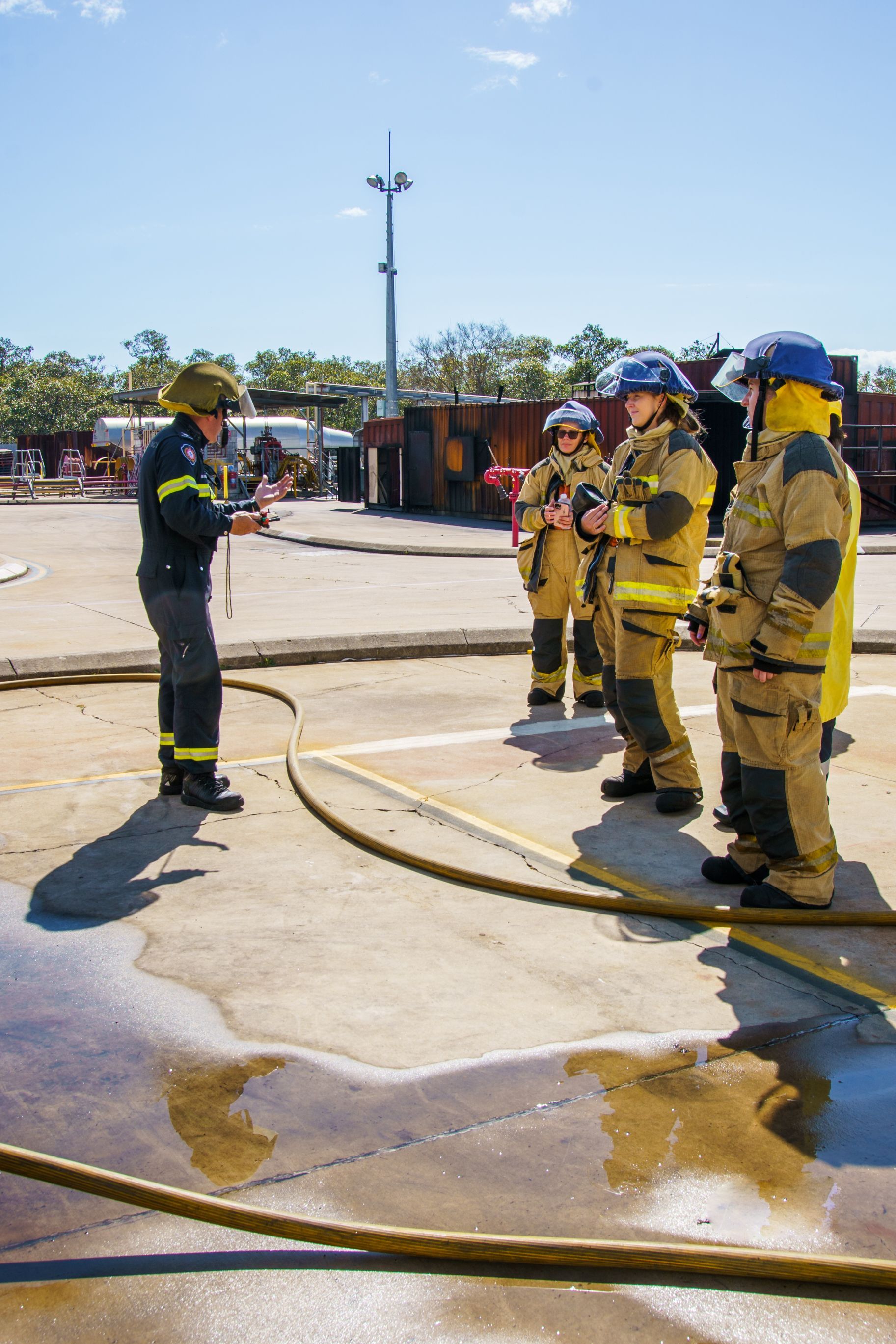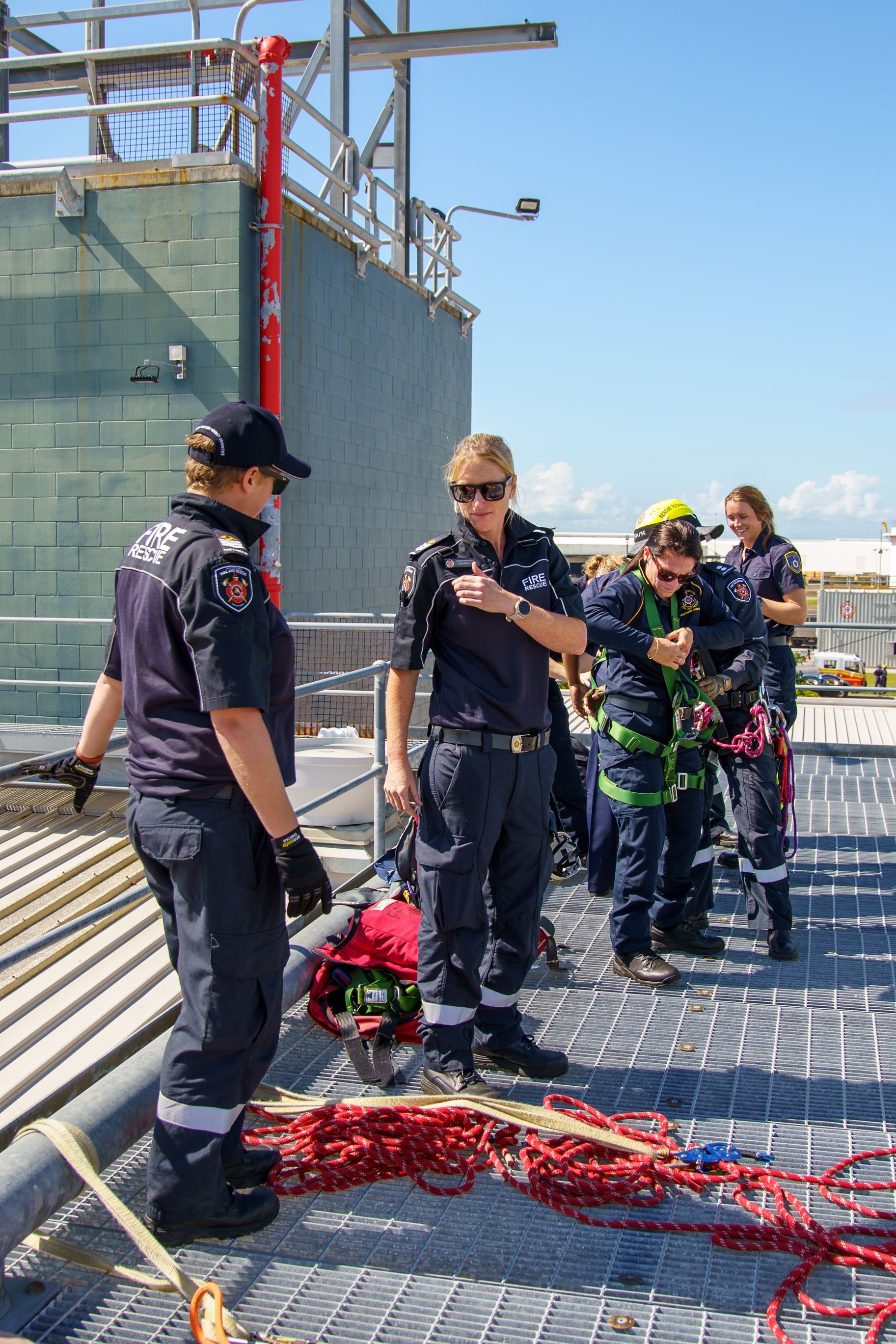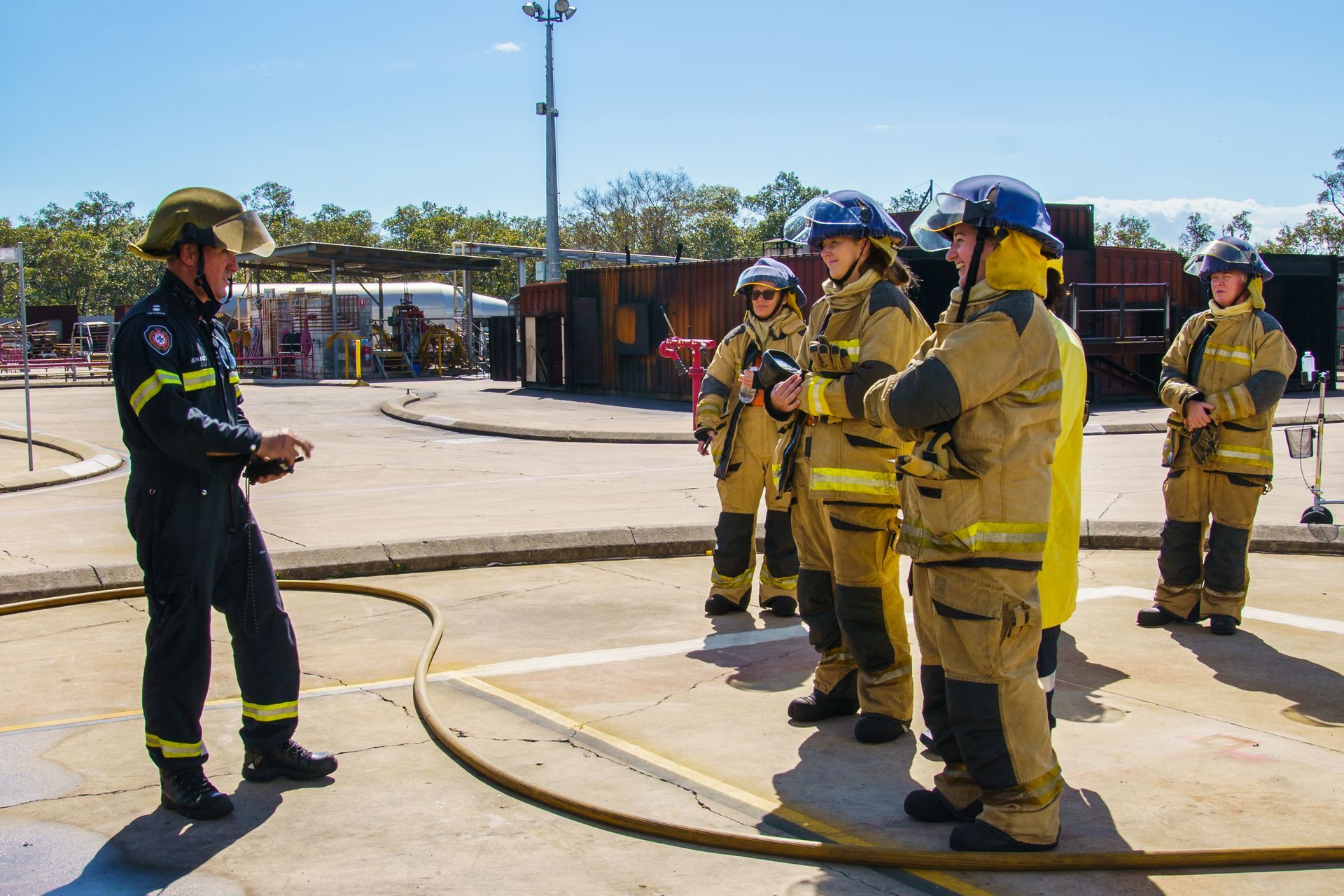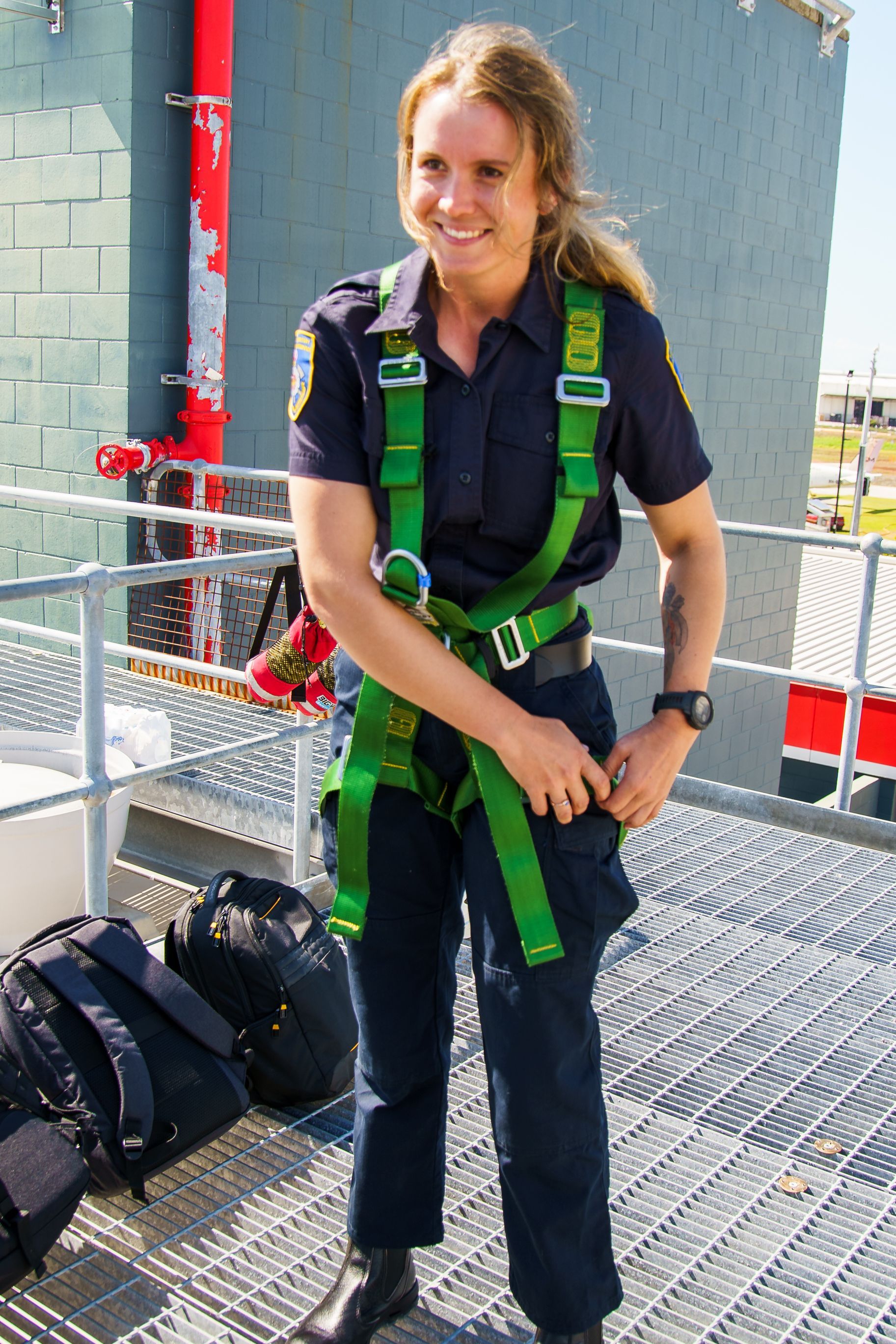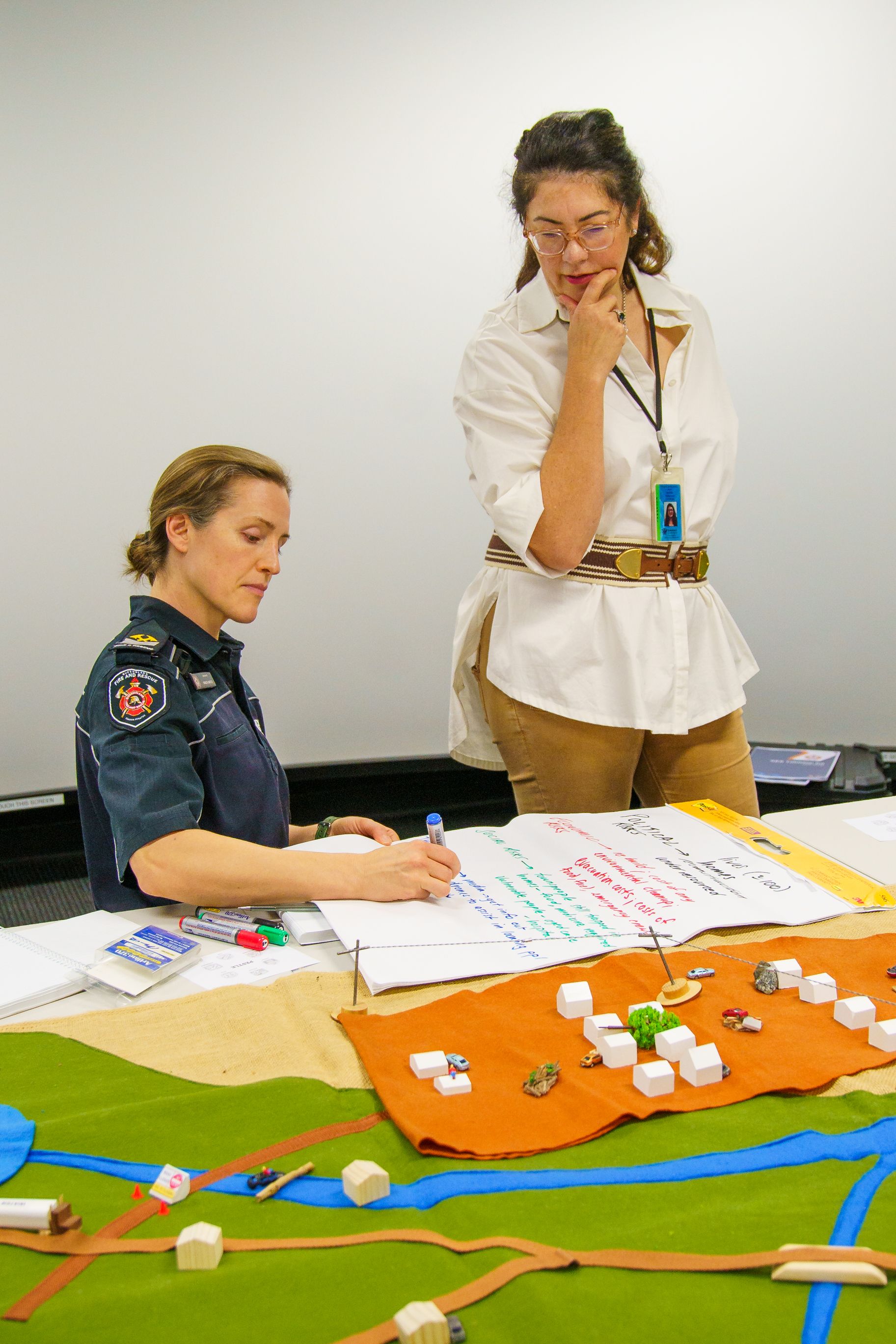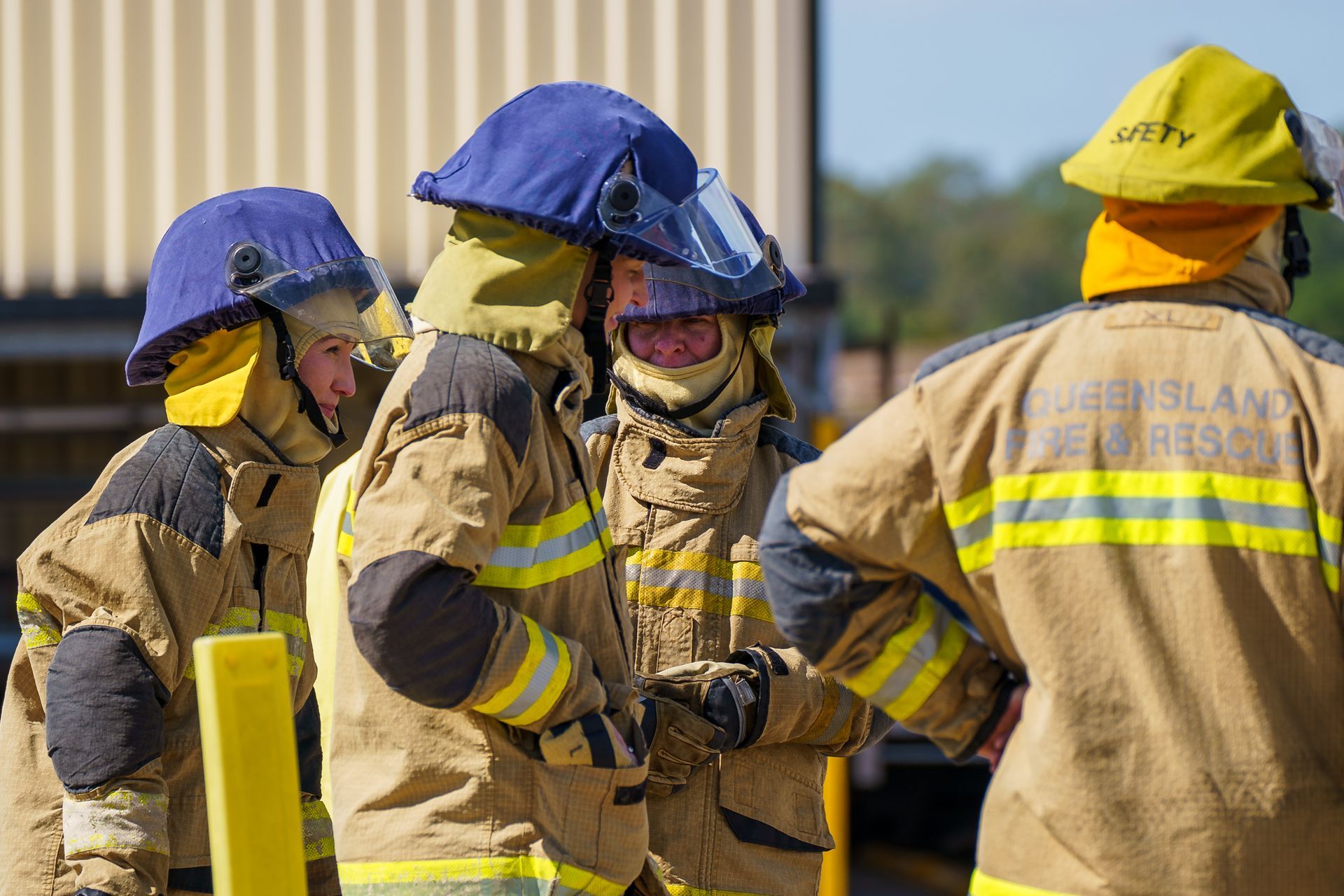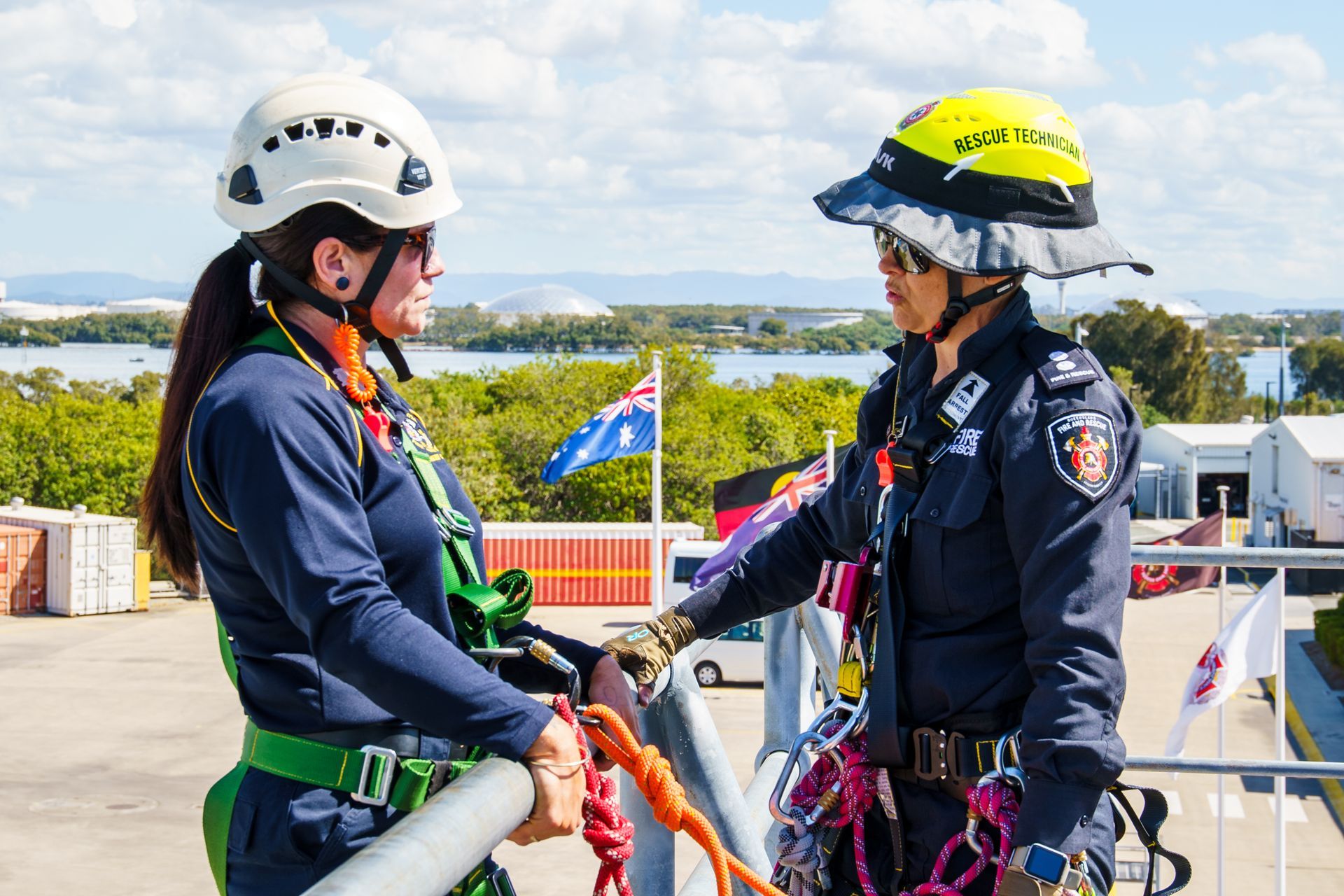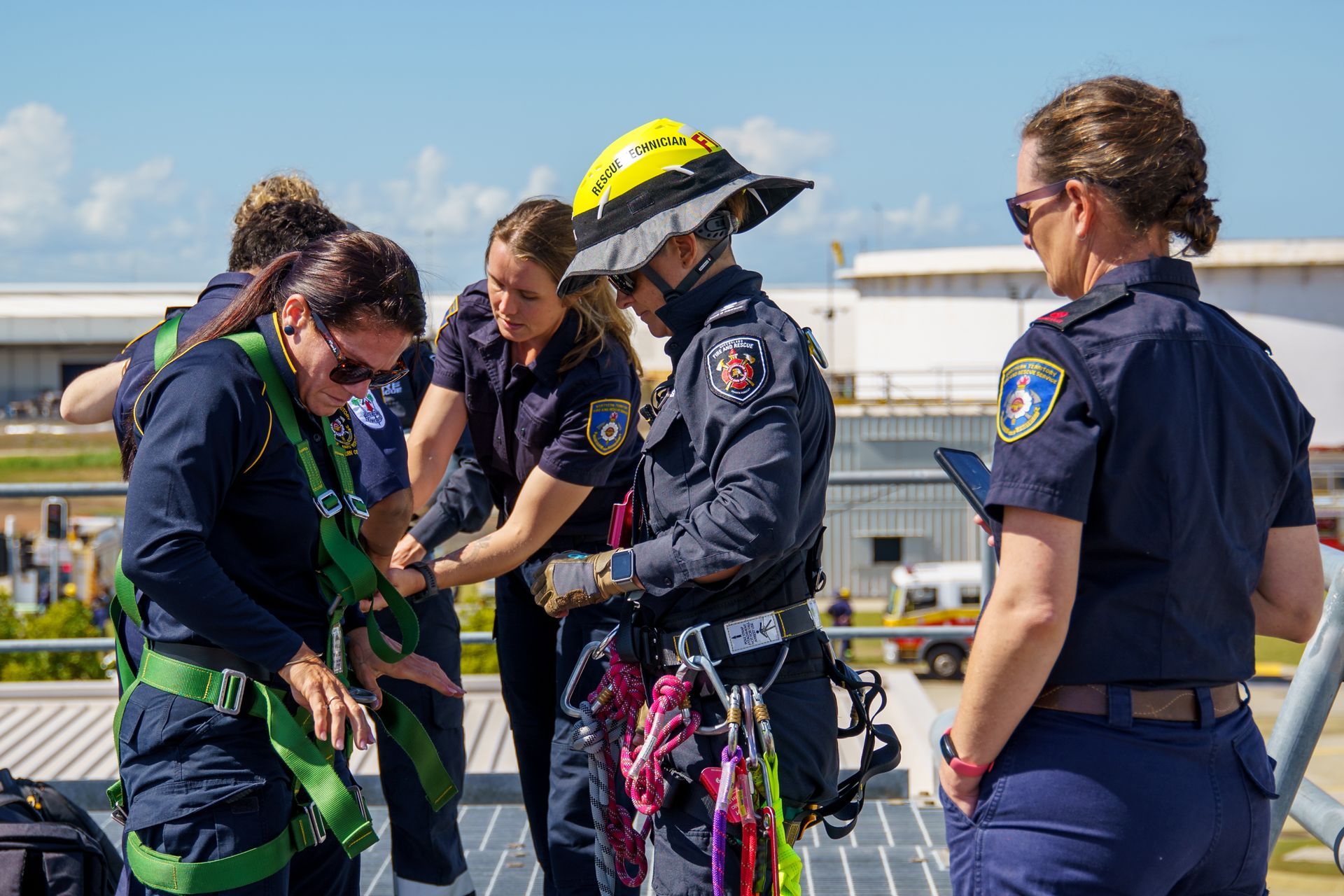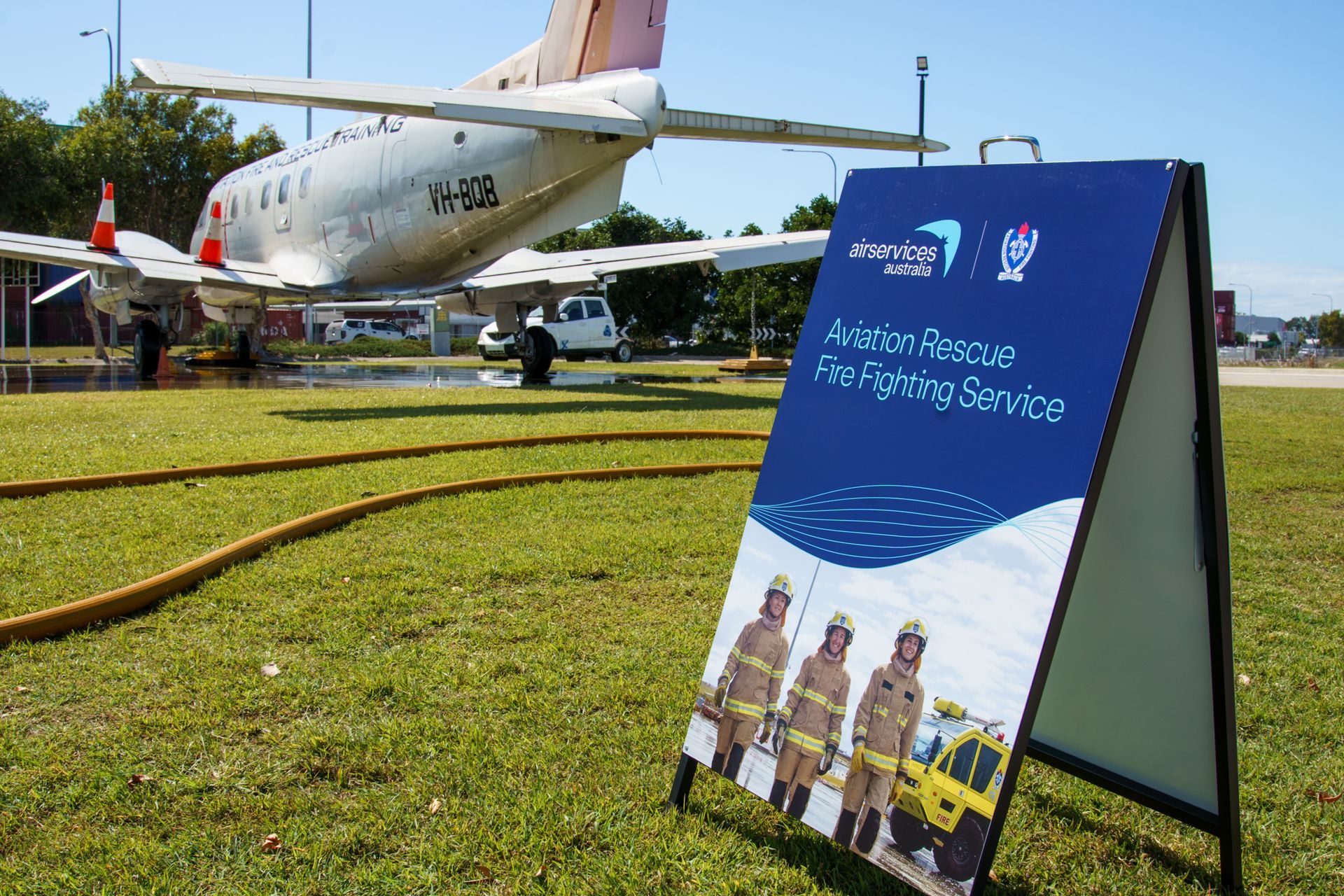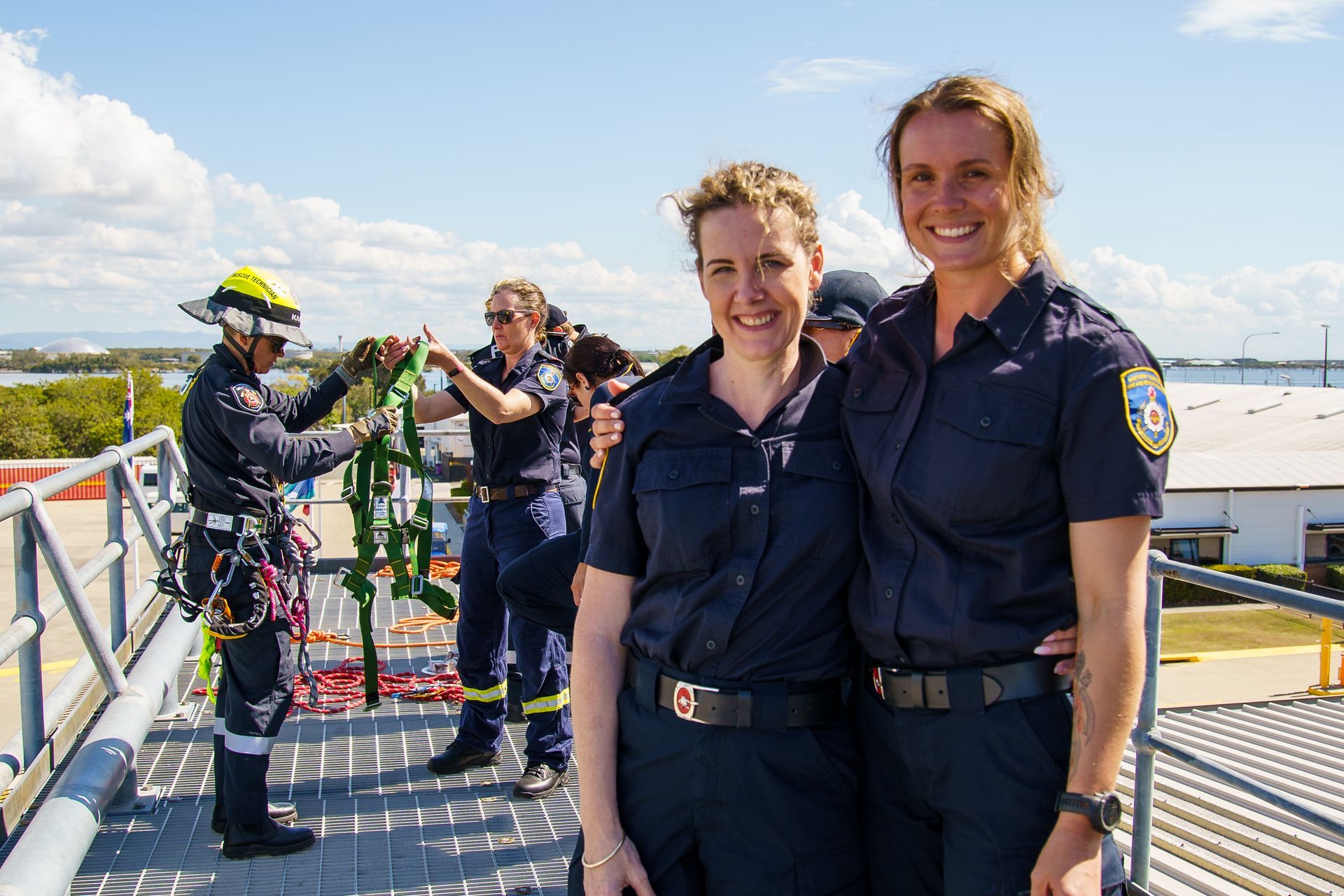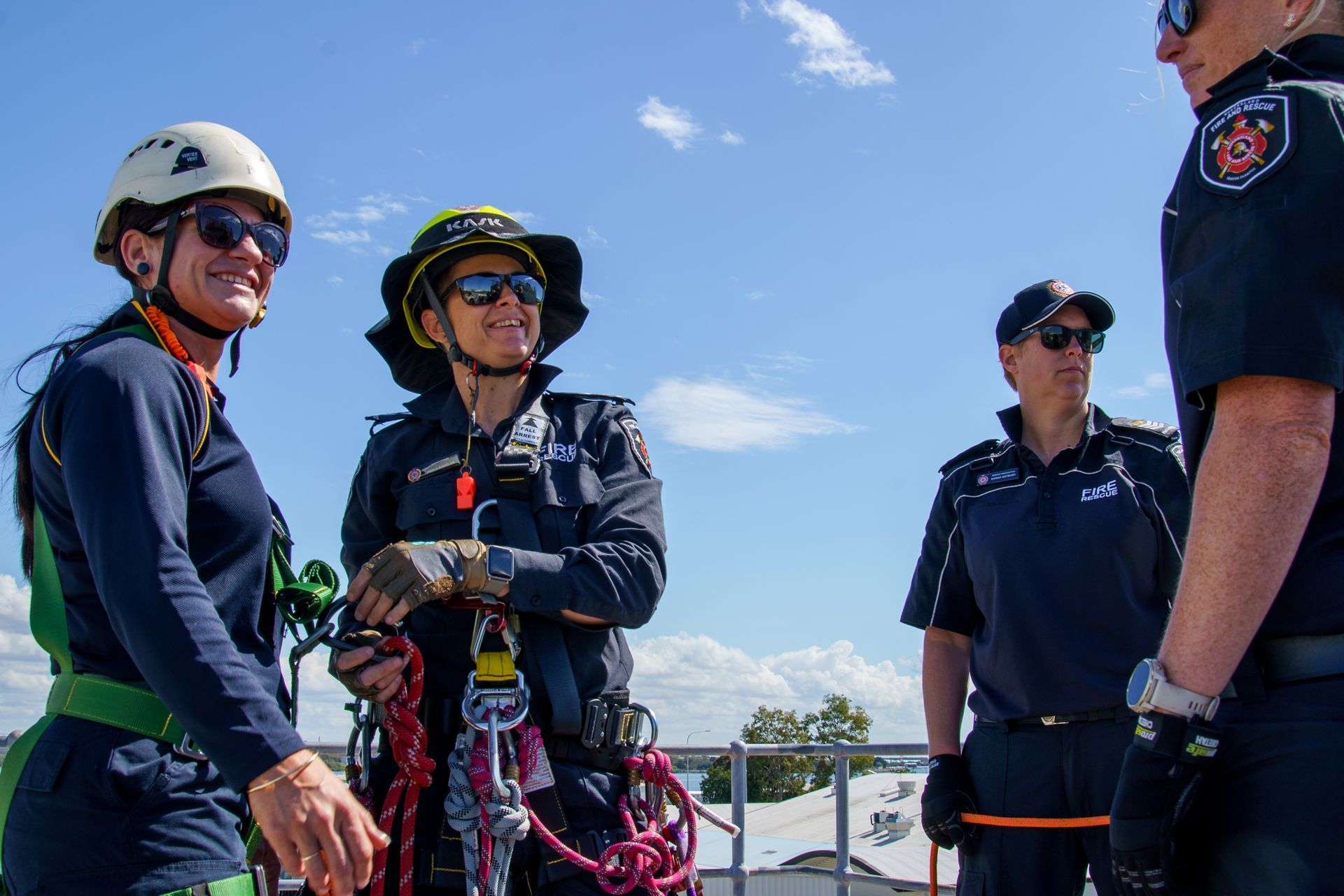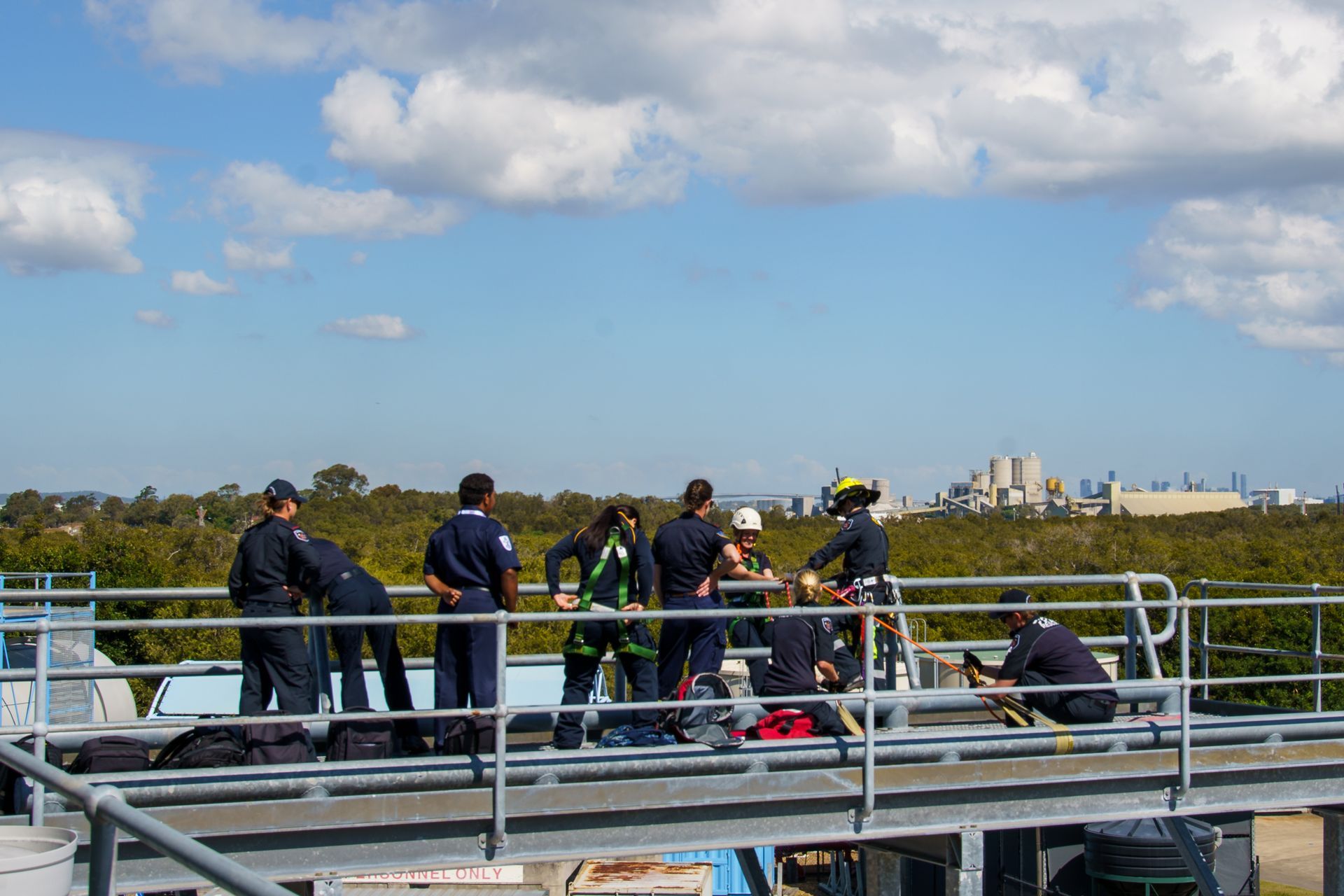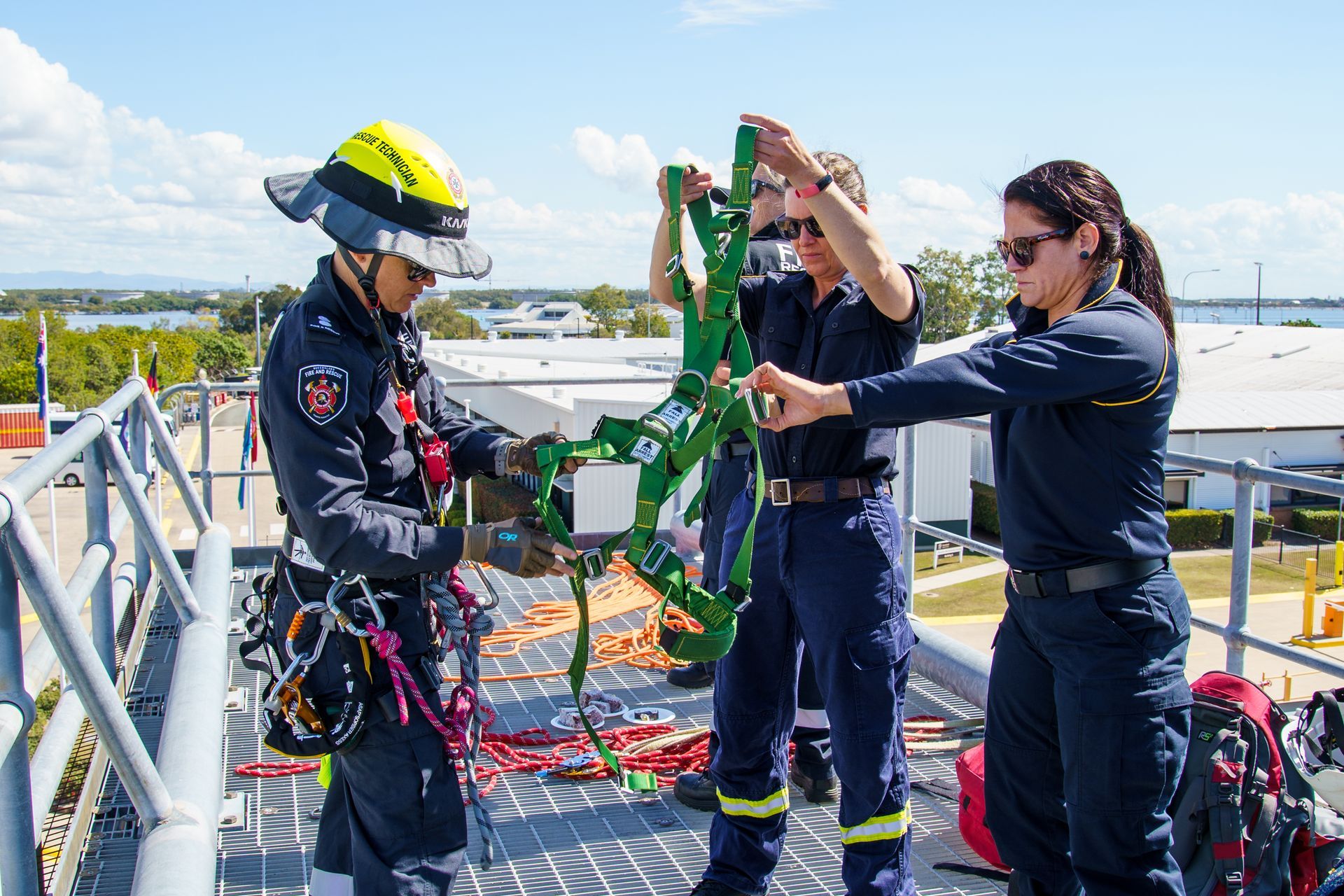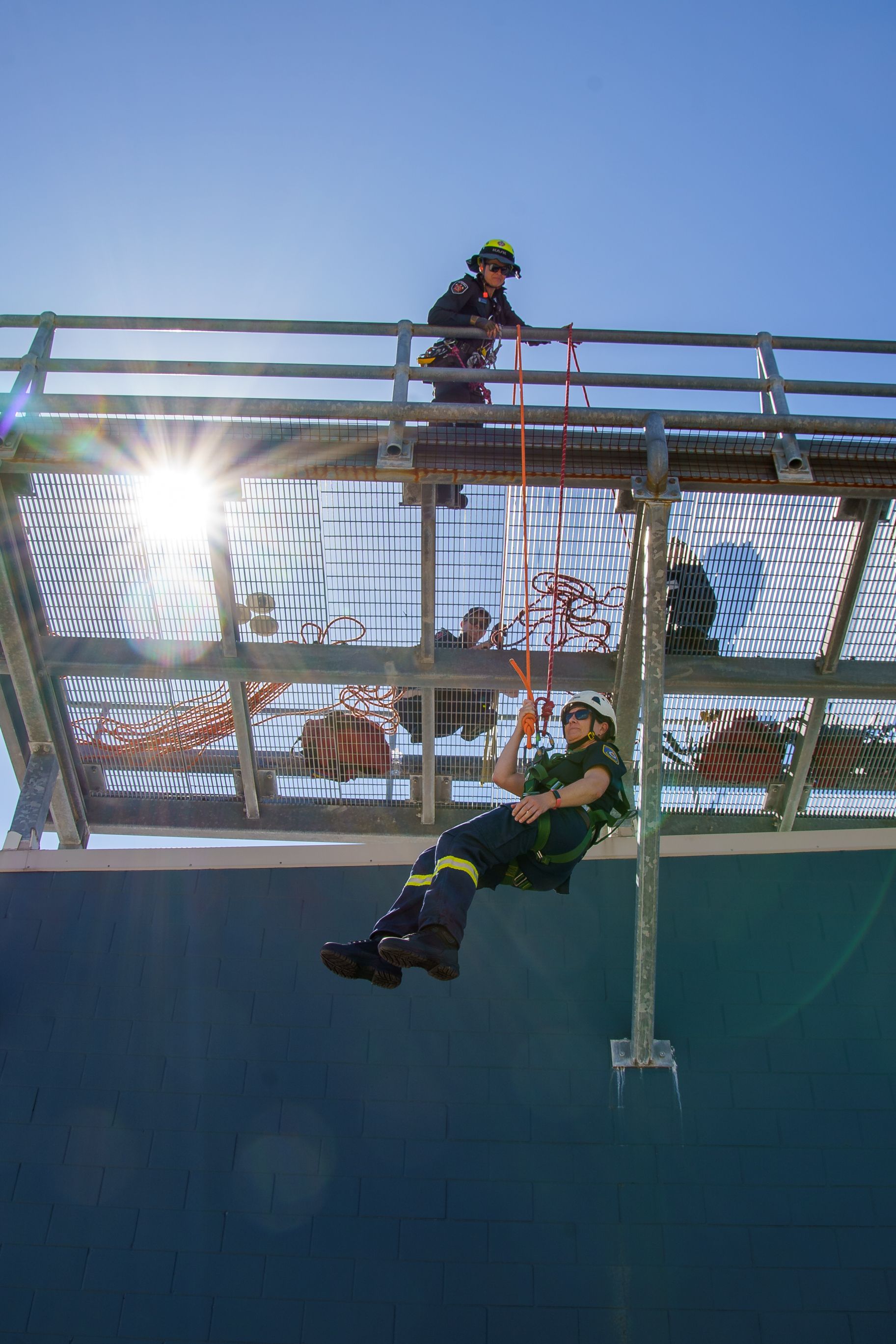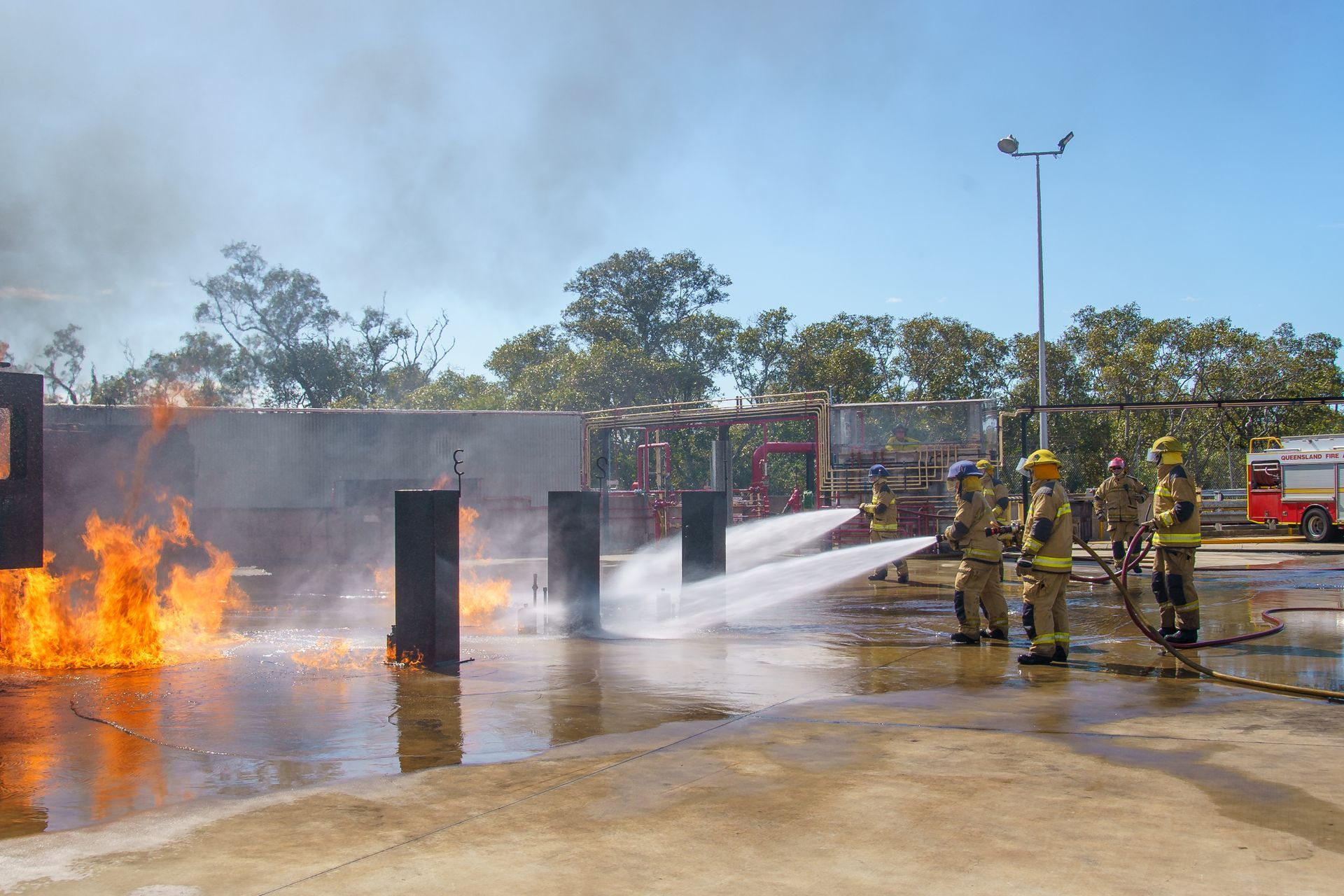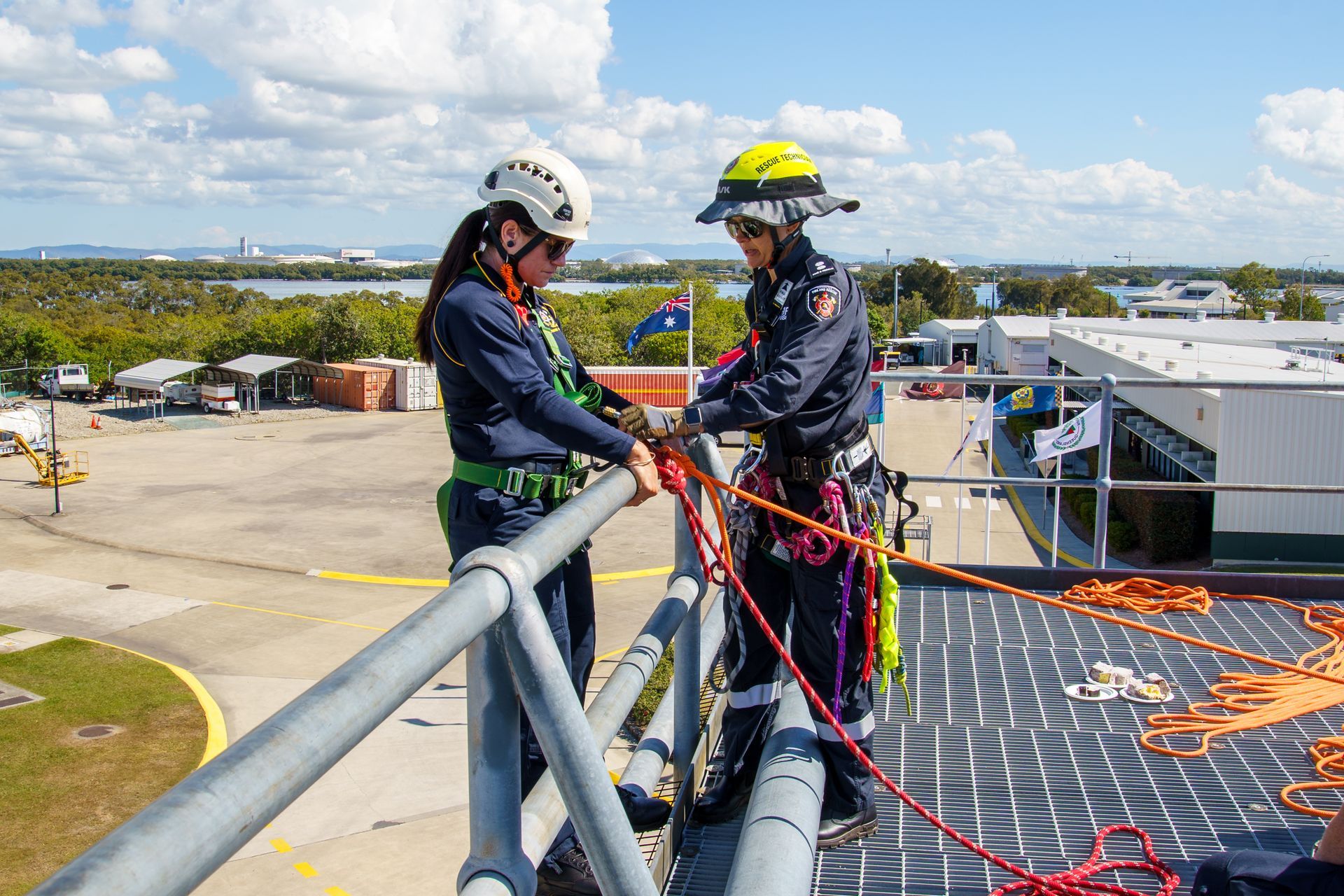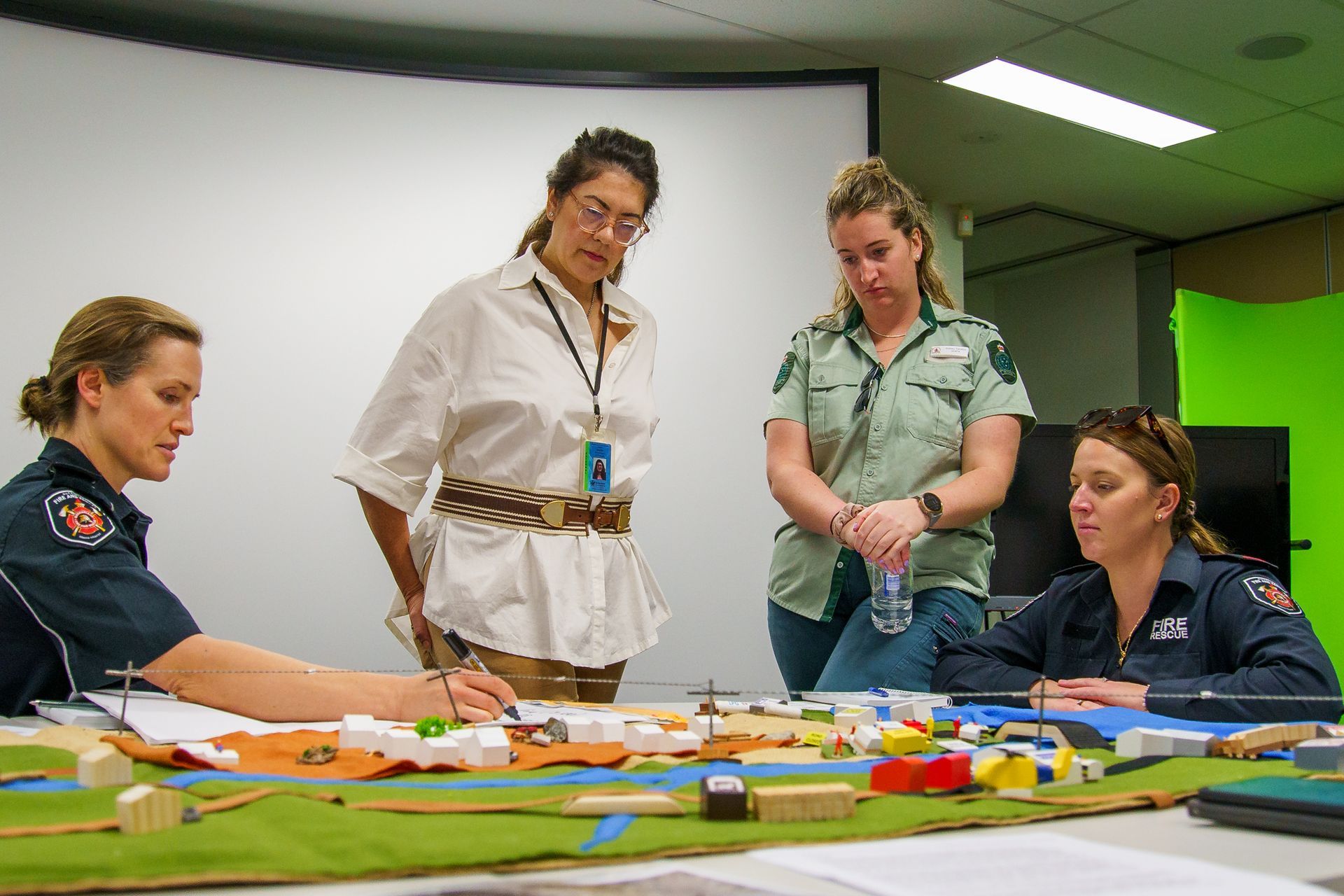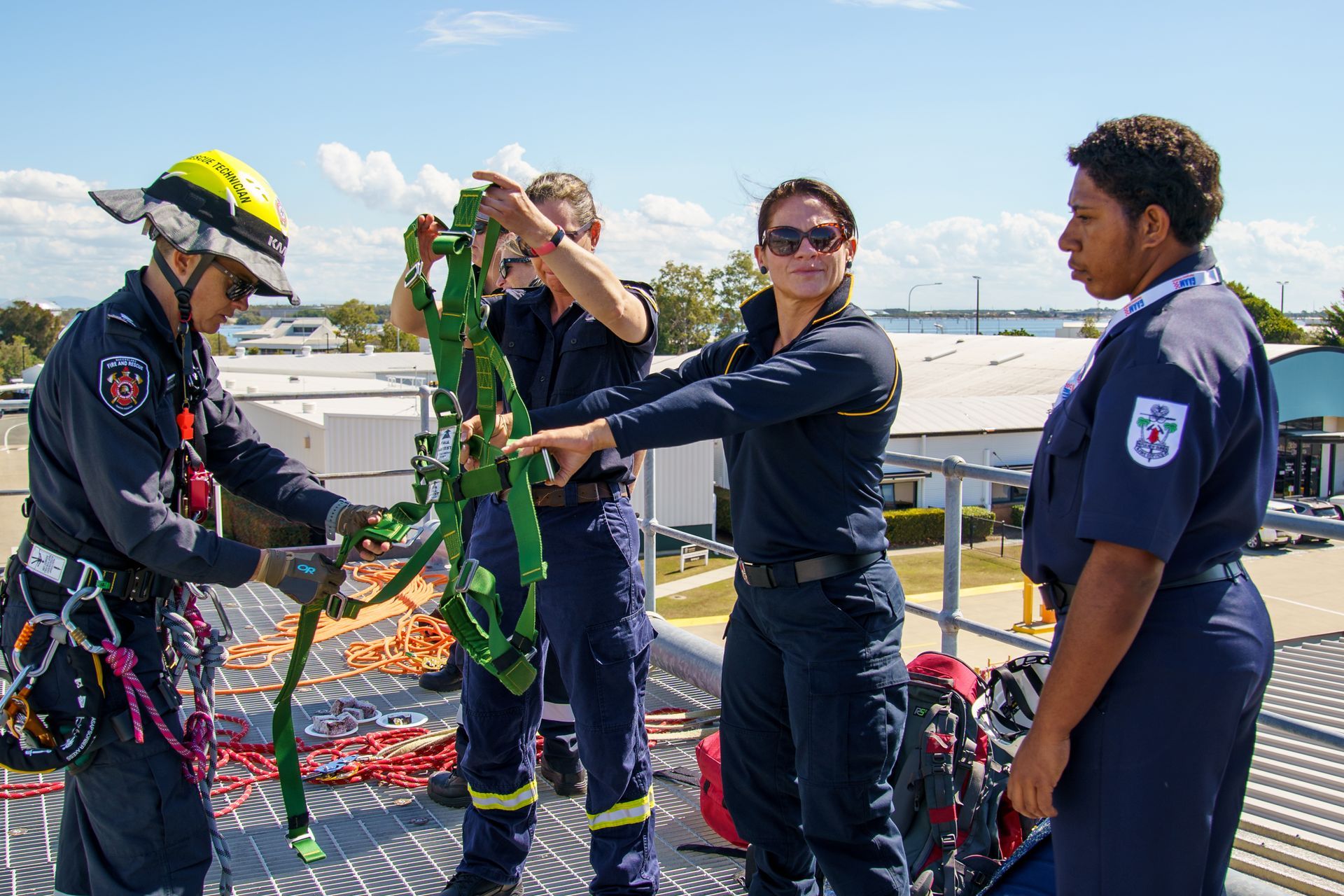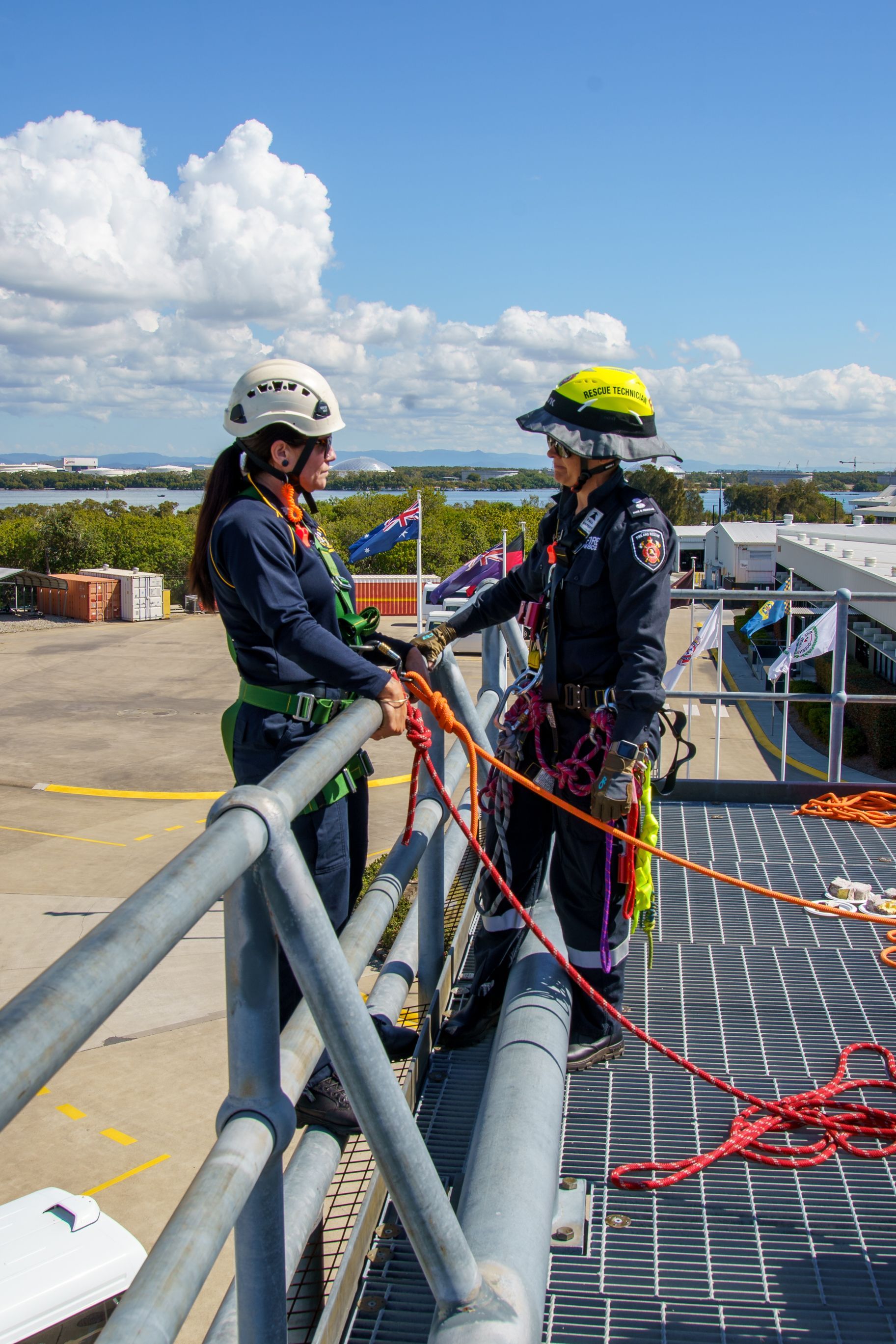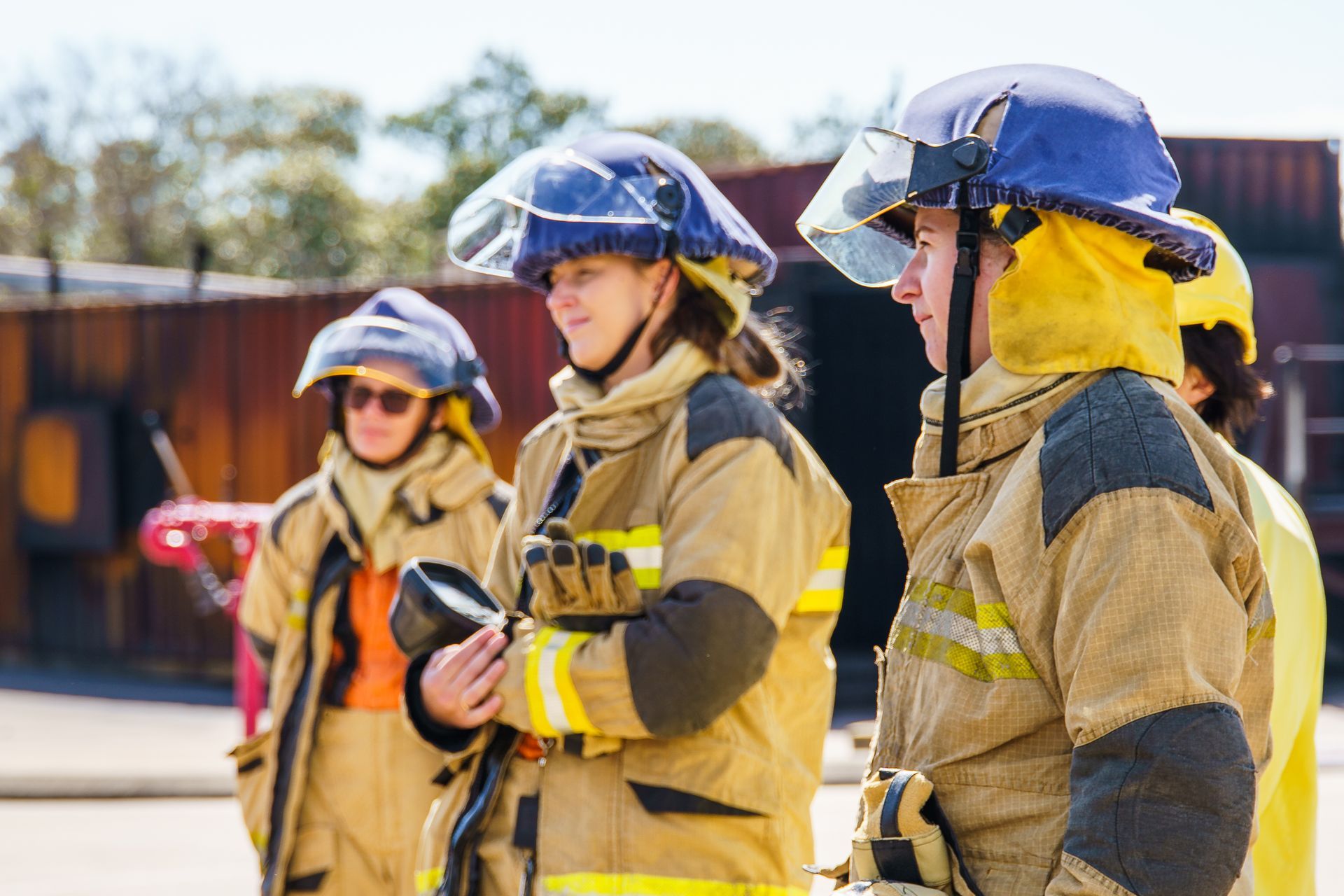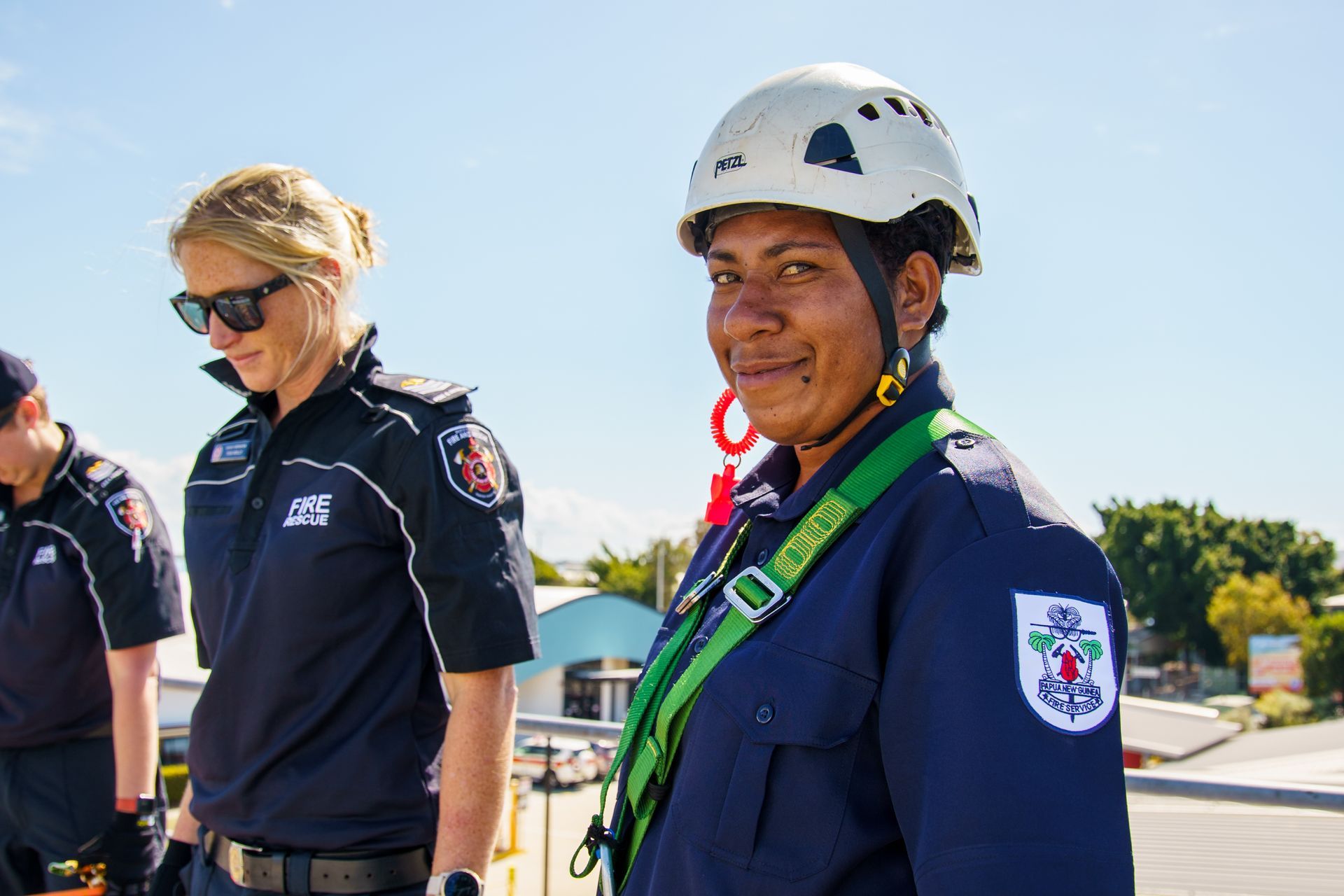co-located with AFAC
WAFA CONFERENCES
WAFA Conferences:
Connect, learn, lead.
Be part of the WAFA crew.
WAFAs biennial conferences bring together delegates from across Australasia — including women firefighters, women working in broader emergency services, and supportive male colleagues. These conferences provide opportunities to take part in practical workshops, hear from expert speakers, access mentoring and career advice, and most importantly, build strong relationships and networks across fire and emergency services.
Keen to get involved in a future WAFA conference? There are plenty of ways to be part of the action — from submitting an abstract or suggesting keynote presenters, to volunteering on the exhibition stand or helping in breakout rooms. Whatever your skills or interests, there’s an opportunity to contribute. Let us know if you’d like to be part of the WAFA crew!
Perth 2025
The WAFA 2025 Conference in Perth — If not now, then when: a call to action on safety, inclusion and respect — brought together delegates from across Australasia to showcase the diverse contributions of women in every part of the fire and emergency sector. From frontline firefighting to community risk reduction, from emergency management and administration to organisational development, participants shared knowledge, built networks, and strengthened the call for safer, more inclusive and respectful workplaces.
Brisbane 2023
WAFA was proud to partner with AFAC23 powered by INTERSCHUTZ to deliver our 2023 Conference in Brisbane. With the theme Sustaining Diversity, the program explored how to support and empower women to advance their careers, increase representation across all levels of the sector, and build safe, inclusive workplaces. Hosted by Queensland Fire and Emergency Services and Queensland Parks and Wildlife Services, the conference highlighted the critical role of diversity in meeting the challenges and opportunities of a changing emergency management landscape.
Virtual 2021
In 2021, with the ongoing impacts of the Covid-19 pandemic, WAFA partnered with AFAC to deliver our conference online. We hosted a virtual booth in the exhibition hall and featured on the exhibition stage, ensuring our community could still connect, share and be part of the conversation.
2023 Conference Speaker Library
-
Alison McLeod
ADDRESSING GENDER IMBALANCE IN EMERGENCY SERVICE VOLUNTEERING: A VOLUNTEER MANAGEMENT PERSPECTIVE
This paper considers the unique role that volunteer managers undertake within the diverse ecosystem of volunteering, with a particular emphasis on the gender imbalance within the Australian Capital (ACT) volunteering emergency service volunteering Services – the ACT Rural Fire Service (ACTRFS), and the ACT State Emergency Service (ACTSES), collectively known as the ‘Services’.
The National Volunteer Strategy, authored by Volunteering Australia in 2023, highlights the work that needs to be done to create a diverse and inclusive volunteering ecosystem, therefore effective volunteer management requires understanding the importance of diversity and inclusion, irrespective of cultural and linguistic backgrounds, age, gender, sex, and disability.
This paper considers the important distinction between sex (the anatomical, biological, and physical characteristics which a person is born with) and gender (which includes how individuals self-identify); the terms women and female will be utilised interchangeably to describe cis-women and trans-women, whilst recognising the challenges of gender diverse and non-binary emergency response volunteers in this space. Combining the lived experience of the author with existing research (Australian Bureau of Statistics, September 2020) (McLennan, 2008) (Merrill, Volume 21, Number 3, 2003), it can be argued that the unique environment of emergency management volunteering is dominated by the patriarchy, yet consideration needs to be given to the strides towards female recognition and empowerment within the sector.
In the national cross-sector volunteering landscape, just under half of the people volunteering for an organisation or group identify as female (ABS, September 2022). Women are more likely to gravitate towards volunteer organisations that involve health and welfare caring for individuals and the community (Volunteering Australia, 2022). By this logic, we would expect women to be well represented in emergency volunteering which is essentially a role built around protecting our communities when they are at their most vulnerable. However, research has shown that nationally only 36% of volunteers in the field of emergency management identify as women (Australian Bureau of Statistics, September 2020). Analysis of the demographic breakdown of both the ACTRFS and ACTSES indicate that as of 2023 participation in emergency volunteering is 21% and 34% respectively (ACTRFS & ACTSES Volunteer Management Team, 2023). Volunteering roles in emergency services aren’t gender specific, so how can volunteer managers assist in changing the gender imbalance and what are the issues which are preventing women volunteering and staying in emergency service?
Volunteer management is a diverse profession which includes tasks such as program planning and administration; recruitment and public relations; interviewing and screening: orientation and training; supervision; motivation and recognition; program evaluation; record keeping and reporting (Merrill, Volume 21, Number 3, 2003). Volunteer management requires the application of principles incorporating human resources, financial forecasting, understanding motivation and drivers of volunteers, strategic planning, and conflict resolution. Furthermore, in the emergency management sector it is a unique profession which requires harmonious participation of all employees to focus on their operational and organisational functions, whilst simultaneously working towards a functioning volunteer workforce that can respond to communities in times of disaster and need. The underlying motivation of all volunteer managers in the emergency management sector is to ensure that their members are provided appropriate training, adequate equipment for the task at hand, and ensuring that the community is prepared for the unexpected. Volunteer managers are essentially the foundation which allows volunteers to contribute to their community and inspire future generations towards a safe and inclusive future.
To understand the potential implications of volunteer managers and a functioning workforce, it is essential to understand why people decide to volunteer. Volunteering Australia defines volunteering as ‘time willingly given for the common good and without financial gain’ (Volunteering Australia, 2015). Research from LaTrobe University (McLennan, 2008) has explored the motivations of volunteers and the outcome around three underlying themes: altruism, personal development, and personal interests. The first category, altruism, describes individuals who want to give back to their communities. These volunteers are motivated by generosity and a deep desire to support and aid others. Altruistic volunteers identify a need within their community or environment and take great satisfaction in filling that need. These volunteers are dynamic, flexible and results orientated. The second category, personal development, comprises individuals who have a desire in improving or maintaining social contact, keeping active and career enhancement. These volunteers understand the benefit to self and participate to self-development through health benefits, career development or improved social outcomes. Personal development volunteers will initially begin their volunteering journey for one of the above-mentioned purposes, and that many will develop altruistic qualities as time goes on. And finally, the third category, personal interest, comprises individuals with a specific interest in the area in which they are volunteering. McLennan (2008) postulates that a firefighter generally has an interest in fire behaviour and risk, and that emergency service volunteers have an interest in practical problem solving – these both describe the functions of ACTRFS and ACTSES volunteers. There is nothing gender specific about any of these motivations, and nothing which would suggest that gender would be an issue, however this does not appear to be the case.
Female staff and volunteer managers within these Services have undertaken a very important step to understanding the issues facing female volunteers, with the creation of Women’s Networks within the Services designed to provide a safe environment to raise and discuss gender imbalance issues. As recorded in private communication in July 2021 and February 2023, the immediate focus has been to explore the barriers to female participation in emergency services and perceived hurdles for advancement. Communication was raised as something which impacted their involvement and comfort levels within the Services. An example of this is the use of military terms which are unfamiliar to them and were perceived as a barrier for those outside of the ‘boys club’. Whilst it was understood that chain of command and structure was essential in emergency management, it was seen as a barrier to women stepping up into leadership positions confidently. Female holding leadership positions was highlighted as an important issue with only two of 16 high-level managerial positions being occupied by females – with one in each Service – with the remaining positions being held by men. The gender imbalance in leadership positions was further highlighted when many of the women surveyed reported that either all or most leadership positions within their respective Services were held by men.
American activist Marian Wright Edelman once said that ‘you can’t be what you can’t see’ and this sentiment was shared across the women’s networks. Although females are well represented in training courses and afforded the same professional development opportunities to develop and improve their skills, the opportunities to exercise and utilise these skills are limited. When situations like this are occurring, there is an underlying challenge for women to ‘see’ themselves in these roles in future. Whilst women have been traditionally been viewed as the primary care givers, responsible for raising their child, and ‘keepers’ of their households, the evolving landscape of gender equality is shifting the desire for females to be provided with opportunities the same as men, based on merit and recognition of knowledge and skill, not simply a quota for organisational optics.
The extensive volunteer management background of this author considers revealed some key issues which are perceived as contributing factors to the continued under-representation of women in emergency services volunteering. Volunteer managers, irrespective of gender, need to look at leadership styles and assess the impact they are having on the diversity of the workforce. Leaders who exercise ‘power over’ others as opposed to ‘power with’ limit the confidence and ability of diverse team members to stand up and speak their truth. This is a challenging space and even subtle language changes can make a difference. There is a requirement for continuous evaluation of organisational cultures; volunteer managers cannot hide behind our policies, statements, and codes of conduct. Volunteer managers need to constantly keep an eye on what’s happening on the ground and are instrumental in ensuring that their organisations not cultivating workplaces where sexism and gender exclusive behaviour is able to propagate.
The ACT Rural Fire Service and ACT State Emergency Service are providing opportunities to develop and upskill female members ensuring that they are provided with the necessary skills and knowledge to deliver assistance to members of the community in times of disaster. However, is the current system allowing space for women to step into leadership positions, to lead exercises, to demonstrate and practice what they have learned? Whilst the current status quo of training and upskills without appropriate culture for opportunity remains, it is likely that the gender imbalance within the Services will not change. Volunteer managers need to strive to support diverse gender representation in emergency management volunteering. There is a need to keep the lines of communication open so that volunteer managers can learn more about the barriers, and the need to be able to identify subtle changes as they are happening and keep working towards equity in this space. By genuinely listening, volunteer managers can make changes as they are required. Volunteer managers need to continue to support women in the emergency management volunteering ecosystem. This support will be unique to every sector in every corner of Australia, it may be through the development of Women’s Networks as has been done in the ACT, or through structured peer support or mentoring programs.
Popular generalisations regarding gender specific skillsets are most often accurate and can be utilised to benefit the emergency response services. Generally speaking, females are excellent at multitasking, able to manage competing priorities and make decisions which take into consideration the safety of all involved. All these traits support the argument that further supporting gender diversity will build the strength and effectiveness of emergency response volunteers. It is imperative that volunteer managers continue to listen to female members and develop programs which are responsive to issues raised at local levels. The ACTRFS Women’s Network has delivered targeted programs which reflect the needs and wants identified by members. These programs include female specific fitness sessions, social events, ‘hot props’ and heavy vehicle driving opportunities. Volunteer managers must continue to review and implement structural change within Services including the creation of flexible roles which consider the unique skills and experience of female members.
The concept of gender-responsive leadership (World Health Organisation, 2009) has been explored by the World Health Organisation in the health sector and a similar opportunity exists for managers of emergency volunteers to explore these models to further eliminate gender bias and discrimination. Over the 2022/23 financial year the Services delivered a Volunteer Leadership Development Program which offered formal opportunities for volunteers to develop self-awareness and manage conflict. Informal approaches have also been delivered to support female members through mentoring and relationship building. Leaders within emergency services volunteers must maintain conscious recognition of inequality and strive for gendered inclusivity through their language and actions. Volunteer managers have a role in continuing to increase visibility through provision of opportunities and by recognising the success of women in leadership positions. The actions of emergency management services need to move beyond tokenistic and share the unique stories, perspectives, and achievements of female members.
There is no doubt that gender diversity is important in emergency management (Jones, 2015). It provides diverse perspectives, attitudes and ideas which will essentially help us to keep our community prepared, safe, and resilient. There is still so much work to do in this space. It can be easy to feel that work in progressing gender diversity is a slow slog up a steep hill with a heavy pack, but through highlighting and celebrating the wins we can keep the momentum going. The ongoing commitment to equality and opportunities provided to female members was recently highlighted at a networking event which allowed individuals to practice and gain confidence in skills where they hadn’t previously been afforded the opportunity to undertake. It is moments like this that give the author full confidence that with every step that is taken in supporting women in emergency services we make our teams more inclusive, equitable and effective at supporting both our communities and our members.
Works Cited
ABS. (September 2022). General Social Survey. Australia: Australian Bureau of Statistics.
ACTRFS & ACTSES Volunteer Management Team. (2023). 2022-2023 Dual Service Repor.
Australian Bureau of Statistics. (September 2020). General Social Survey, Australia.
Jones, M. (2015). Improving the Retention and Engagement of Volunteer Emergency Service Agencies- Annual project report 2014-2015. Bushfire and Natural Hazards CRC.
McLennan, J. (2008). Issues Facing Australian Volunteer-Based Emergency Services Organisations: 2008-2010. La Trobe University.
McLeod, A. (2022). RFS Women's Network- Initial Workshop Report.
Merrill, M. V. (Volume 21, Number 3, 2003). Moving Beyond the Volunteer Management System. The Journal of Volunter Administration.
Volunteering Australia. (2015). Volunteering Australia Project: The Review of the Definition of Volunteering.
Volunteering Australia. (2022). Key Volunteering Statistics.
World Health Organisation. (2009). Women and Health.
-
Laura Andrews
From blazing fires to battling blizzards: a firefighters perspective of breaking barriers
From blazing fires to battling blizzards: a firefighters perspective of breaking barriers
L. Andrews
Airport Emergency Services
Auckland International Airport
Introduction
This is an autobiographical account of my personal experience of learning to break through unconscious biases and systematic barriers for my career and through my adventure pursuits. In 2022 I was selected as one of three young Inspiring Explorers selected for a two-month expedition to ski from the edge of the Antarctic Continent the South Pole. The expedition, run by the Antarctic Heritage Trust aims to conserve, encourage, and share the spirit of exploration and celebrated 150 years since the birth of Norwegian polar explorer, Roald Amundsen. As an Inspiring Explorer, the purpose of our expedition was to inspire future explorers and foster the explorer mindset; bravery, curiosity, resilience, teamwork and endurance. By participating in this expedition and sharing my story I help increase the visibility of female explorers, of ordinary people doing extraordinary things. Throughout the process of selection, preparation and execution of our polar expedition I learnt many lessons that echoes back to my role in the fire. While the two environments of aviation firefighting and polar exploration couldn’t be more polar in nature, they share many lessons in identifying and breaking barriers.
Background
For three young inspiring explorers to ski to the South Pole is a huge achievement. The 1000km journey required learning new skillsets, physical capability, and mental fortitude. The team had to display endurance and resilience to cope with the wild conditions of the vast, barren ice fields of Antarctica. They had to deal with working in a small team isolated from the world as each day they would ski between 20-30km, slowly climbing to an altitude of 2800m. Along the way they navigated around crevasse fields using the sun and wind to help guide them. Antarctica has historically been the “lady-less land” and to have an expedition team with two young woman was an incredible moment. As a firefighter from small town Northland, New Zealand, I felt like the expedition shifted my entire worldview of what was possible.
As one of the first few females to join Auckland Airport Emergency Services, and one of the first few women to volunteer with Waipu Volunteer Fire Brigade I often feel like as a collective we are still breaking barriers to fully feel accepted in our place, whether that be our own internal barriers, systematic barriers, or societal unconscious biases. I felt the same heading into the world of exploration. Throughout this expedition I faced a multitude of internal barriers, questioning whether I was qualified or strong enough to represent in this amazing team. I experienced systematic barriers, with a lack of female-specific equipment and unconscious biases of whether I was suitable for this undertaking. I had never seen anyone in my world who had undertaken an expedition like this. This account identifies five key steps to breaking through these barriers; showing up, stepping up, being seen, being supported, and feeling the fear and moving forward anyway.
Step One – Show Up
In science we talk about activation energy as the minimum amount of energy needed to activate or energise something so they can undergo a transformation. Showing up requires activation. It’s the hardest step, putting yourself out there, showing up and believing that you are capable, but it takes one moment of bravery to show up. Internal barriers are the voices that say you’re an imposter, that you don’t belong, or that someone else deserves this more. I experience this as “just an aviation firefighter” or questioning whether I had enough skillset to ski to Antarctica. But there is no space for “just a” in our culture, our banter or in our internal dialogue.
Over 350 people applied for the expedition. The application asked questions about your fitness, examples of endurance and resilience, working in a small team, working in a multi-national team, and your experience inspiring others. I was selected alongside a New Zealand two time Olympian and a Norwegian ex-forces intelligence analyst. My career as a firefighter helped create this opportunity by being part of a culture that supports physical fitness, working in small tight-knit teams and demonstrating resilience and adaptability to through complex situations.
Step Two – Step Up
Once you arrive, you need to rise to the occasion and that can require work. When I first turned up to the Airport Emergency Services Open Day I didn’t pass the physical. I had three weeks before the testing day so threw myself into the training. I was encouraged and supported by the local industrial brigade at the Oil Refinery and my local community, I set up a mock test at our volunteer station and practiced, practiced, practiced. Sharing my dream meant that I had a whole team behind me, and I will never forget the feeling when I passed each evolution of the physical testing. Physicality has never been a concern now that I’m in the job, doing job-specific work each day. Our recent recruitments have utilised a six-week program to enable more people to undergo this same transformation process. 22 of our last 24 recruits had been through our bootcamps & ride-alongs. This process is more difficult in aviation due to visibility and security but is a great step to breaking the barriers preventing people from applying.
Training for a polar expedition required rising. I had no polar travel experience and used the three months prior to the expedition to learn to Nordic Ski and to build specific strength by dragging tyres for hours each day. I expanded my networks, reaching out and asking for help and delving into the literature of other experiences. It was not enough to ask for help, but I had to put the work in as well.
Step Three - Be Seen
Visibility is foundational to breaking barriers. While I had dreamed of visiting Antarctica, I didn’t know that skiing to the South Pole was a possibility, the visions I had of the continent consisted of scientific research on the bases. I was inspired by the Antarctic Heritage Trust’s documentary and social media campaign from their 2017 Greenland expedition, where I saw ordinary people, young New Zealanders and Australians stepping into the world of polar exploration. In my pre-expedition research, I found it hard finding information about female experiences on the ice and didn’t know where to find information about bath rooming or periods on a fifty-day remote expedition. The stories of Antarctic Explorers are dominated by men, with avid aversion to women on the ice late in the twentieth century.
Similarly, Aviation Firefighting was an unseen career path. I found out about the role when I participated in the Auckland Sky Tower Climb as a volunteer firefighter. It was here that I met the Auckland Airport Firefighters and learnt more about their job. Most of our recruits find out about the job through word of mouth. There is little profile or awareness of these niche roles. Breaking through this barrier requires increasing visibility. I love the power of social media, of groups like WAFA and FENZ because they raise the profile of people doing amazing things. We had a huge social media campaign for our South Pole Expedition, highlighting the lessons we were learning, particularly as ordinary people doing an extraordinary thing.
While the prevalence of female firefighters is increasing, our next major barrier is women in leadership. AES has never had a female officer; my colleagues and I are at the breaking point for this. In the entirety of my career, I have not met one career female officer at a call in our turn-out area. This is partly generational, as women firefighters increase and move up the ranks over time, but it’s also cultural, enabling our women to feel comfortable stepping into a position of leadership. I know I hold myself to a high standard, a perfectionism before I progress, while I find that men often don’t expect the same standard of themselves. Events and networking help visualise women leaders. In the polar world I hope to expand on this upskilling and working towards guiding an expedition in the Arctic.
Step Four – Be supported
Our success on the reaching the South Pole was a result of our team. From five strangers to a polar team we had three months preparation over zoom and then fifty days on the ice. We had to learn to communicate well, to help each other and recognize our own and others needs. We built our team on a foundation of supportiveness. One of the greatest advantages I had in the beginning of my firefighting career was a supportive leader. I was the first female on my watch at the airport, and while we had two other women on station, this was a dramatic change for the boy’s club. Our deputy was nothing but supportive. He encouraged me to speak up, ask questions and try things. He encouraged learning from mistakes, adaptability, innovation, and my constant questions of “why do we do it like this?”. While I didn’t always feel supported by my team and occasionally felt like I had to prove myself, having someone in my corner always helped me push forward and feel like I belonged. Creating a sense of belonging is crucial. A draw card of the fire service is the camaraderie, and its essential that this extends to everyone. It was three years before I worked with another women on shift. While this was initially intimidating, I found solace in our shared experiences. Women create a powerful support network which increased our sense belonging.
Step five – Feel the fear, and move forward anyway
Spending 50 days of isolation in one of the most remote places in the world is accompanied by fear. I was afraid of cold injuries, of unknown terrain and crevasses and of being the weakest link in the team. Fear can act as a barrier, preventing us from venturing outside our comfort zone, from experiencing change, or from trying something new. For Antarctica I had to acknowledge these fears and move forward anyway. I learnt how to prevent, then how to manage cold injuries. I learnt crevasse rescue techniques, and how to identify the hazards in the environment. I acknowledged that some days I was the weakest link, I struggled, I was slow, and I may need help, but other days I would provide the strength or skills that someone else needed. Feeling the fear is being courageous enough to have hard conversations. To acknowledge the difficult topics and work collaboratively to overcome them. These are valuable lessons, particularly in extreme situations. In a polar environment or in emergency services the actions we take can influence someone’s likelihood of survival. We need to get comfortable acknowledging spaces where we can grow or where we need help, identify, and own our strengths, feel the fear of uncomfortable things and move forward anyway.
Conclusion
In the name of development, it is important to acknowledge that barriers still exist. My personal experiences as a volunteer firefighter, a career aviation firefighter and a budding polar explorer have all taught me lessons to address the unconscious biases and systematic barriers I have experiences. The overarching theme is addressing my internal fears, building connections, and showing up. Fifty days on the ice taught me that I belonged. A strong team overcomes strong individuals. Its okay to require help because you also have the power to help others. learnt that bravery is feeling that fear, doing something about it, and that courage is moving forwards anyway. I know that I belong in the emergency services. I have great things to offer and would like to encourage the diversification of our workforce to envelop the strength that diversity brings. My journey skiing across Antarctica helped solidify the lessons of my aviation firefighting career, that by showing up, stepping up, being seen, being supported, and embracing fears will help all of us break barriers together.
-
Kathryn Taylor
Managing career transition across professional stages
Career planning is the act of considering and assessing your current employment (voluntary or paid) with the view to pursuing new or different opportunities. Whilst we may move from one role to another without much consideration or deliberate action, it is essential that we make dedicated time to evaluate, contemplate and decide on our career goals. There are a number of elements to consider within proactive career management that take into account the components of professional life, skills, development, finances, personal pressures and more. Since the bulk of our waking hours are spent in our professional role, it is important to ensure that our role is conducive to growth and achievement. It should contribute towards attaining our overall goals, adding to our experiences and building skills to expand our professional toolkit and competencies.
Proactively engaging in career planning improves career outcomes by reducing stress and pressure through preparation, planning and consideration. For many women, particularly those in uniform, their lives are full in responding to family, community and the daily demands of their work. These stresses and the changing demands on women and their family as they transition through various phases, often mean women’s careers follow an inefficient or unconsidered path. Understanding the importance of career preparedness, we must prioritise our self and our career to understand and investigate pathways, options and possibilities for the short, medium and long term. To ensure our career progresses into directions that enhance our lives, we must set meaningful goals to maintain motivation and measure achievement.
By having these career goals, we are able to understand the skills and competencies we require to succeed in achieving that goal. This provides clarity of direction and purpose, and enables conversations and planning around which industries, companies, agencies or roles will best facilitate learning those skills and competencies with relevance and interest. By improving this visibility, we can broaden knowledge and horizons which expand future options through measured and meaningful methods. Without understanding how lateral moves contribute to the acquisition of skills necessary to achieve their goal, many women may become discouraged and frustrated. Skills are developed through paid and unpaid roles, managing family logistics and extending ourselves in a range of tasks or projects. However people are frequently competent in skills they disregard or consider as irrelevant. With a holistic assessment of career skills, you access more diverse pathways to meet your career goals and personal desires.
Prioritising your own needs and aspirations are essential to managing wellbeing. Alongside managing wellbeing requirements, focussing on career development and planning is an important part of meeting your wellbeing needs and goals. By structuring dedicated time and focus on understanding yourself, investigating career options, analysing lateral or alternate pathways to success, immersing yourself in achievements and dedicating time to profiling and self-promotion, you are better able to connect pivotal career points to future goals. Without a specific, educated and intentional focus, time passes and career goals are missed or go unnoticed, self-worth diminishes, wellbeing is negatively impacted and people can feel less in control of their lives. Additionally, as women leaders, we need to support the significant shifts in the number, expectation and needs of women in our workforce. As leaders within our own rights, we have a responsibility to practice what we preach and role model what we ask of others by enacting what we expect and living our best lives.
To achieve the best results, we need to consider a number of aspects and reflect on ourselves and our careers in new ways.
Identifying and analysing leadership competencies
There are various theories and profiling tools to assist in understanding competencies, capabilities and strengths. Though they vary in their style and language, many are consistent with the leadership domains identified by Don Clifton in Gallup Consulting’s Strengths domains. By assessing and understanding these, we are well positioned to understand and maximise our leadership talents. These domains focus on competence and excellence in the following areas.
1. Executing – An ability to drive and achieve results by reading trends and seeing patterns and adopting methods of prioritising, compiling and completing work. This requires a strong drive to achieve results either independently or with and through others, and the deep satisfaction that comes from the finalisation of tasks and a natural manner of organising.
2. Influencing – Demonstrating skill and talent at engaging and motivating others by drawing them in to projects, tasks and situations through their energy and competence is a key leadership skill. By holding a strong sense of self or competitive spirit, communicating a vision with power and being perceived to have conviction in what they do, leaders are able to demonstrate strength in this competency.
3. Relationship Building – Individuals that are gifted at bringing people together for a common goal, interest or mission are energised by people and seek to achieve outcomes with and for their people. They often demonstrate higher emotive skills, are connected to people and have a deep sense of what others seek or need.
4. Strategic Thinking – Higher order thinking, analysis and big picture thinking comes with ease for leaders. Taking time to ponder, assess, critique and reflect to achieve innovative, unique or creative results for tasks, projects and demands is a key skill and competency. Lateral thinkers who reflect on the past or engage in thinking about contingencies are able to extend that skill to others.
Reviewing our capacity to achieve our goals
By considering both natural and learned competence, we are well positioned to assess current career achievements and skills and identify pathways that utilise natural talents in constructive ways. Seeking out leadership opportunities, projects and opportunities enables us to leverage these learned and innate capabilities in middle and senior leadership opportunities. Additionally, through assessing areas of development, we are best positioned to identify skills we still need to acquire and expand our competencies into broader areas and tasks.
Our career phases offer points in time that allow for varied time commitments, external demands, family pressures and health and wellbeing needs. Understanding this dynamic and our ultimate career goals enables us to assess attainable projects that will grow skills, build our profile and extend capabilities and experience in order to reach our goal. This can be achieved through consideration of:
Paid and unpaid projects
Short term or occasional opportunities
Learning and development options
Investing in aspects of our roles that may have received less attention due to other demands.
Leadership in its various forms
Leadership has been redefined in the past decade, with a heightened focus on emotional intelligence, innovation and human skills. Often, particularly in agencies, we have perception that leadership is based on title or structure. More broadly across professional settings and sectors, leadership is about an individual having the ability to create impact or change through their relationships, think strategically to solve problems or generate successful outcomes in profit, society impact or reach. By redefining leadership, its skills and impact, we are better positioned to see leadership as a capability within ourselves and so further develop ourselves as leaders. Modern leadership takes many forms and is both formal and informal through the career lifecycle. These competencies can be demonstrated in many areas, including;
Encouraging and motivating others to excel
Managing crises with calm and confidence
Designing or innovating systems or process
Projecting a vision or message which is compelling to others
Communicating with impact in written, verbal or other interactions
Creating change, innovation and improvement
Drawing together resources or volunteers
Opportunities to seek out professional development
It’s important to recognise learning as key to career success, and to view, identify and seek out opportunities to grow and gain knowledge, experience, skills and insights as critical to career planning success. Not only should we clarify the paths and roles of interest to us, but also the requirements to attain such positions. Engaging in learning throughout our career phases offers us a way of thinking in different ways, expanding our understanding of current research and techniques, gaining from exemplars in their field, extending networks and obtaining new credentials. With the pace of change and the volume of crises managed within all workplaces, we must consciously dedicate time to:
Self-development through reading and the review of others
Actively seeking out podcasts and sessions with new and innovative approaches
Considering a formal certificate, undergraduate or post graduate qualifications
Committing to mentorships with exemplars in our industry and other industries
Investing in planning our career with our leadership, human resources, coaches or other professionals in order to guide pathways to career goals
By applying these elements of career consideration, dedicating time, investing in a mentor to support and hold to account, and seeing the path ahead, all individuals can direct their career towards its next stage at the right phase. This may be into a new position, into a leadership role or across agencies or industries, progressing your career intentionally towards your desired goal.
-
Michael Morgan AFSM
Sustainable respectful cultures – ensuring voice to support safety.
Michael Morgan AFSM – Chief Officer, South Australia Metropolitan Fire Service
Sally Woolford – Diversity and Inclusion Project Manager, South Australia Metropolitan Fire Service
Our society is changing and our expectations for inclusion, safety and respect are also changing – fast. Increased expectations that our employees feel included and safe to be themselves, that our values are evidenced in our behaviours towards one another and how we respond when that isn’t happening is under the spotlight more than ever.
In its 2020 report, the Australian Human Rights Commission found that almost two in 5 women and just over one in four men have experienced sexual harassment in the workplace in the past five years. If you are Aboriginal or Torres Strait Islander person, you are 53% and 32% more likely to have experienced workplace sexual harassment than people who are non-indigenous.
When you examine the risk factors, emergency services are high up the top ten list in having increased risk of experiencing sexual harassment – we are male- dominated, have over-representation of men in senior leadership roles, the nature of the work being considered ‘non-traditional’’ for women, masculine workplace cultures, a high level of contact with third parties and we are organised in hierarchical structures.
Our emergency services literally tick every high-risk box for sexual harassment occurring.
The MFS hit the news in relation to several significant behaviour incidents in 2020 -21. We knew we needed to act and respond – we are a trusted emergency service and community and employee confidence that we do the right thing is vital. While most employees do the right thing, the few that don’t have huge impacts on the people who experience the poor behaviours, and it tarnishes our name and our reputation.
In 2021 we embarked on a significant reform of our policies and practices which were released in December 2022.
In the same month, changes coming from Respect@Work report came into effect introducing game changing ways employers and employees are expected to behave and respond to inappropriate behaviour in Australian workplaces.
Key changes include:
A positive duty on employers and PCBUs (Persons Controlling a Business or Undertaking) to take reasonable and proportionate measures to eliminate, as far as possible, sexual harassment, sex-based discrimination and harassment, hostile workplace environments and victimisation.
Prohibition against subjecting another person to a workplace environment that is hostile on the ground of sex.
The amendments expressly provide that a person must not sexually harass another person who is a worker or seeking to become a worker, or a PCBU. This means that it is unlawful for a person (including third parties such as clients and customers) to sexually harass employees, contractors, subcontractors, outworkers, apprentices, trainees, students and/or volunteers, as well as prospective workers.
New prohibition on sexual harassment and powers of the Fair Work Commission (FWC) including the ability for individual workers or unions to apply to make a ‘stop sexual harassment order’.
New vicarious liability provisions mean a worker can seek a remedy from their organisation, in addition to the alleged offender, where the organisation did not take all reasonable steps to prevent the sexual harassment.
The amendments to the Fair Work Act and Sexual Discrimination Act ultimately mean organisations that fail to take reasonable steps to prevent workplace sexual harassment may be subject to enforcement action and/or civil penalties.
So, how do we as emergency services not only address the need now, but make sure that we build and enhance sustainable respectful cultures for the future?
Respectful behaviour and all it comprises is a key enabler of culture, but its more than a simple policy. It is about forming expectations of the behaviours we want to see, those we don’t want to see or have anyone experience and having contemporary ways of responding. We need to be compliant but more than that, we need to ensure it is sustainable, that employees have confidence to report and call out behaviour and that our cultures are respectful and inclusive.
You can’t just build your approach but must hear the concerns and issues of employees to ensure you are doing the right thing. We actively engaged to seek out the voices.
We heard:
concerns about reporting (methods, confidentiality, and transparency)
limited understanding and confidence to speak up or call out inappropriate behaviours particularly where the individual is in a senior position or has power or influence on the employee’s career
limited understanding of the impact of behaviour on others (‘they’ve always been like that, just ignore them’)
perceived inconsistencies in the process for complaints
limited capability of people undertaking investigations into inappropriate behaviours
lack of transparency of processes and communication for those making a complaint or involved in a complaint
Limited information provided of outcomes at a whole of organisation level.
It wasn’t pleasant to hear these things, but it was vital we heard what our employees were experiencing. We responded to their voices quickly.
Our approach is multipronged and seeks to provide information, training, and support in multiple ways so that any employee can feel confident in our systems and feel safe in our workplaces.
The MFS approach to respectful behaviour
Policy – we drew together bullying, harassment and conflict policies into one overarching Respectful Behaviour policy. With a focus on positive behaviours as well as highlighting how inappropriate behaviours, the policy has been built to deliberately highlight that workplace behaviours occur across a full spectrum – they just aren’t black and white.
We simultaneously also reviewed our misconduct policy, and award and recognition policies – by doing so we ensure we are focussing across the whole spectrum of workplace behaviour. The policy provides legal definitions but more importantly real-life examples of inappropriate behaviours. What does bullying truly look like in real life? We provide examples.
Providing multiple avenues to report inappropriate behaviour- through self-resolution (1:1 with the person directly), assisted resolution (support from a supervisor), through a workplace matter report, or the independent speak up hotline.
There is no right or wrong way to make a report, simply the one which the person impacted (or the person seeing the behaviour) feels comfortable to use.
The speak up hotline is a key piece of ensuring our employees have opportunity to report inappropriate behaviour and that their voice can be heard.
The MFS specifically chose to adopt an independent speak up line to enable anonymous reports to be received.
Procedures & guidelines – a consistent approach to receiving, triaging, and responding to complaints. It sounds obvious but it is vital to have consistency in the way people manage complaints. This includes considerations such as potential bias – we are after all a close-knit organisation where many of us have worked together for up to 30 years. This means that often a complaint may relate to someone we know that we work with or that we might have a perception or opinion of. Keeping any biases away from process is important for managing behaviour complaints.
Early intervention – providing ways to resolve issues early to prevent inappropriate behaviours escalating and creating further damage to employees.
Employee led resources – for employees and managers to have conversations – supporting culture to be part of everyday conversation and work.
Training and support – coaching and awareness raising to help normalise inclusion and respect. Building additional support and ensuring that person involved in complaints receive regular updates.
Communications and awareness – we filmed a five-minute Chief officer video that was deployed as mandatory viewing for every employee. We distributed posters and information out to each station and office.
Triaging meetings – our HR/IR team meet three times a week to ensure reports are triaged appropriately when they first arrive, that our actions are accountable to each other and to the persons involved in the complaint.
What we learnt along our journey.
Policy is the starting point, it’s not the destination – it is the operationalisation of policy into practice, of how employees use it and our response to complaints that dictate whether it is successful. Success is long term – it’s measured in wellbeing and safety in the workplace, in reduced absenteeism, in employee survey results. It takes time for success to show when we are dealing with the complexities of humans and behaviour.
Noone can argue against the importance of respect in a workplace – employees might say they don’t see sexual harassment or bullying but when you ask if they’ve experienced something inappropriate or disrespectful then they usually say yes. Respect is a non-negotiable in every workplace.
Confidential, third-party methods of reporting work – most of our reports of inappropriate behaviour are coming in via the speak up hotline. An independent person on that call or email provides the circuit breaker form the command-and-control structure.
Confidence highlights those that behave inappropriately - as employee confidence in calling out or reporting behaviour increases, those individuals who behave inappropriately start to stand out more prominently.
Finally, success is long term – we can’t set and forget the role of behaviour in our culture. We must commit to ongoing communication, training, and awareness. We can’t stop if we want our cultures to be ones where our employees feel safe, see inappropriate behaviours stopped and can thrive.
If we want to be diverse and inclusive, then we must continue to address disrespectful behaviours.
Respect is a must for everyone.
-
Stephanie Looi
Imposter Syndrome
Acknowledgement
The author would like to acknowledge NSW Ambulance Senior Assistant Commissioner Clare Beech who provided the initial inspiration for this paper.
In 2018, along with “Spoiler alert” and “binge-watch”, imposter syndrome was added to the Oxford English dictionary with a definition of: Impostor syndrome is defined as ‘the persistent inability to believe that one’s success is deserved or has been legitimately achieved as a result of one’s own efforts or skills’.
This article will attempt to explore the idea of imposter syndrome more fully, and give strategies for addressing imposter syndrome.
Mental disorders are classified under two main systems – the American Psychiatric Association’s Diagnostic and Statistical Manual 5th Edition (DSM- 5) or the International Classification of Diseases, Tenth Revision (ICD-10) published by the World Health Organisation. It is important to note that Imposter Syndrome is not currently described in either classification system and so is not considered a psychiatric disorder.
However, although not currently classified as a psychiatric disorder, Imposter syndrome is well described within the literature. Imposter syndrome was initially described by psychologists Clance and Imes in 1978 among high-achieving professional women The prevalence of imposter syndrome is murky, due to differences in the way it is measured and how studies sample participants. The most of the early literature focused on women, subsequent studies tell us that imposter syndrome affects both men and women, individuals across the age spectrum and across the racial spectrum.
In 2019 the first ever systemic review of the literature of imposter was performed. What it showed, was that within the 62 articles reviewed, published over a 40 year period, there was a large variation in the prevalence of imposter syndrome (anywhere from 9% to 82%). This was largely dependent on recruitment strategy, the screening tool used and the cutoff that defined the presence of imposter syndrome. In addition to this, consideration needs to be given to the idea of publication bias (journals generally publish studies with positive findings as opposed to negative findings).
The study also found that imposter syndrome was experienced by men and women across the age spectrum. People who experience imposter syndrome experience increased levels of stress, burnout, and decreased job performance and satisfaction over time. Imposter syndrome often co-exists with other physical and mental health symptoms and disorders including depression, anxiety, low self-esteem, somatic symptoms and social dysfunction.
Imposter syndrome – a symptom of exclusion
So through the examination of the literature, it can be concluded that imposter syndrome is a real phenomenon and for some people, can be genuinely career limiting and affect quality of life.
However, it also needs to be examined whether the feeling of imposter syndrome is truly one of imposter syndrome, or whether this is a symptom of an exclusionary environment. It is the author’s belief that the idea of imposter syndrome is overused. It is the author’s belief that we feel imposter syndrome when we feel as if we don’t fit in. Where an individual sees indicators around them of “sameness”, where the environment is comfortable and familiar and the people similar, imposter syndrome is less likely to occur. It’s easier to claim someone “has” imposter syndrome as opposed to fixing the system that allows people to feel that way. Imposter syndrome is but a symptom; inequity is the disease.
Claiming that someone “has” imposter syndrome becomes a convenient excuse for individuals and organisations to place the onus of “fixing” the situation onto the individual instead of doing the hard work to change the system that allows a person to feel this way. Imposter syndrome needs to be viewed less as a personal challenge, and more of a systemic problem that requires concerted cultural systemic change to address.
To put this into a fire context. Sometimes, a new recruit can walk into a station, and find indicators all around them that they belong. Some of those indicators may come from the people around them – they look like them, they like the same things as them, they sound like them. Some of the indicators may come from the setup of the station – the names on the honour boards sound like the names of their friends, the pictures on the walls are of people that look like them, or that the built environment is designed for them -they can reach all the lockers, receive PPC that fits.
However, this is not the case for all people. Sometimes when people walk into the station there are no or very little indicators that they can belong. PPC doesn’t come in their size or shape, there are no bathroom facilities, they’re told to take their gear into an office to change, there are no people that look like them, or sound like them, or can help them to work through unique challenges such as dealing with menstruation on a fireground. In these sorts of cases, what part of that experience says to the trainee, “you fit in, you’re going to be OK, you belong here?” Is it any wonder that in these situations, people feel a bit like a fraud or have trouble believing that their achievements are justified and earned?
Why is this important? Strong teams are formed by a diversity of opinion, where all feel safe to contribute. Feeling like a fraud, or being told that you have imposter syndrome is an indication of non-conformance. Feeling like a fraud makes it much more likely that a person will not voice a dissenting opinion. In a corporate environment, this means opportunity is lost, or risks are not identified which can have operational and strategic consequences.
In a firefighting environment, an environment where people do not feel safe to voice a dissenting opinion means a less safe environment. Safety stems from situational awareness. Situational awareness comes from sensory inputs. An environment where people are safe to be their authentic selves, and not feel like a fraud are more likely to trust their sensory input, even when it is different to other peoples. This might be the difference between someone voicing that they think they’ve seen a spotover or felt a wind change in the early stages where they aren’t sure, rather than waiting until it’s too late.
So with all of that in mind, what can we do about imposter Syndrome?
Imposter syndrome is a feeling that individuals feel. However we all have a responsibility for eliminating the systems that nurture the ability for it to flourish. We all need to be responsible for creating the systems that both say and show people that they belong. This needs to occur at all levels. Leaders need to be held accountable for modelling behaviours, creating systems and policies and allocating resources in a way that is inclusive and reduces inequity. This might be a recruitment policy attempts to minimise unconscious bias, or a real commitment to suitable toilets, showers, sleeping areas or sanitary bins. At a baser level, it’s about modelling behaviours, stamping out gross misogyny and bullying and creating environments where people feel safe and included.
Yet the onus for change is not just for leaders. We all have a part to play. No matter our position in an organisation, we all have a responsibility This might include advocating for facilities such as toilets, showers or sleeping areas. It may be mentoring someone, or ensuring that we create safe spaces for people to ask questions and learn.
In summary, imposter syndrome is the persistent inability to believe that one’s success is deserved. Although not a psychiatric disorder, it is well described within the body of knowledge. Although imposter syndromes experienced by the individual, it is the author’s belief that often, feelings of imposter syndrome are a symptom of an exclusionary environment.
American Psychiatric Association. Diagnostic and Statistical Manual of Mental Disorders. 5th ed; 2013.
World Health Organization (WHO). International Classification of Diseases (ICD). 2015
Clance P, Imes S. The imposter phenomenon in high achieving women: Dynamics and therapeutic intervention. Psychotherapy: Theory, Research & Practice. 1978; 15(3): 241-247.
Bravata, Dena M., et al. "Commentary: Prevalence, predictors, and treatment of imposter syndrome: A systematic review." Journal of Mental Health & Clinical Psychology 4.3 (2020).
Bravata DM, Watts SA, Keefer AL, et al. Prevalence, Predictors, and Treatment of Impostor Syndrome: a Systematic Review. J Gen Intern Med. 2020; 35(4): 1252-1275.
Bravata DM, Watts SA, Keefer AL, et al. Prevalence, Predictors, and Treatment of Impostor Syndrome: a Systematic Review. J Gen Intern Med. 2020; 35(4): 1252-1275.
Mullangi, Samyukta, and Reshma Jagsi. "Imposter syndrome: treat the cause, not the symptom." Jama 322.5 (2019): 403-404.
-
Anne Pickles
Networking for professional and personal development
Anne Pickles PSM
Vice President, Women and Firefighting Australasia Inc
Introduction
In organisations with low rates of diversity, small specialist units, or made up of small, isolated teams, networking offers opportunities to connect with others who share your experience, point of view or profession. In this paper I draw on a lifetime of professional and personal networking to explore how networking offers professional support and development, a safe place to be yourself, and opportunities to try things out, learn new skills, and grow and develop in a supportive environment.
Joan Walker
To begin, I’d like to honour a role model of mine, Joan Walker, who I met while I was working in the library at Standards Australia before I joined Fire and Rescue NSW (FRNSW). Joan was doing some part time temporary work at Standards, and we formed one of those friendships where we just clicked.
Joan was an old age pensioner. She lived in a Housing Commission unit in inner Sydney. Anyone seeing her stumping down the street with her stick, if they noticed her at all, probably just dismissed her as an unimportant little old lady.
Joan invited me to join herself and a group of friends at a regular get together for dinner once a month. I went along and was welcomed into a lovely group of women, many of them librarians, but also artists and public servants, and all committed feminists.
Some of them had been involved in the Equal Pay for Equal Work fight in the 1960s, when, for example, female librarians at the State Library were paid less than male librarians doing exactly the same job. They won that battle with the Equal Pay Act in 1970, only to see the State Library, at its next recruit intake, employ 100% male librarians – why hire women when they were no longer cheaper?
We discussed all sorts of things: art, job applications, Jane Austen, sexually transmitted debt, botany, opera, coping with Centrelink, saving the world, etc.
Soon after, I got a job as FRNSW’s Librarian. At that time the Library was connected with the Fire Safety section, then 24 District Officers (equivalent of the current Inspector rank) – all men, many of them lovely blokes but definitely old-school firefighters. I learned a lot sharing their mess table - lots about firefighting, lasting respect for the work of Fire Safety, lots about the merits of people who weren’t like me - but we didn’t have many conversations about Jane Austen! Sometimes the monthly dinners with Joan saved my sanity – no, I wasn’t a weird exception, there were other people who thought and talked like me.
Shortly after, the pension rules changed and it was no longer economic for Joan to take part time work, so she went volunteering full time. On Mondays she volunteered at the Powerhouse Museum, Tuesdays – Legal Aid, Wednesdays – Friends of the Royal Botanic Gardens, Thursdays – Redfern Legal Centre, Saturdays – Jewish Museum of the Holocaust – Joan wasn’t Jewish, she volunteered there on Saturdays so the Jewish guides didn’t have to work on the Sabbath.
When Joan died, our group organised her funeral, and we discovered that we weren’t Joan’s only network – she was the lynchpin for three or four networks of women from other areas of her life and volunteering. One little old lady played an amazing role in many people’s lives.
Through Joan, I discovered the value of having a supportive network of women in my life.
ALIES
At the same time, as the FRNSW Librarian, I was discovering the value of professional networks. Librarians are amazing networkers, particularly librarians running single person or small libraries in companies or government departments. When I joined, I was rung up by fire service librarians from Victoria, Queensland and other states and welcomed into the informal network of emergency service librarians.
In 1991, under the auspices of the Australian Counter Disaster College (later the Australian Emergency Management Institute) in Victoria, we held a three-day workshop of fire, police, SES, ambulance, forestry and parks and wildlife librarians and founded the Australasian Librarians in Emergency Services (ALIES) Network.
The ALIES network was a great way of sharing professional information and stories of working in uniformed, male dominated organisations. In 2021, I was honoured to be invited as a founding member to the annual ALIES Workshop to celebrate 20 years of a highly successful community of practice.
InFIRE
Being part of the ALIES Network gave me the opportunity in 1993 to travel to Boston to present at the annual International Fire Information and Reference Exchange (InFIRE) Conference on networking among Australian fire service libraries. InFIRE is a network of fire service and fire research institution libraries around the world.
My attendance in Boston was sponsored by the Institution of Fire Engineers – another wonderful network that I recommend to everyone with an interest in fire safety in the built environment and structure fires. They sponsored me because of the amount of work I did in the Library supporting candidates for the IFE examinations. In return, I had to present on my experience at the Australian Fire Protection Association Conference in Brisbane – I think I was one of two female speakers, and there might have been double that number of female delegates, among 100s of men! There are so many more women at fire and emergency conferences these days – its great!
One of the good things about networking is that networks can be a safe space to try things out, for example you can practice a speech for a big conference with a small, supportive network group. Or you can learn about being on committees, chair meetings, write proposals and newsletters, run websites or social media sites, etc, then bring these skills back to your workplace.
GLINN
Another network I was on was the Government Library and Information Network of NSW (GLINN) – librarians are champion networkers! I ended up as Deputy Chair of GLINN – practicing my committee skills. This network offered different professional development opportunities – in particular to sit on Government Contract panels for library and records management software, which gave me a lot of insight into government purchasing practices.
GLINN was also involved in providing data to the pay equity cases of the late 1990s, which aimed to close the pay gap between female dominated professions and male dominated professions. This led to the Crown Employees (Librarians, Library Assistants, Library Technicians and Archivists) Award 2002, which incorporated a pay rise of 26%.
Policy networks
By that time, I’d moved over into information and policy management as the Brigades Information Coordinator. As Librarian, I had built up really good networks within FRNSW, and I built on these in my new role as the coordinator of policy and procedure development. This role put me in contact with staff across every directorate, and reinforced my firm belief that sharing information, making connections, building networks and helping people is the best way to produce high quality outcomes.
There were new external networking opportunities too. For seven years I was FRNSW’s Privacy Contact Officer, implementing the NSW Privacy and Personal Information Protection Act. Luckily, there was a network for that! The Freedom of Information and Privacy Practitioners Network. This network offered access to subject matter experts, regulators and other practitioners. Networks like these offer enormous support to people in specialist roles in agencies.
Women’s Networking
Recently, the FRNSW’s Women’s Inclusive Network was revived. I’ve been a supporter of FRNSW’s women’s networks in various incarnations over the last 30 years. Some early tries at this didn’t survive for various reasons – lack of support, lack of progress, not enough women – but the current highly successful network is showing how far we’ve come and how much stronger the network is for having more experienced female firefighters and strong female officers, as well as female administrative and trades staff in a range of roles and at all grades.
Being part of the Women’s Inclusive Network gave me the opportunity to attend the Women and Firefighting Australasia 2018 Conference in New Zealand, which was an inspiring experience. So many strong women and men from so many different agencies, countries, ethnic backgrounds, sharing stories, opportunities, lessons, visions, smiles and hugs. I was so inspired that I nominated for the WAFA Board. So for the last five of years I’ve been using my nearly 30 years’ experience to give back as a WAFA Board member, President and Vice President, to help WAFA to build confidence and empower women to achieve their full potential and be supported, as women, in their roles within our sector.
Additionally, in 2018 a new women’s network was formed. The Australasian Women in Emergencies network aims to help build the resilience of Australasian communities through promoting and supporting the contributions of women working, volunteering and studying in the emergency management and disaster resilience sectors. This network offers the opportunity to engage with a wide range of strong, passionate women across the prevention, preparedness, response and recovery spectrum.
Conclusion
So, as you will have gathered, I am a big supporter of networking. I’m not talking about ‘power networking’ or forcing yourself to go to functions and talk to perfect strangers. I’m talking about the sort of networking that offers:
Professional support and development, access to subject matter experts and fellow practitioners willing to share their knowledge and experience
A safe place to be yourself, particularly if you are a member of a minority group in your workplace
Opportunities to try things out, learn new skills, grow and develop, in a supportive environment.
Obviously, networks can be used for evil as well as for good – before you commit to a network, make sure it is compatible with your personal and professional values and ethics. If a network’s values are changing in a way you don’t like, you’ve got options: speak up, get elected to the board and change things, or, if you don’t feel safe to do that – leave!
At different times of your life you will be able to give more or less commitment to networking. There will be times when you can only be a participant member. There will be other times when you are able to be the President or the Treasurer or join a subcommittee. There are times when you will take from a network, and times when you will be able to give to a network. It’s all a matter of balance, and it can be balanced out over time.
I’m going to be looking at retirement in a few years, and I’m starting to build up new networks, particularly around bushcare and citizen science. I know there’s a few organisations that have got their eye on me for secretary or director when I retire! I’m lurking in these networks now, checking them out, but later I’ll be able to offer more, and they’ll help me with my transition to an active and interesting retirement.
Going back to the story of my friend Joan, if I can be as valued in my old age by my network of friends and colleagues as Joan was when she died, I’ll consider I’ll have led a good life.
-
Lily Brown
Over mentored and under sponsored - getting women* a seat at the table.
Lily Brown, Project Officer – Fire & Emergency Operations, Parks Victoria
*The term ‘women’ is used as an inclusive term. Welcoming and respectful of women, this term is inclusive of transwomen and those that are nonbinary, gender non-conforming and any others who identify as a woman in a way that is significant to them.
Introduction
Women in the workplace are typically over-mentored and under-sponsored. A lack of sponsorship and the consequent lack of contacts, networks, and exposure opportunities can have a significant limiting effect on their careers. The Sponsorship of Diverse Talent Pilot (the Pilot) aimed to create opportunities for women within the emergency services industry to be advocated for by senior leaders by providing access to networking and development opportunities. The Pilot was developed by a multi-agency working group, co-led by Parks Victoria and Emergency Management Victoria (EMV). Launched in May 2022, 21 women and 21 senior leaders from 10 Emergency Management (EM) organisations were paired for a 12-month program looking into sponsorship as a tool for retaining and supporting women in the industry. The Pilot included an in-person launch event, online networking forum, a LinkedIn group and an in-person closing event as well as 3 surveys for monitoring and evaluation .
Initial analysis demonstrates great potential of the sponsorship relationship to positively impact women’s’ careers in the EM sector. Some key learnings include refining the selection of sponsors and sponsees, improving the registration portal to better support the pairing process, strategic documentation sharing to foster relationship building and clarity of the Sponsors role and developing a more rigorous evaluation framework. The Pilot indicated the great potential of a sponsorship program to retain and develop women in the EM sector and a second iteration will start in late 2023.
Background
Victoria's EM sector responds to complex, intense and prolonged emergencies that have far-reaching implications for people, property, the environment, and society. As Victoria’s community grows and changes, the EM sector must ensure that it adequately reflects the diversity of the community it serves, making the most of the full spectrum of skills, ideas and insights that can be gained from a greater diversity of perspectives and approaches. A growing body of research and evidence shows that diverse, inclusive organisations and industries are higher-performers, more innovative, and adapt better to change. Given the scale and complexity of future events, and as traditional emergency roles evolve, the sector must adapt to attract, retain and develop new skills, capabilities, voices and experiences to ensure it is future-ready. There is opportunity to retain the existing diverse voices and experiences in the sector by supporting their growth, development and progress making the sector a more attractive option for all communities and enhance future talent pipelines.
For a high-performing, agile sector that ultimately works together to accomplish better outcomes for all communities in a changing risk environment, it is important to not only to encourage more diversity but to actively foster an inclusive culture. Well-designed sponsorship programs can be an effective mechanism for cultivating inclusive cultures. Diversity without inclusion is not sufficient to improve diversity of thought, leverage capabilities and make the most of the depth and breadth of experience.
Sponsorship is the act of providing someone with access to opportunities they may not otherwise have, through building connections and advocating for them. It is a "strategic and proactive" relationship developed between a senior leader and a high-potential team member, typically used as an empowering tool to help women break the glass ceiling and enter leadership roles. While a mentor is someone who has knowledge and will share it with you, a sponsor is a person who has “power” and “personal clout” and will use it for you. While sponsorship, mentoring, coaching, and training are all forms of professional development, the critical difference is that the sponsor’s role is to advocate for their Sponsee and provide them with access to networks or other opportunities they otherwise might not have access to.
The aim of the Pilot was for Sponsors to promote Sponsees directly, using their influence and networks to connect them to high-profile events, people, positions, and potentially promotions that they would otherwise not have been exposed to. Long term positive outcomes from a cross-sector sponsorship program may include greater diversity of thought, experience, and representation across the emergency management sector, stronger strategic connections between organizations, and the retention and promotion of diverse women across the sector.
Development
The initial phase of the Pilot involved conducting an environmental scan to assess existing opportunities and potential factors that could impact the project. A multi-agency working group investigated workplace agreements or conditions that might affect the project, current sponsorship/mentoring initiatives, potential networking opportunities, and similar programs within each organization that could be utilized or enhanced. The scan revealed no significant barriers related to workplace agreements or conditions, although it did highlight the presence of multiple mentoring or leadership development programs as well as limited sponsorship programs. Some organizations identified challenges related to the rostering of operational team members, but it was determined that their participation should not be excluded.
Next, the focus shifted to developing the structure of the Pilot. This involved the creation and signing of a data sharing agreement, as well as the selection of a suitable platform for the storage and collection of personal information and surveys. Additionally, a calendar of events and key dates was planned out to ensure effective implementation. Three surveys were developed for the 12-month period to capture qualitative and quantitative data of the participants.
Evaluation
Sponsees in the program reported mixed experiences. While there was high satisfaction and engagement overall, there were challenges for some, such as difficulty in contacting their paired Sponsor/Sponsee, limited diversity among Sponsors, and a lack of options for those located regionally. However, there were participants like Sponsor Tony Pearce (Inspector General of Emergency Management) and Sponsee Lili Prins (Planning Officer – Fire & Emergency, Parks Victoria) who had a positive and enriching experience during the Pilot. Tony was impressed by Lili's genuine commitment to making a difference and admired her passion and interests. Lili valued the opportunity to meet new people and build connections, appreciating the generosity of people Tony connected her to in sharing their stories and being vulnerable. Both Tony and Lili emphasized the importance of approaching the program with an open mind, being true to oneself, and using it as a chance to learn and grow. They recognized the value of ongoing relationships beyond the program's timeframe and acknowledged the collective responsibility for the program's success. Their experiences highlighted the transformative power of meaningful connections and the drive to create a positive impact in their respective fields. Recommendations for improvement from other participants included clearer program direction, better Sponsor-Sponsee pairing, and increased accountability measures. Overall, the program yielded positive experiences, but there is a need for improvement in areas such as communication, support, and structure to enhance the overall experience.
Key learnings
The pilot program yielded several key learnings for effective implementation. Firstly, comprehensive planning and a well-defined timeline proved essential in establishing commitment and clarity among project managers and the participants (referring to both Sponsors and Sponsees). Secondly, the selection process demonstrated the importance of including Sponsors below executive level at the agency's discretion, while also emphasizing the value of aligning Sponsors and Sponsees based on shared goals and aspirations. Thirdly, effective communication strategies, including early engagement, tangible examples, and updated information packs, were found to be crucial in ensuring participants' understanding and commitment to the sponsorship program. Lastly, providing continuous support through clear expectations, regular accountability emails, and a structured timeline of contact points proved instrumental in maintaining participant engagement and progress throughout the program. These key learnings will inform future iterations and enhance the overall success of the sponsorship initiative.
Conclusion
The Sponsorship of Diverse Talent Pilot successfully addressed the lack of sponsorship opportunities for women in the emergency services industry. Key learnings from the Pilot included the importance of refining the selection process for Sponsors and Sponsees, improving the registration portal, fostering relationship-building through strategic documentation sharing, and developing a more rigorous evaluation framework. The Pilot demonstrated the potential of a sponsorship program to retain and develop diverse women in the EM sector, leading to the decision to launch a second iteration in late 2023. The success of future iterations will help to contribute to building a diverse, inclusive, and future-ready sector that leverages the benefits of diverse thought and experiences to accomplish better outcomes for all communities in a changing risk environment.
Herminia Ibarra, ‘A Lack of Sponsorship Is Keeping Women from Advancing into Leadership’, Harvard Business Review (2019)
Champions of Change Coalition – Fire and Emergency Group, Going beyond “it’s the right thing to do” the case for change. AFAC 2019
Finkelstein, L. M., & Cooper, C. D. ‘Diversity and innovation: The mediating role of inclusion’, Journal of Organizational Behavior (2017): 331-354.
Herminia Ibarra and Nana von Bernuth, ‘Want More Diverse Senior Leadership? Sponsor Junior Talent’, Harvard Business Review (2022)
Deloitte Australia and Victorian Equal Opportunity and Human Rights Commission (2013). Waiter, is that inclusion in my soup? A new recipe to improve business performance. Deloitte.
-
Chris Hardman & Leonie Millard
FFMVic Inclusion Safety Training: Beyond the Sheep Dip
Authors:
Chris Hardman, Chief Fire Officer, FFMVic
Leonie Millard, Group Manager - Culture, Change and Capability Travis Lee, Program Manager - Diversity & Inclusion
Who is FFMVic?
Coordinated through the Victorian Government's Department of Energy, Environment, and Climate Action (DEECA), Forest Fire Management Victoria (FFMVic) is the lead Victorian agency for reducing the risk and impact of bushfires on Victoria's parks, forests, and other public land. FFMVic includes staff from four separate organisations: DEECA (66%), Parks Victoria (28%), Melbourne Water (4%) and VicForests (2%).
Collectively, FFMVic works alongside the CFA, other emergency services and communities across Victoria to protect people, property and environment - with a focus on fire and emergency management operations and state forest management operations.
Our gender equity journey
At the core of the work performed by FFMVic is the protection of people, property, and the environment. Staff are driven by a commitment to keep communities safe year-round. Informed by the knowledge that the field of firefighting has traditionally been dominated by men, FFMVic has placed a strong emphasis on gender equity and, more broadly, achieving inclusivity and equity for all staff.
FFMVic is committed to developing an inclusive environment free from all forms of discrimination where staff feel safe and comfortable coming to work as themselves. FFMVic does not tolerate any form of inappropriate workplace behaviour as it poses a real safety risk to all staff.
External research/evaluations
To identify areas for improvement and to hold ourselves to account, we have commissioned external reports at regular intervals over the last eight years:
2015: Gender and Disaster Australia (GADAus), supported by Monash Injury Research Institute 2019: Social Research Institute (SRC)
2022: Social Research Institute (SRC)
This research is both quantitative (looking at workforce data) as well as qualitative (surveys and focussed interviews).
The research in 2019 found that whilst FFMVic has made progress towards gender equality and inclusion, much work was still required to respond to resistance towards gender equity efforts.
The need for unconscious bias training
These findings, supplemented with anecdotal feedback collected by the Chief Fire Officer in parallel focus groups, indicated that unconscious bias was a contributing factor in FFMVic's slow progress in achieving a more gender equal and inclusive workforce.
Defined as subtle subconscious beliefs and opinions that influence people's behaviour, unconscious bias has been flagged by the Victorian Government as a persistent issue in the recruitment and promotion process. Within DEECA and FFMVic, unconscious bias can play a detrimental role in gender equity in recruitment, training opportunities, deployment and rostering and career progression within the fire and emergency sector. Eliminating this bias is a crucial step in pushing the dial on gender equity in fire and emergency management both within DEECA, and across FFMVic.
In response, FFMVic teamed up with Emberin in 2022, a global leader in diversity and inclusion training, to conduct a pilot Inclusion Safety Training Program for 220 senior leaders across FFMVic. Developed by Emberin around content provided by FFMVic, the program aims to reduce unconscious biases, develop cross-agency partnerships, and develop measurable 'inclusion actions' to be implemented by participants. Learners were prioritised for their roles influencing recruitment, training, rostering, and deployment.
"For me, getting involved in this program is incredibly important so that every team member at FFMVic can feel physically and psychologically safe to bring their whole selves to work.
We want to be the global benchmark in inclusion, and I ask you to support me in this big goal, which I know we can achieve together.”
Chris Hardman - FFMVic Chief Fire Officer and program participant
Inclusion Safety - A longitudinal journey
The term 'sheep dipping' is not pleasant, and the practice even less so - be it on the farm or in the classroom. Employees enter the room like a flock and are treated as such - as a result there can be little support at the individual level. By nature, people respond differently to learning and all have different requirements. The reality of course, is that people have differing levels of ability, and what can happen is the trainer tailors the content for the median average ability of the room - leaving those at either extreme unengaged. There may be little or no adaptation to meet individual needs.
In contrast the Inclusion Safety training was built as a longitudinal journey that spanned up to 6 months, involving e-Learning modules, webinars, regular cohort check-ins with sponsors from across the organisation, and a graduation. Along the way, participants were required to produce several 'inclusion actions', actions specific to their own workplace or circumstance, that resulted in a more inclusive work environment for those around them. These actions were aligned with one of the following habits, which were a foundational part of the Inclusion Safety program designed by Emberin:
HABIT 1: Acknowledge the uneasiness of difference
HABIT 2: Communicate as One Team
HABIT 3: Be intentional in challenging the status quo
HABIT 4: Get vulnerable, trust and harness the power of the team
HABIT 5: Courageous Curiosity
HABIT 6: Fairness means 'fair' tailored to you
A key feature of the program design is that it was co-led by our own leaders - 'sponsors' of the program participated in a parallel capacity that served the dual purpose of strengthening coaching and leadership skills, as well as knowledge and education uplift.
Inclusion Safety program – results & feedback
Survey data gathered after the FFMVic Inclusion Safety Program pilot found most participants viewed the training as a key step towards addressing gender exclusion and unconscious bias. Many were surprised and shocked at the level of bias that still exists, systemically and in the thoughts and opinions of their FFMVic colleagues. Participants felt more empowered to call out negative behaviours and language not aligning with FFMVic values.
"The program has really validated some important beliefs that I hold:
Firstly, that in order to see positive change we need to have the difficult conversations and challenge and call out behaviours, processes and systems that are not inclusive. I feel that the training has given all of us permission to do this more and in fact is asking us to do this always. This can be really difficult and uncomfortable, especially when you feel as though you yourself might be excluded because others experience you as being too 'challenging'.
I also appreciate the training's encouragement to be more curious and inquiring. Through the conversations that have taken place as part of the program, I have become aware of many ways in which staff might feel excluded that I wasn't previously aware of. This can be confronting at first, but because I am now aware of it, I am able to work with my team to implement the learning of the program and make positive changes to the day-to-day experience of staff.”
Janet Pakan - participant
Concerns were initially raised about the time commitment of the Program, however opinions changed as participants grew in their awareness and appreciation of equity and inclusion across FFMVic.
"I began this course as a doubter, I freely admit that. I have been amazed at how effective this course has been in raising my awareness of this issue. I am writing a novel in my spare time and it is affecting the way I write and the words I use. I may not have approved or been delighted when this course began but it sure has been effective."
Steve Grant - participant
Based on the success of the pilot in 2022, a second round of training was conducted in early 2023, and as of July 2023 the FFMVic Inclusion Safety Training Program has been delivered to around 330 staff across the organisation, with 1558 Inclusion Actions recorded to date.
This means that approximately 60% of the leaders (AIIMS Framework, Level 2 and up) in FFMVic have participated in the program which is strong foundation upon which to build a cultural shift.
While not without its challenges and lessons learned, the program has received lots of attention across FFMvic
& DEECA and there is interest in continuing. However, given the time and financial investment, an external evaluation is planned, and we look forward to the results before further commitment.
Equity in Emergency Management
Whilst something of a flagship, Inclusion Safety is just one of multiple initiatives and actions we have in place to better enable gender equity across FFMVic. Plenty of other initiatives have been implemented, or are currently still in play, including:
- Toilets increasingly made available in field situations, especially planned burns
- Period products made freely available to women across multiple districts, both in workcentres and vehicles.
- Flexible deployment opportunities, allowing options outside the traditional 7-day taskforce format
- Flexible training opportunities, moving to more modular and blended approach
- Emergency Role Development Plans (ERDPs), enabling better tracking of role development and identifying any disparity between women and men.
- Deployment targets (30% of all deployments allocated to women) established and tracked with visible Power BI dashboard.
As part of our mission to continually improve, the Social Research Centre report in 2022 identified that FFMVic has made progress towards gender equality and inclusion.
Our demographics are slowly shifting, with the proportion of women in FFMVic's Emergency workforce shifting from 25% in 2019, to 33% in 2022.
Our awareness is also shifting, with the statement "Gender Stereotyping is addressed and countered by individual staff members in the Workplace" shifting from 39% agreement in 2019, to 50% agreement in 2022. FFMVic cannot rest on its laurels, much work still needs to be done. Most significant is the need to address continuing gender-based discrimination and harassment within FFMVic and respond to resistance towards gender equity efforts.
Looking ahead, our priorities for the future are working further to ensure the workplace is safe and respectable for everyone across FFMVic. We will also be putting the spotlight on our practice around the Emergency Management role life cycle, with a particular emphasis on attraction, recruitment, and retention.
We are proud of how far we have come, but acknowledge we have a way to go, and we are committed to getting there.
-
Emma Griffen & Jeremy Stubbs
Tonga 2022 Tsunami Deployment: Combining HAZMAT, Advanced GIS and RPAS Capabilities within FRNSW.
Jeremy Stubbs – Diverse Careers in FRNSW, a personal account of experiencing enhancement of operations through diverse thought and perspectives.
Career paths are not parallel or symmetrical. Diversity within a career is influenced by situation, willingness, and curiosity. The variable experiences that we encounter enables translation of experiences and wisdom to the next career opportunity, maintain our agility, and enhance current and future roles. The element of experiencing the unknown and embracing a diverse career maintains highly satisfied and marketable employees that are a valuable asset to an organisation.
In my quarter of a century with Fire and Rescue NSW I have embarked on a new career path every 5 years. This continued experiential development from emergency management to business enablement positions, nationally and internationally, has inspired me to promote opportunities and encourage all firefighters and business support personnel. My experiences within FRNSW has allowed me to utilise the clarity of stakeholder interplay internally and externally, and leverage off this knowledge and relationships. Experiences prior to FRNSW cannot be discounted either and this has supported my opportunities. FRNSW desires to promote opportunities for our people. These diverse opportunities continue to diversify the thought of our people and continue to ‘value add’ to all encounters FRNSW has with their partners.
The following examples demonstrate the value add that our people’s wisdom and experience bring to their assigned role and the evident success that this brings to the mission.
In 2017 FRNSW was requested by the Kingdom of Thailand to support in the development of their team for future engagement within the United Nations International Search and Rescue Advisory Group. Integral to the challenges were their agency’s skill acquisition within the USAR Coordination Cell and the Reception Departure Centre. This training was an essential component of their journey towards becoming a classified as Medium Urban Search and Rescue (USAR) team through INSARAG classification. Central to this deployment was the interpreter role. Within FRNSW we maintain an awareness of supplementary skillsets of our employees in particular their cultural backgrounds. Catareeya Kijkla, a FRNSW business analyst and project manager is also bilingual and a competent Thai interpreter. Within the personnel was Belinda Hutchinson. Belinda, an Administration Support Officer within FRNSW’s Education and Training Directorate deployed as an assistant to the Jurisdictional Liaison Officer. This role primarily records and translates meetings and discussion into coherent reports for dissemination. Belinda provided this and more. Her Defence Force background as a Naval Able Seaman of 7 years, fulfilling roles of emergency response, charter plotting, overboard recovery party, and supply officer. Fun fact she completed two tours of the Indian ocean to capture illegal fishing boats catching Patagonian Toothfish (it’s a real thing! its super expensive and well sort after). These experiences supplemented the Interstate Liaison Unit and embedded a reporting process that has been maintained for future events. This succinct reporting process established by Belinda kept agencies well informed and enables surety of deployed personnel wellbeing and achievements.
Some of my greatest learnings are from environments that have enabled diverse thoughts and perspectives. Each of the events detailed above were uniquely challenging due to multi-cultural or diverse agency relationships. Creating opportunities for our talented people to demonstrate their known and unknown technical and soft skills, nuanced by their variety of perspective and approach contribute further to the successes of our mission to enhance community safety and develop and sustain capabilities. The diverse opportunities within my career have been supplemented by these and many more talented people within FRNSW. Emma Griffen is another of these talented individuals who has employed her previous experiences to complement our contemporary capabilities within the Remote Piloted Aircraft Systems (RPAS). Emma’s contribution to the Kingdom of Tonga underwater volcano and ensuing tsunami disaster assistance response assessed the damage and provided intelligence for the efficient and effective recovery operations. Thank you, Emma, for this valuable contribution to my team and I look forward to hearing/reading your reflection on your career.
Emma Griffen – Diverse Careers, the pathway which lead to my role in the Tonga 2022 FRNSW DART deployment.
After completing a Bachelor of Science in Geography and Psychology at The University of Canterbury I started my career off as a Geospatial Information Analyst at the Department of Conservation (DOC), New Zealand. This role involved tasks such as running ArcGIS training courses, collecting, digitising, analysing, editing, and entering geospatial data, cartographic mapping, and spatial analysis. I supported field data capture projects such as 1080 bait drops, pest trapping operations, fire response mapping and thermal camera field operations. In addition to my role as a Geospatial Information Analyst I was also a DOC Rural Firefighter and Thermographer. In this role I often found myself out of my comfort zone such as figuratively thrown in the deep end as a an IMT Resource Unit Leader in the Canterbury Regional Rural Fire Fighter Challenge in 2012 during the Car Accident Challenge or literally thrown in the deep end in 2013 at Helicopter Underwater Escape Training.
In 2015 I made the move to Sydney from Christchurch, New Zealand and started a new job at Pittwater Council (soon becoming Northern Beaches Council in 2016) as a Bushfire and Biodiversity Officer. This role involved bushfire management of council’s reserves, managing bushfire systems, bushfire prone land mapping, hazard reduction planning and environmental assessments. The role also involved general GIS support for the Environment and Climate Change team and involved projects such as Aboriginal heritage site mapping, threatened species mapping and bushland contract mapping.
Fast forward 7 years, a council amalgamation, 2019-20 Bushfire season and a COVID-19 pandemic and I find myself in Tonga on one of the largest ships ever built for the Royal Australian Navy the HMAS Canberra. Not exactly where I thought I would end up when I started a Bachelor of Science at age 18.
I joined Fire and Rescue NSW as a Data Systems GIS Officer in the Bushfire and Aviation Unit in February 2022. 4 weeks into the job I was called up to be deployed in a Disaster Assistance Response Team (DART) to assist Tonga after the volcanic eruption and subsequent tsunami in January 2022. This was an eye-opening experience which allowed me to employ a number of skills and knowledge gained across my career such as GIS mapping in the field, being reactionary to the task at hand and troubleshooting technology in a remote area without being able to call for or google the answer.
I like to look at my diverse career pathway as steeping stones which have led me from GIS to Bushfire from operational fire management, to fire planning and support, all which have given me great opportunities to broaden my knowledge and gain skills in each area.
I remember on my last day at DOC speaking to the Rural Fire Team Leader about our use of Helicopters and Thermal Cameras for detecting hot spots after wildfires being taken over by drones in the future. Here I am 10 years later actually flying those drones at hazard reduction burns monitoring the burn area and watching for breaches of containment lines or fire spotting. It's amazing how fast technology moves, and you must keep up with it and always look for new opportunities to improve in order to be prepared for anything and protect the community.
Tonga 2022, an insight into to the FRNSW DART Deployment – Combining HAZMAT, Advanced GIS and RPAS Capabilities within FRNSW
The Hunga Tonga Hunga Ha’apai underwater volcano erupted on the evening of 15 January 2022, causing a tsunami and ash fall in Tonga (total pop. 105,000 people). In response to the disaster the Australian Defence Force (ADF) initiated Operation Tonga Assist 2022 with HMAS Adelaide arriving in country on the 26 January 2022.
The ADF conducted reconnaissance and relief operations as part of Operation Tonga Assist 2022 was supplemented in March 2022 by a FRNSW Disaster Assistance Response Team (DART) with the objective to address waste mitigation planning and capacity building.
FRNSW’s DART team consisted of 5 personnel deploying under the Australian Government AUSASSISTPLAN. Emma Griffen was FRNSW’s GIS analyst deployed to analyse and deliver the intelligence report.
The aim of the mission was to work with the Tongan National Emergency Management Office (NEMO) and ADF to provide HAZMAT impact assessments, and to build the capacity of local actors in the affected areas. The team provided intelligence and capacity building for their communities to safely identify, package, and dispose of hazardous waste. Volumetric assessments of damaged buildings and building materials were provided to inform the NEMO to assist in developing future remediation projects.
The team assessed four remote islands including Nomuka, Fonoifua, Tungua and Tongatapu which were significantly impacted by the tsunami and provided intelligence to support the planning of debris removal and enabled safe removal by local actors of this debris. They were supported logistically from HMAS Canberra throughout the deployment with accommodation, local transfers, and transport.
Emma’s deployment experience demonstrates the variable and dynamic pathways that employment within FRNSW can provide, and the significant benefit of Emma’s GIS skillsets to FRNSW’s continued RPAS capability development. Emma and her GIS colleagues have complemented the data analysis and intelligence packages to provide holistic and succinct advice to emergency actors both domestically and internationally through 2022.
FRNSW used advanced RPAS mapping and analysis capabilities in assessing the four impacted islands. Firstly, LiDAR (Light Detection and Ranging) which is a remote sensing method used to examine and make precise measurements of the Earth’s surface and objects on it. LiDAR was used to provide volumetric calculations of debris on the islands. Processing footprints for performing volume calculations were generated based on a combination of; identified impact zones detected from high resolution RPAS imagery captured on the same day as the LiDAR and heads-up digitisation of debris piles verified by deployed Fire and Rescue NSW personnel on ground in Tonga.
Optical camera payloads were also flown over the Islands and provided two outputs which were used for establishing impact location profiles and assisted in visualising impacted areas. Pix4D React was used to created orthomosaics of each island, these maps were used for daily sitrep reports and in final reporting. Sphere panorama images were recorded by the RPAS at multiple locations over each island building a 360 view of the impact areas and assisted with situational awareness using an application called Kuula.
The success of the mission was demonstrated by the succinct, visual, and informative post mission report which supported the local NEMO to make evaluated decisions based on accurate and timely data. The interpretation of the data by Emma and the deployed team was essential to enhancing the knowledge of the NEMO.
WAFA AWARDS 2023
Expand below to see information on the category winners.
-
Outstanding Contribution by a Female Firefighter
This award is designed to show the appreciation, dedication and congratulations to a woman working in the Fire and Emergency Services industry who has:
· demonstrated consistent leadership
· encouraged and supported the development of women
· been an inspirational role model
· given selflessly of themselves in support of their community, or
· shown unwavering dedication to our industry.
Winner: Nany Boura
WAFA would like to offer a huge congratulations to Nancy Boura who was awarded the 'Outstanding Contribution by a Female Firefighter' Award for 2023.
Nancy was one of the early pioneers of women firefighters in the CFA (Country Fire Authority) joining the Upper Beaconsfield brigade in 1978. Initially joining as an auxiliary member, she and other females transferred across to being active firefighters in the 1980s under the tutelage of brigade captain Eric Bumpstead.
Nancy was an active firefighter from 1981-2014, during which time she turned out over 1000 times, including for the Ash Wednesday fires in 1983 which were so devastating to her local community.
She turned 95 this year and is still an active member of her brigade auxiliary to this day.
We want to recognize the path that Nancy and her contemporaries forged, which has made it easier for those that followed. Thankyou for your service Nancy, we could not think of a more worthy recipient.
We also want to acknowledge our other finalists for this award Leigh Nolan, Tegan Burton, Jodette Fox, Nerida Holznagel and Yva Woerle.
-
Youth Leadership Award
This award recognises a young woman (16−20 years) who is a volunteer in the fire and emergency services industry who has demonstrated strong and consistent leadership and a commitment to the safety of their community.
No nominations received.
-
Champion of Change (updated)*
Based on feedback the Board of WAFA has used it’s discretion to update this award to be more inclusive of anyone who champions change. This award recognises a champion within our industry who has:
· consistently mentored and coached women
· created, provided and actively promoted a work environment that supports the inclusion of women, or
· consistently advocated for diversity and inclusion within their organisation or the industry as a whole.
Winner: Peta Miller-Rose
WAFA would like to congratulate Peta Miller-Rose for being awarded the WAFA Champion of Change Award.
Peta has been an empowering presence in Queensland Fire and Emergency Services - QFES for many years. She has been a volunteer in the RFS and is a support member at Birnam FRB. Peta is the Executive Manager and Superintendent in the Volunteer Emergency Services Training Command as well as an auxiliary firefighter since 2003 at Beaudesert Fire & Rescue Station.
Peta tirelessly advocates for and mentors women within the agency and promotes the merits of gender equity to the executive leadership team!
We can't wait to see what you can continue to achieve in this space.
Notable mention also goes to Eric Bumpstead, a former CFA (Country Fire Authority)brigade captain who led the way in the 1980s training females to join his brigade.
-
Member Organisation ‘Diversity, Fairness and Inclusion’ award
WAFA recognises that all organisations are striving to be proactive in the diversity and inclusion space. This award recognises an organisation’s effort and dedication to diversity and inclusion through programs and initiatives which have produced tangible results.
Winner: Fire and Rescue New South Wales
Congratulations to Fire and Rescue NSW for taking out the Member Organisations 'Diversity, Fairness, and Inclusion award'.
The WAFA board was impressed by the suite of initiatives undertaken by the organisation to create an inclusive workplace for staff including the launching of a Disability Employee Network (DEN), the adoption of traditional nation naming of trucks across the State and participation in the World Pride Festival. Keep leading the way!!
WAFA also acknowledges the outstanding nomination put forward for NSW National Parks and Wildlife Service. Can't wait to see you continue your great work in this space.
Archives
WAFA 2023 EXTENDED ABSTRACTS
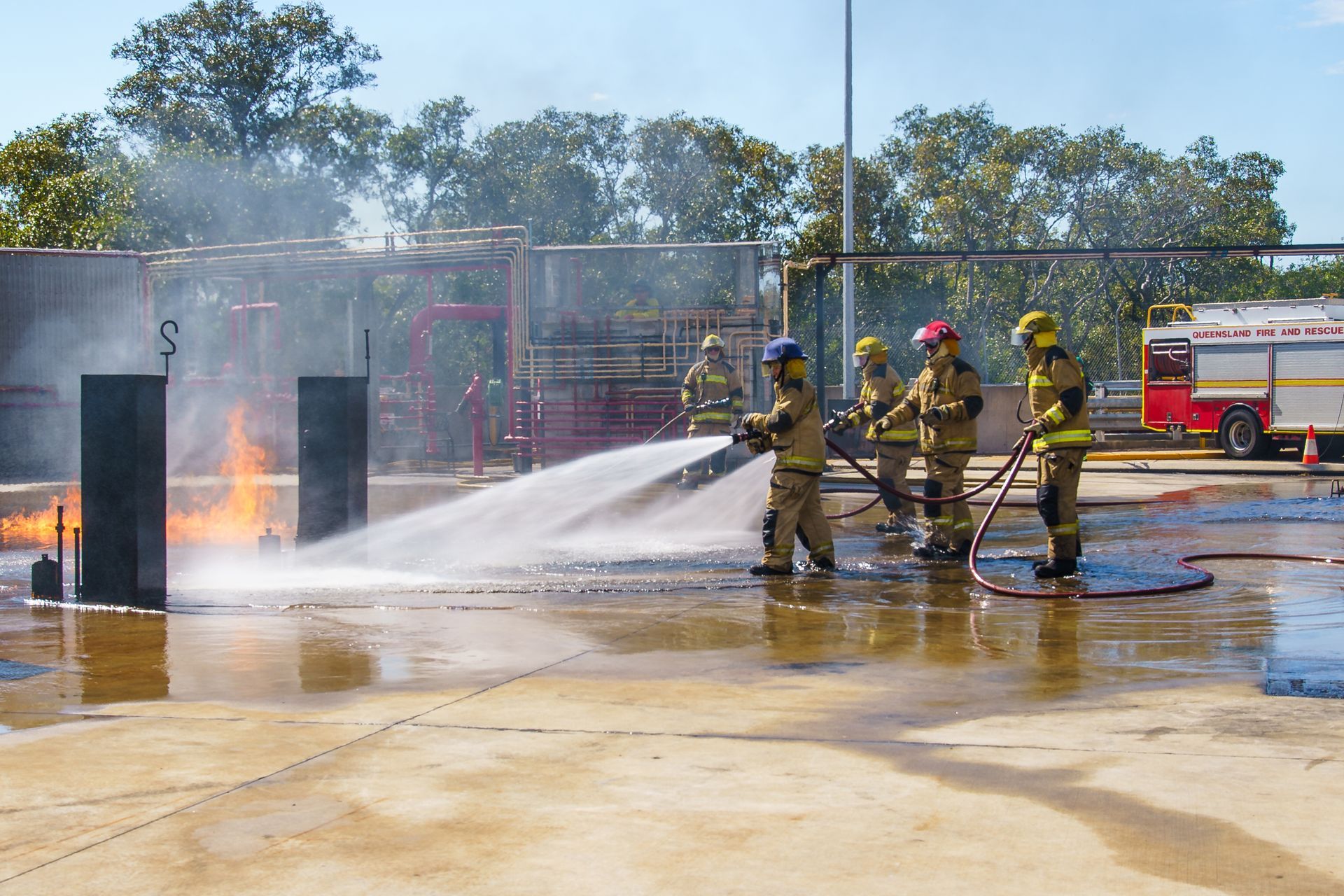 Describe the item or answer the question so that site visitors who are interested get more information. You can emphasize this text with bullets, italics or bold, and add links.
Describe the item or answer the question so that site visitors who are interested get more information. You can emphasize this text with bullets, italics or bold, and add links.2023 WAFA AWARDS
Describe the item or answer the question so that site visitors who are interested get more information. You can emphasize this text with bullets, italics or bold, and add links.Title or Question
Describe the item or answer the question so that site visitors who are interested get more information. You can emphasize this text with bullets, italics or bold, and add links.Title or Question
Describe the item or answer the question so that site visitors who are interested get more information. You can emphasize this text with bullets, italics or bold, and add links.
-
AFAC 2022
WAFA is happy to confirm we will be in attendance at the AFAC Conference in Adelaide this August. Visit us at the trade hall stand 133.
WAFA will also be partnering with SAMFS for the Professional Development Day on the 26th August.
-
AFAC 2021
Due to the constantly evolving Covid-19 pandemic, WAFA chose to work in partnership with AFAC for 2021. The conference was online and WAFA will had a virtual booth in the exhibition hall, as well as a presence on the exhibition stage.
WAFA hopes to return to the Biennial face to face conference format again in 2023.
-
WAFA 2018
The Women and Firefighting Australasia (WAFA) Conference 2018 was held from 26th — 28th of September 2018 in Wellington at the Te Papa Conference Centre.
REPORTS:
- WAFA 2018 Conference Report
- WAFA — QFES Workshop Evaluation Report
- WAFA — Outcomes Statement
- Full Outcomes Statement including methodology
WAFA AWARD WINNERS 2018
Congratulations to the winners of the 2018 WAFA Awards, as announced at the WAFA 2018 Gala Dinner:
Outstanding Female Firefighter:
Quinn Cramer, Station Officer, Queensland Fire and Emergency Services
Honourable mention to Nadia Rhodes, Australian Capital Territory Parks and Conservation Service
Youth Leadership:
Skye Bover-Groen, Cadet Unit Leader, Tara Emergency Services Cadet, Queensland Fire and Emergency Services
Honourable mention to Brittany Lea-Hewson, Rural Fire Service, Queensland Fire and Emergency Services
Male Champion:
Mike Wassing, Assistant Commissioner, Queensland Fire and Emergency Services
Honourable mention to Greg Browne, Captain Engadine Rural Fire Brigade, New South Wales Rural Fire Service
Member Organisation, Diversity, Fairness and Inclusion:
QFES Transforms through Leadership, Queensland Fire and Emergency Services
Honourable mention to #WAFAWednesday campaign, South Australian Metropolitan Fire Service
-
WAFA 2016
Stepping Up and Standing out
WAFA’s sixth biennial conference took place in Brisbane, co-located wtih the 2016 AFAC Conference, August 30 — September 2.
2016 AWARD WINNERS
Outstanding Contribution by a Female Firefighter: Donna Wheatley MFB
This award is designed to show the appreciation, dedication and congratulations to a woman working in the Fire and Emergency Services industry who has:
• demonstrated consistent leadership;
• encouraged and supported the development of women;
• been an inspirational role model;
• given selflessly of themselves in support of their community; or
• shown unwavering dedication to our industry.
Youth Leadership Award 2018: QFES
This award recognises a young woman (16−20 years) who is a volunteer in the fire and emergency services industry who has demonstrated strong and consistent leadership and a commitment to the safety of their community.
Male Champion Award: Michael Morgan- SAMFS &
Without our male colleagues supporting and encouraging us, our ability to influence the industry would be a lot harder. This award recognises a male champion within our industry who has:
• consistently mentored and coached women;
• created, provided and actively promoted a work environment that supports the inclusion of women; or
• consistently advocated for diversity and inclusion within their organisation or the industry as a whole.
Member Organisation ‘Diversity, Fairness and Inclusion’ award: South Australian Metropolitan Fire Service
WAFA recognises that all organisations are striving to be proactive in the Diversity and Inclusion space. This award recognises an organisation’s effort and dedication to diversity
and inclusion through programs and initiatives that have produced tangible results.
-
WAFA 2014
Women at the Fire Front : Innovation, Motivation & Inspiration
WAFA’s fifth biennial conference took place in Canberra on the 15th and 16th August 2014. The conference report is available here.
-
WAFA 2012
Achieving Success: Courage and Confidence Under FIre
WAFA's 2012 Conference took place in Adelaide on the 26th - 28th of July 2023. The conference website is available here.
-
WAFA 2010
Resurgence - Becoming Stronger
The 2010 WAFA Conference was held at the Sebel Heritage Yarra Valley from 22 – 24 July 2010.
The theme of the Conference was ‘Resurgence — Becoming Stronger’ and focussed on resilience and recovery from personal and professional life challenges.
-
WAFA 2006
Same but Different
Held in Sydney at the Sydney Convention Centre on the 7th - 9th June 2006.
Conference program available here.
-
WAFA 2005
NATIONAL WOMEN IN FIRE FIGHTING FORUM, 2005
Firing up Women, Key note address, Pru Goward Sex Discrimination Commissioner National Women in Fire Fighting Forum, Holiday Inn, Bourke Rd & O’Riordan Street, Sydney Airport, Mascot, Friday 13 May 2005
The first ever conference organised by Dr Merilyn Childs for the organisation then known as WIFF (Women in Firefighting).

